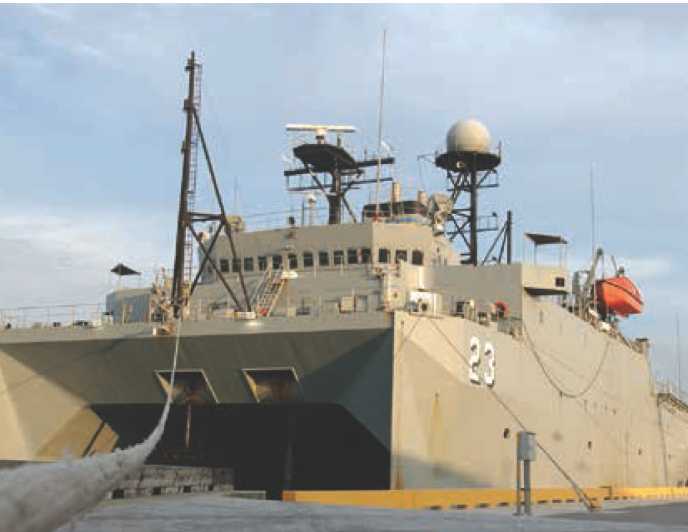
Status
Marine Corps initial operational capability (IOC) was declared in the second quarter FY 2016. Navy IOC is expected in the fourth quarter FY 2017.
Developers
HoodTech Hood River, Oregon
Insitu, Inc. Bingen, Washington
Northwest UAV Propulsion Systems Portland, Oregon
Quatro Composites Poway, California
* * * * * * * * * * * *

UQQ-2 Surveillance Towed Array Sensor System (SURTASS)
Description
The UQQ-2 Surveillance Towed Array Sensor System consists of a fleet of five ships that provide passive detection of nuclear and diesel-electric powered submarines, and real-time reporting to theater commanders and operational units. SURTASS employs the TL-29A twin-line acoustic towed array, which offers passive detection capability for undersea surveillance operations in both deep-ocean and shallow-water littoral environments using directional noise rejection and a bearing ambiguity resolution capability.
Status
Five SURTASS vessels are operational in the Pacific Fleet. All have TL-29A twin-line arrays and have been upgraded with the integrated common processor (ICP), which will result in increased operator proficiency, functionality, and savings in logistics support and software maintenance. Technical refreshes to ICP hardware will be installed to meet future requirements.
Developers
Lockheed Martin Manassas, Virginia
Syracuse, New York
* * * * * * * * * * * *

WQT-2 Surveillance Towed Array Sensor System (SURTASS) / Flow Frequency Active (LFA)
Description
The Flow Frequency Active system is the active adjunct to the Surveillance Towed Array Sensor System sonar system. LFA consists of a vertical source array with active transducers, power amplifiers, and an array-handling system. The LFA transmit array is deployed through a center well hatch of T-AGOS oceanographic survey ships. It uses the SURTASS passive array as the receiver and is capable of long-range detections of submarine and surface ship contacts. A mobile system, SURTASS LFA can be employed as a force-protection sensor wherever the force commander directs, including forward operating areas or in support of carrier strike group and amphibious ready group operations.
Status
One LFA array system is installed on board the USNS Impeccable (T-AGOS 23). The Compact LFA (CLFA) system, employing smaller and lighter sources, has been installed on the USNS Victorious (T-AGOS 19), USNS Able (T-AGOS 20), and USNS Effective (T-AGOS 21). Technical refreshes to the integrated common processor are installed to maintain increased operator proficiency and functionality.
Developers
BAE Systems Manchester, New Hampshire
Lockheed Martin Manassas, Virginia
* * * * * * * * * * * *
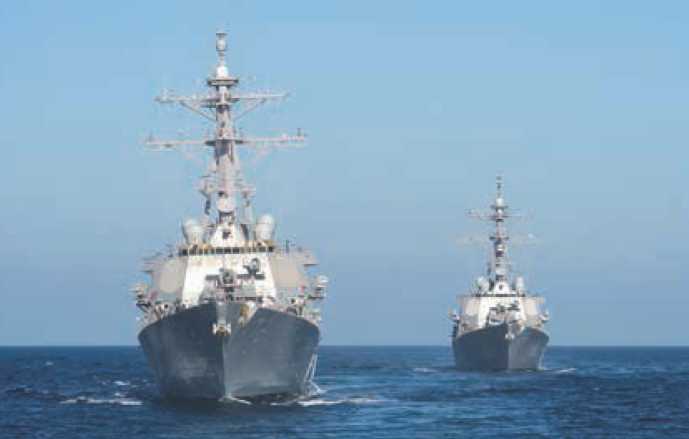
INTEGRATED FIRES
Advanced Tactical Data Link Systems (ATDLS)
Description
The ATDLS program provides tactical data link (TDL) command and control (C2) for U.S. forces, allies, and coalition partners in accordance with the Joint Tactical Data Enterprise Services Migration Plan (JTMP). ATDLS sustains and improves existing networks while developing future networks. Joint TDLs (Link-11, Link-16, and Link-22) include terminals, gateways, networks, and support initiatives that improve connectivity, interoperability, training, and support. Link-16 is the Department of Defense's (DoD) primary TDL implemented to most TDL-capable platforms and some munitions for specific applications. Link-22 is a multi-national development effort replacing Link-11 with a more suitable high-frequency protocol using a message format similar to Link-16. Terminals include the Joint Tactical Information Distribution System (JTIDS) and Multi-functional Information Distribution System (MIDS), which provide a Link-16 capability for C2 of aircraft, ships, and ground sites. Gateways include the Command and Control Processor (C2P), the Air Defense System Integrator (ADSI), and the Link Monitoring and Management Tool (LMMT).
MIDS-Flow Volume Terminal (MIDS-LVT): The MIDS-LVT is smaller and lighter than Joint Tactical Information Distribution System (JTIDS) terminals. The MIDS-LVT is managed by the MIDS International Program Office (IPO). The IPO is governed by a Steering Committee with a five-country program memorandum of understanding signed by France, Germany, Italy, Spain and the United States. More than 10,000 MIDS-LVTs are in use by the United States and more than 40 allies and partners.
MIDS Joint Tactical Radio System (JTRS): The MIDS JTRS terminal was built as a multi-channel, software-defined variant of MIDS-LVT, and includes Link-16 Enhanced Throughput (LET), Frequency Remapping (FR), and Crypto Modernization (CM). MIDS JTRS adds capacity for three waveforms in addition to Link-16. Command and Control Processor (C2P)/Common Data Link Management System (CDLMS) is a TDL communication processor associated with host combat systems, such as Aegis or the Ship Self-Defense System.
The in-service system (often called the Next-Generation C2P) provides extended-range capabilities and improved operator interfaces through an incremental approach for capability enhancements and technology refresh. C2P is adding Link-22 capability through its next major upgrade. ADSI is a time-sensitive tactical C2, commercial off-the-shelf system providing for processing and display of multiple TDL interfaces, data forwarding, and TDL information to the Global Command and Control System-Maritime (GCCS-M). LMMT is a network monitoring management and communications system to meet emerging maritime operations center (MOC) C2 multi-mission TDL requirements and address the shortcomings of existing systems, such as ADSI.
Status
JTIDS/MIDS on Ships (MOS): Planned updates to JTIDS/MOS terminals will satisfy National Security Agency (NSA) cryptographic modernization and DoD/Department of Transportation (DoT) frequency remapping mandates, with an initial operational capability (IOC) planned for FY 2018. Program management and acquisition authority for JTIDS/MOS is under the Link-16 Network Program.
DNM: Time Slot Reallocation (TSR) achieved IOC on ships in the C2P and JTIDS programs in FY 2007. TSR fielded on E-2C, EA-6B, and H-60 aircraft in FY 2009, and is scheduled to field on other joint platforms such as E-3 and E-8. DNM achieved Milestone C in 2014 and is scheduled for full-deployment decision review/IOC in FY 2017, and full operational capability (FOC) in FY 2018.
MIDS-LVT: Block Upgrade 2 (BU2) to MIDS-LVT, planned for completion in 2017-2018, will add three major features through retrofits to existing terminals. First, BU2 will include a LET mode that will increase data rates available to platforms from three to ten times the existing waveform capacity. Second, the built-in cryptography is being modernized to implement next-generation NSA algorithms, keys, and security features, including field-upgradability of crypto logic. Third, BU2 will implement FR to satisfy a DoD and DoT agreement to more easily share part of Link-16's radio spectrum with planned civil aviation systems by 2025. The maturity of the MIDS architecture makes it possible to implement these features without requiring changes to host platform interfaces and while maintaining interoperability with other Link-16 radios.
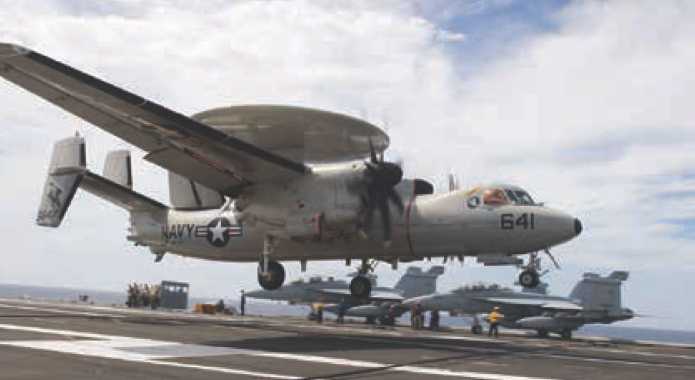
MIDS JTRS: The more modular design of MIDS JTRS has facilitated the rapid incorporation of new technology, such as Four Net Concurrent Multi-Netting (CMN-4) with Concurrent Contention Receive (CCR). CMN-4 consists of two capabilities, CMN and CCR, which dramatically expand the number of platforms and network-enabled systems that can be reliably included in a Link-16 network. These enhancements allow a single MIDS JTRS terminal to receive up to four messages (compared with just one today) within a single Link-16 time slot, allowing a user to "hear" messages from up to three additional sources at once. The fielding of this capability, planned for 2017, will support Naval Integrated Fire Control-Counter Air (NIFC-CA). The flexibility of the MIDS JTRS design has been demonstrated through the application of several capability enhancements, including the addition of a new waveform, Tactical Targeting Network Technology (TTNT), which is planned for fielding in 2021. MIDS JTRS will realize its multi-channel potential with the addition of TTNT, a high-bandwidth, flow-latency, internet protocol-capable waveform. The TTNT waveform augments existing Link-16 CMN-4 capability to provide increased capacity to support NIFC-CA and offensive anti-surface warfare mission capabilities.
C2P: C2P Legacy, C2P Rehost, and C2P Increment 1 have completed fielding and are in the operations and support phase. C2P Increment 2 achieved full rate production in July 2008 and will achieve full operational capability and transition to the operations and sustainment phase by FY 2016 as per the in-service shipboard architecture upgrade plan. C2P Increment 3 began development in FY 2013.
North Atlantic Treaty Organization Improved Link Eleven (NILE): NILE partner countries have fielded Link-22 in a limited number of ships and shore sites. Link-22 capability will be implemented in NGC2P as Increment 3, with development work having commenced in FY 2013 and IOC planned for FY 2019.
ADSI: ADSI Version 14 is in fielding in late 2016. ADSI Version 15 testing is complete and limited fielding commenced in FY 2014. The program intends to supplement/replace certain ADSI systems with the Link Monitoring and Management Tool capability.
Developers
Data Link Solutions Wayne, New Jersey
Northrop Grumman San Diego, California
Rockwell Collings Cedar Rapids, Iowa
ViaSat Carlsbad, California
* * * * * * * * * * * *

Cooperative Engagement Capability (CEC)
Description
Cooperative Engagement Capability provides improved battle force air-defense capabilities by integrating sensor data of each cooperating ship, aircraft and ground station into a single, real-time, fire-control-quality, composite track picture. CEC is a critical pillar of the Naval Integrated Fire Control-Counter Air (NIFC-CA) capability and provides a significant contribution to the Joint Integrated Fire Control (JIFC) operational architecture. CEC interfaces the weapons and sensor capabilities of each CEC-equipped ship and aircraft in the strike group, as well as ground mobile units in support of integrated engagement capability. By simultaneously distributing sensor data on airborne threats to each ship within a strike group, CEC extends the range at which a ship can engage hostile tracks to beyond the radar horizon, significantly improving area, local, and self-defense capabilities. CEC enables a strike group or joint task force to act as a single, geographically distributed combat system. CEC provides the Fleet with greater defense in-depth and the mutual support required to confront evolving anti-ship cruise missile and theater ballistic missile threats.
Status
The Defense Acquisition Board approved full-rate production for CEC shipboard and flow-rate initial production for E-2C Hawkeye airborne equipment in April 2002. In September 2003, the Defense Department approved FY 2004/2005 follow-on production for the USG-3 and full-rate production in April 2014 for the airborne version. There are 160 installations (76 ships, 52 aircraft, eight JLENS, ten USMC composite tracking networks, and 14 land-based test sites) as of August 2016. Total future CEC installation is planned for 283 ships, aircraft, and land units. Successful operational testing on the most recent CEC shipboard system was completed on board the USS Princeton (CG 59) in December 2015. Testing has commenced on the USS John Paul Jones (DDG 53) and is expected to be complete by late FY 2017. Live-fire NIFC-CA From-The-Sea testing is scheduled to continue with approximately one event every six-to-nine months through FY 2022.
Developers
Johns Hopkins University Applied
Physics Laboratory Laurel, Maryland
Raytheon Systems Company St. Petersburg, Florida
Sechan Electronics Inc. Lititz, Pennsylvania
* * * * * * * * * * * *
Distributed Common Ground System-Navy (DCGS-N)
Description
Distributed Common Ground System-Navy is the Navy component of the Department of Defense (DoD) DCGS family of systems. It is the Service's primary intelligence, surveillance, reconnaissance, and targeting (ISR&T) support system, and provides processing, exploitation, and dissemination services at the operational and tactical levels of war. DCGS-N operates at the secret and sensitive compartmented information (SCI) security levels. DCGS-N makes maximum use of commercial-off-the-shelf (COTS) and mature government-off-the-shelf (GOTS) hardware and software along with joint services software, tools, and standards to provide a scalable, modular, extensible multi-source capability that is interoperable with the other service and agency DCGS systems.
DCGS-N Increment 1 (Inc 1) replaces all legacy Joint Service Imagery Processing System-Navy and SCI Global Command and Control Maritime systems. The DCGS-N Inc 1 Block 2 capability will be hosted by Consolidated Afloat Networks and Enterprise Services and provide users with an integrated ISR suite.
DCGS-N Increment 2 (Inc 2) will provide an enterprise solution to fulfill specific capability gaps. This includes the ability to integrate and automate all-source fusion and analysis capabilities; enhance tasking, collection, processing, exploitation, and dissemination (TCPED) capabilities via automation of workflow processes; and sustain and enhance maritime domain awareness capabilities. Inc 2 will share information across commands, services, and agencies to improve situational awareness in accordance with emerging joint information environment and intelligence community information technology enterprise concepts. Inc 2 will be a robust, integrated ISR&T capability that is a scalable, modular, and extensible multi-source capability and interoperable with Navy and joint ISR, sensor and infrastructure capabilities. Ashore, DCGS-N Inc 2 will provide maritime operations centers and intelligence organizations the ability to collaborate in the exploitation, analysis, production, and dissemination of intelligence at the ashore enterprise node. The enterprise node will provide an all-source cross-cueing capability that improves the workflow automation for TCPED for Navy Intelligence analysts. Additionally, Inc 2 will provide all-source exploitation afloat and fuse organic TCPED with intelligence produced by strategic and theater intelligence production organizations to address time sensitive, dynamic tactical planning, and execution decisions afloat.
The Intelligence Carry-On Program (ICOP) fulfills fleet requirements and urgent operational needs for a subset of DCGS-N intelligence capabilities on Navy cruisers and destroyers. The ICOP suite includes an integrated 3-D operational display of intelligence and other data sources to provide a complete picture of the battlespace. The system supports a full-motion video receive, process, exploit, and disseminate capability as well as the ability to process and correlate electronic intelligence and communications externals. It integrates mature COTS and GOTS applications with shared storage and communication paths to reach back to the DCGS-N Enterprise Node and national ISR systems, making the tactical user a part of the larger ISR enterprise. The ICOP prototype received positive feedback from fleet users and won both the Department of Navy Acquisition Excellence Award for Technology Transition and the Office for Naval Research Rapid Technology Transition Achievement Award.
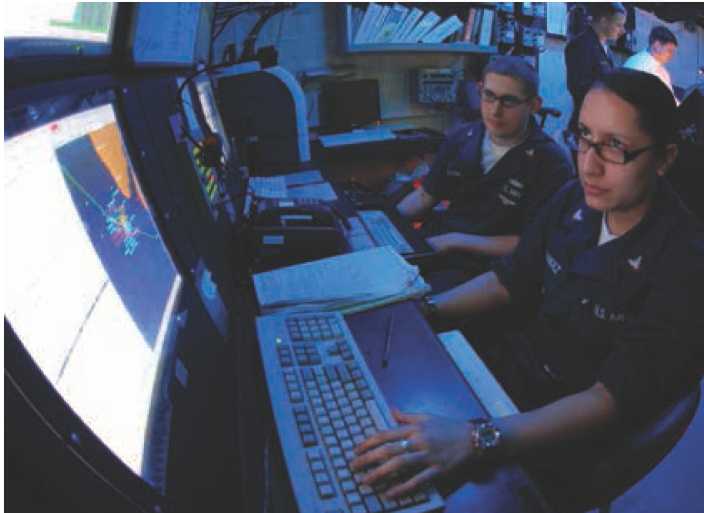
Status
The DCGS-N installation plan includes aircraft carriers, large-deck amphibious assault ships, fleet command ships, intelligence training centers, schoolhouse facilities, and shore-based numbered fleet maritime operations centers. Inc 1 fielded to its total inventory objective and achieved full operational capability in 2014. ICOP development began in FY 2014 with delivery commencing in FY 2015. Inc 2 is scheduled to reach initial operational capability in the second quarter FY 2021. Fleet Capability Release 1 (FCR-1) will field in FY 2018 and develops shore node infrastructure and core analytic tools. FCR-2 will deliver afloat capabilities in FY 2021.
Developers
BAE Systems Rancho Bernardo, California
* * * * * * * * * * * *
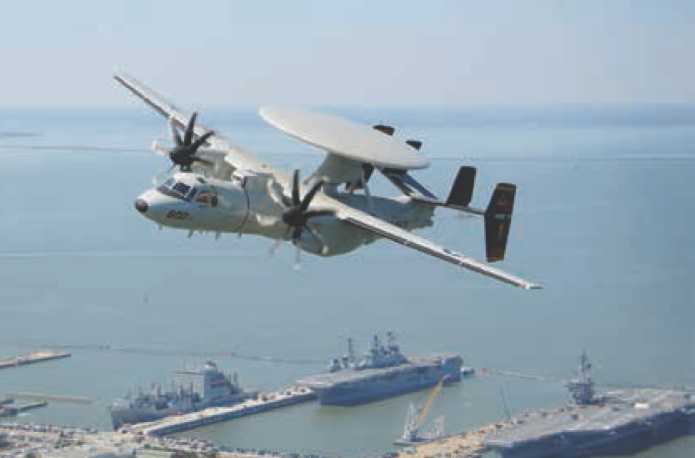
E-2C/D Hawkeye Airborne Early Warning Aircraft
Description
The E-2 Hawkeye is the Navy's airborne surveillance and battle management command and control platform, providing support of decisive power projection at sea and over land for the carrier strike group and joint force commanders. In addition to in-service capabilities, the E-2 has an extensive upgrade and development program to continue improving the capability of the aircraft.
The E-2C Hawkeye2000, with the APS-145 radar, features a mission computer upgrade (MCU), Cooperative Engagement Capability (CEC), improved electronic support measures, Link-16, global positioning system, and satellite data and voice capability. The MCU greatly improves weapons systems processing power, enabling incorporation of CEC. In turn, CEC-equipped Hawkeye 2000s significantly extend the engagement capability of air-defense warships. They are key to early cueing of the Aegis Weapons System, dramatically extending the lethal range of the surface-to-air Standard Missiles.
The E-2D Advanced Hawkeye, with the APY-9 radar, is a two-generation leap in radar performance from the E-2C, which brings an improved over-the-horizon, over-land, and littoral detection and tracking capability to the carrier strike group and joint force commanders. The APY-9, coupled with CEC, Link-16, and the Advanced Tactical Data Link, fully integrates the E-2D Advanced Hawkeye into the joint integrated air and missile-defense (IAMD) role. The APY-9's advanced detection and tracking capability, in conjunction with Aegis and the upgraded Standard Missiles, as well as the F/A-18 Hornet and its upgraded AIM-120 Advanced Medium Range Air-to-Air Missile, will allow strike groups to deploy an organic, theater-wide air and cruise missile defense capability to protect high-priority areas and U.S. and coalition forces ashore and afloat. The E-2D is the key enabler for the Naval Integrated Fire Control-Counter Air capability and will continue as the airborne "eyes" of the Fleet.
Status
As of August 2016, there were 43 E-2C aircraft in the Fleet, and 25 E-2Ds have been delivered. The Navy signed a 25-aircraft multi-year procurement contract on June 30, 2014 covering FY 2014 through FY 2018. The E-2D developmental test program and initial operational test and evaluation completed in October 2012 and reported the E-2D as effective and suitable. The first fleet squadron completed transitioning to the E-2D in January 2014, achieved initial operational capability in October 2014, and completed its first deployment in November 2015.
Developers
Lockheed Martin Syracuse, New York
Northrop Grumman Melbourne, Florida
St. Augustine, Florida
* * * * * * * * * * * *
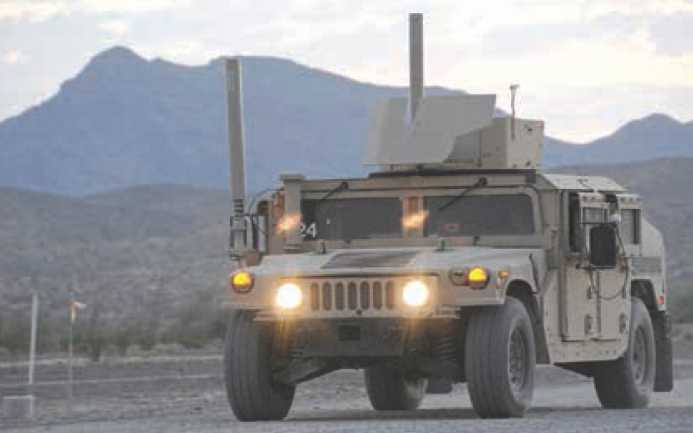
Joint Automated Deep Operations Coordination System (JADOCS)
Description
Joint Automated Deep Operations Coordination System is the principal tool for joint time-sensitive targeting (TST) and maritime dynamic targeting (MDT) collaboration, information sharing, targeting situational awareness plus command and control. JADOCS is an Army Acquisition Category III program of record with joint interest supporting TST/MDT fire-support management for Navy tactical and operational-level forces, targeting coordination, and common operational picture capabilities.
Status
JADOCS is pre-Milestone C with an acquisition decision memorandum approved by the Army in April 2013. JADOCS is delivered to the Navy as a software-only capability. JADOCS 1.0.5 is in the operations and sustainment phase, with the stand-up of a Navy project Office in FY 2014. JADOCS is tested within the Navy operational environment for fielding to force-level ships (e.g., aircraft carriers, amphibious assault ships, and command ships), maritime operations centers, and selected training sites. The Army is developing JADOCS 2.0 with additional capabilities that will be fielded to Navy sites in a Consolidated Afloat Networks and Enterprise Services environment.
Developers
Communications-Electronics Command Fort Sill, Oklahoma Raytheon Waltham, Massachusetts
* * * * * * * * * * * *

Mk XIIA, Mode 5 Identification Friend or Foe (IFF) Combat ID
Description
The Mk XIIA Mode 5 Identification Friend or Foe is a secure, real-time, cooperative "blue-force" combat Identification system designed to inform commanders' "Shoot/No-Shoot" decisions. Advanced technology, coding, and cryptographic techniques are incorporated into IFF Mode 5 to provide reliable, secure and improved performance. The Mode 5 waveform is defined in Standard NATO Agreement (STANAG) 4193 and is compatible with all U.S. and international civil IFF requirements. This Navy Acquisition Category II program is based on the improved Mk XII Cooperative IFF Operational Requirements Document dated April 27, 2001. Transponders will be installed on more than 3,000 ships and Navy/Marine Corps aircraft. Mode 5 interrogator equipment will be fielded on aviation ships, air-capable ships, and selected aircraft, including MH-60R Seahawk helicopters, E-2D Advanced Hawkeye, F/A-18C/D/E/F Hornet/Super Hornet and E/A-18G Growler. Mode 5 is a key enabler in the Joint Concept for Access and Maneuver in the Global Commons (JAM-GC, formerly the Air-Sea-Battle) concept, including Naval Integrated Fire Control-Counter Air, bringing the tactical advantage of cooperative target Identification.
Status
Navy initial operational capability and full-rate production were approved in 2012. Interoperability and valid IFF Mode 5 responses were demonstrated with E-2C, P-3C, MH-60R and UH-1Y aircraft, DDG 51-class destroyers, and CG 47-class cruisers during Bold Quest 13-01/Joint Operational Test Approach event 2 in June 2013. Operational testing of the combined interrogator/transponder on the F/A-18E/F and EA-18G aircraft completed in 2014. The program is on track to meet the operational requirements specified for joint full operational capability by 2020.
Developers
BAE Systems Greenlawn, New York
The Boeing Company St. Louis, Missouri
General Dynamics C4 Systems Scottsdale, Arizona
Northrop Grumman Woodland Hills, California
* * * * * * * * * * * *
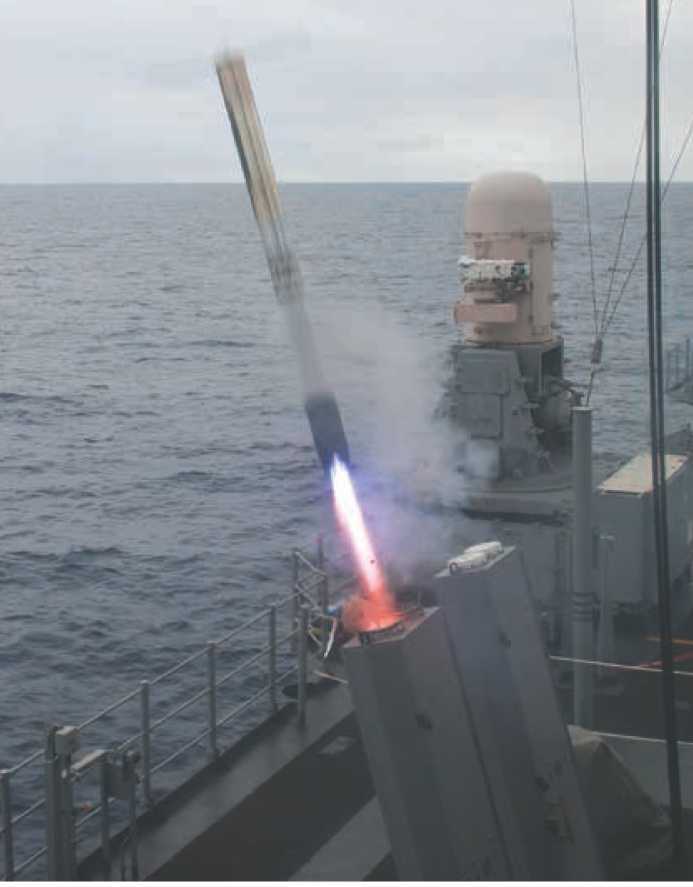
Nulka Radar Decoy System
Description
Nulka is an active, off-board, ship-launched decoy developed in cooperation with Australia to counter a wide spectrum of present and future radar-guided anti-ship cruise missiles (ASCMs). The Nulka decoy employs a broadband radio frequency repeater mounted on a hovering rocket platform. After launch, the Nulka decoy radiates a large, ship-like radar cross-section and lies a trajectory that seduces incoming ASCMs away from their intended targets. Australia developed the hovering rocket, launcher, and launcher interface unit. The Navy developed the electronic payload and fire control system. The in-service Mk 36 Decoy Launching System (DLS) has been modified to support Nulka decoys, and the mod is designated the Mk 53 DLS.
Status
Nulka received Milestone C approval for full-rate production in January 1999. Installation began on U.S. and Australian warships in September 1999. The system is installed on U.S. Coast Guard cutters and more than 120 U.S. Navy ships. Installation on aircraft carriers began in the fourth quarter of FY 2013. Additional installations will continue throughout FY 2017.
Developers
BAE Systems Edinburgh, Australia
Lockheed Martin Sippican Marion, Massachusetts
SECHAN Electronics Inc. Lititz, Pennsylvania
* * * * * * * * * * * *

SSQ-130 Ship Signal Exploitation Equipment (SSEE) Increment F
Description
The SSQ-130 SSEE Increment F is a shipboard combat systems suite that provides area commanders with automatic target acquisition, geo-location, and non-kinetic fires capabilities. SSEE Increment F incorporates counterintelligence, surveillance, and reconnaissance capabilities that improve situational awareness and enhances integrated fires. SSEE Increment F provides a standardized information operations weapon system across multiple naval platforms. SSEE uses modular commercial-off-the-shelf/ non-developmental technology, which allows the system to be easily reconfigured and respond rapidly to emergent tasking and evolving threats. SEEE's hardware and software are scalable and tailorable, enabling the rapid insertion of new and emerging technologies with minimal integration efforts. A modular SSEE Increment F small-footprint variant will further enable mission-specific configurations and rapid deployment of new technology. It will provide a permanent cryptologic capability for Flight I Arleigh Burke (DDG 51) guided missile destroyers and accelerate removal of SSEE Increment E from the Fleet.
Status
SSEE Increment F entered full-rate production in July 2011, and 77 units will be delivered by FY 2019, with full operational capability estimated for FY 2023. At the end of FY 2016, 46 units had been delivered and 26 units completely installed.
Developers
Argon-ST / The Boeing Company Fairfax, Virginia
* * * * * * * * * * * *
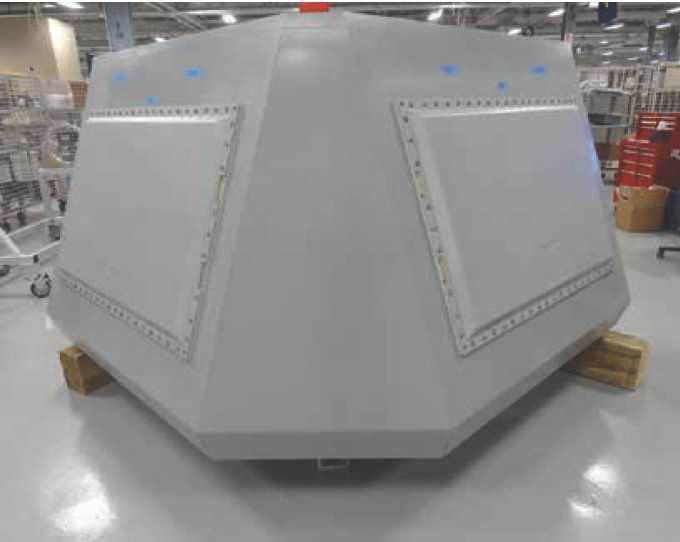
Surface Electronic Warfare Improvement Program (SEWIP)
Description
The Surface Electronic Warfare Improvement Program is an evolutionary development block upgrade program for the SLQ-32 electronic warfare system. Block 1A replaces the SLQ-32 processor with an electronic surveillance enhancement processor and the UYQ-70 display console. Block 1B also improves the human-machine interface of the SLQ-32 and adds specific emitter Identification capability that provides platform Identification. The high-gain, high-sensitivity receiver (Block 1B3) provides improved situational awareness through non-cooperative detection and Identification of platforms beyond the radar horizon. Block 2 provides improvements to the electronic support receiver. Upgrades to the antenna, receiver, and combat system interface allow the SLQ-32 system to pace new threats; improve signal detection, measurement accuracies, and classification; and mitigate electromagnetic interference. Block 3 will provide improvements for the electronic attack transmitter by providing integrated countermeasures against radio frequency-guided threats and extending frequency range coverage. SEWIP will also cue Nulka decoy launch.
Status
As of FY 2016, 181 SLQ-32 systems are installed on Navy aircraft carriers, surface combatants, and amphibious ships, and Coast Guard cutters. SEWIP was established as an Acquisition Category II program in July 2002 after cancellation of the Advanced Integrated Electronic Warfare System. The Navy awarded the SEWIP Block 2 development contract on September 30, 2009 and began delivery in 2014. Approximately 60 units are to be delivered within the future year's defense program. As of FY 2016, ten systems have been delivered with seven installed and three in the process of installation. SEWIP Block 3's advanced, active-Electronic Attack capabilities are in full development with a Milestone C decision in FY 2016. Block development completion and first procurement are expected in 2017, followed by first delivery in the 2018 timeframe.
Developers
General Dynamics Advanced
Information Systems Fairfax, Virginia
Lockheed Martin Eagan, Minnesota
Northrop Grumman PRB Systems Goleta, California
* * * * * * * * * * * *
UYQ-100 Undersea Warfare Decision Support System (USW-DSS)
Description
The Undersea Warfare Decision Support System (USW-DSS) enables the anti-submarine warfare (ASW) commander (ASWC) to plan, coordinate, establish, and maintain an undersea common tactical picture and execute tactical control. Employing net-centric decision-making tools in an open-architecture framework, it enables near-real-time sharing of key ASW tactical data and shortens the ASW kill chain. USW-DSS complements and interfaces with common operational picture (COP) systems such as Global Command and Control System-Maritime and Link-11/16. The SQQ-89 surface ship sonar system on cruisers and destroyers provides ship, sensor and track data to USW-DSS. The Tactical Support Center provides these data on board aircraft carriers. These data sources enable USW-DSS to generate a shared composite track picture for situational awareness. Integrated decision support tools provide the sea combat commander, theater ASW commander, and ASWC the ability to plan, conduct, and coordinate USW operations across all ASW platforms. USW-DSS provides highly detailed visualization, integrated platform sensor and distributed combat systems, reduced data entry, improved sensor performance predictions, and data fusion while reducing redundancy of USW tactical decision aids.
Status
USW-DSS Build 2 Release 3 (B2R3) completed initial operational test and evaluation (IOT&E) in FY 2013. As of late 2016, the Navy has delivered USW-DSS to 43 surface combatants, aircraft carriers, and shore commands. B2R3 fully leverages the Consolidated Afloat Networks and Enterprise Services (CANES) hardware and software-computing environment by installing as software-only on ships. Initial operating capability was fielded in the first quarter of FY 2010. A B2R3 software update commenced (as a result of the completed IOT&E) in FY 2015. B2R3 fielding is planned to continue through FY 2020 on a total of 107 ships and shore sites. USW-DSS Build 3 (B3) Fleet Capability Release (FCR 1) is currently in development and is scheduled for IOC ashore in the fourth quarter FY 2019. Developed with open, service oriented architecture and hosted on CANES, B3 will link to the Distributed Common Ground System Navy Increment 2 for "high-side" fusion and tactical-to-national integration of operational and intelligence information.
Developers
Adaptive Methods Inc. Centerville, Virginia
Naval Surface Warfare Center Division Carderock, Maryland
Naval Undersea Warfare Center Division Keyport, Washington
Progeny Systems Corporation Manassas, Virginia
* * * * * * * * * * * *
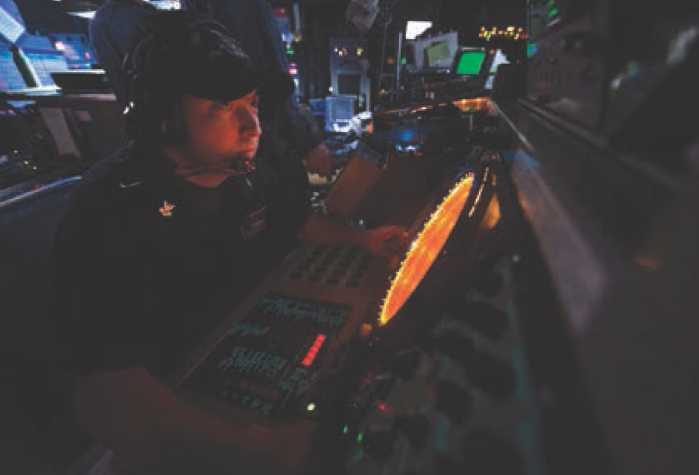
OCEANOGRAPHY AND MARITIME DOMAIN AWARENESS
Hazardous Weather Detection and Display Capability (HWDDC)
Description
Hazardous Weather Detection and Display Capability passively extract data from the tactical scans of the SPS-48(E) and SPS-48(G) 3-D air-search radars to generate weather situational awareness products in near real-time. Within the radar field, HWDDC indicates operational impacts from precipitation intensity, storm cell movement, atmospheric refractivity (which effects electromagnetic propagation), and wind speed and direction. This is the first capability of its kind and dramatically increases safety of flight and reduces risk to other shipboard operations, to include: small boat operations, amphibious maneuver, and deck evolutions (refueling or ordnance handling). Not only is the data used on board aircraft carriers and large-deck amphibious assault ships by Aerographers to support light deck operations and navigation, but it is shared to every squadron ready room and embarked staff by close-circuit TV. Information is shared with other ships in company and theater maritime operations center with maritime headquarters using SIPRNET (Secret Internet Protocol Router Network). Hourly data is also transmitted to Fleet Numerical Meteorological and Oceanographic Command, Monterey California where it is assimilated into Coupled Ocean/Atmosphere Mesoscale Prediction System numerical environmental models, increasing the accuracy of tactical meteorological predictions.
Status
Designated an Abbreviated Acquisition Program by the Space and Naval Warfare Systems Command PEO C4I (Command, Control, Communication, Computers, and Intelligence), HWDDC is installed on nine aircraft carriers and seven large-deck amphibious assault ships equipped with SPS-48(E) or SPS-48(G) air-search radars. HWDDC entered the Consolidated Afloat Networks Enterprise Services integration and testing in FY 2016, and full operational capability will be achieved when all aircraft carrier and amphibious assault platforms have received the SPS-48(G) upgrades. The Tactical Environmental Processor (TEP), which is a follow-on capability of HWDDC onboard destroyers equipped with the AN/SPY-1D(V) radars upgraded with a Multi-Mission Signal Processor, has been installed on the USS Arleigh Burke (DDG 51), USS Mitscher (DDG 57), and USS Milius (DDG 69), with two additional installs planned during FY 2017, nine in the future years defense program, up to 30 overall. Full operational capability will be achieved when all destroyers receiving the ACB12 and ACB16 modernization package have received TEP.
Developers
BCI Sensors Mt. Laurel, New Jersey
Space and Naval Warfare Systems Command, PEO (C4I) PMW-120 San Diego, California
* * * * * * * * * * * *
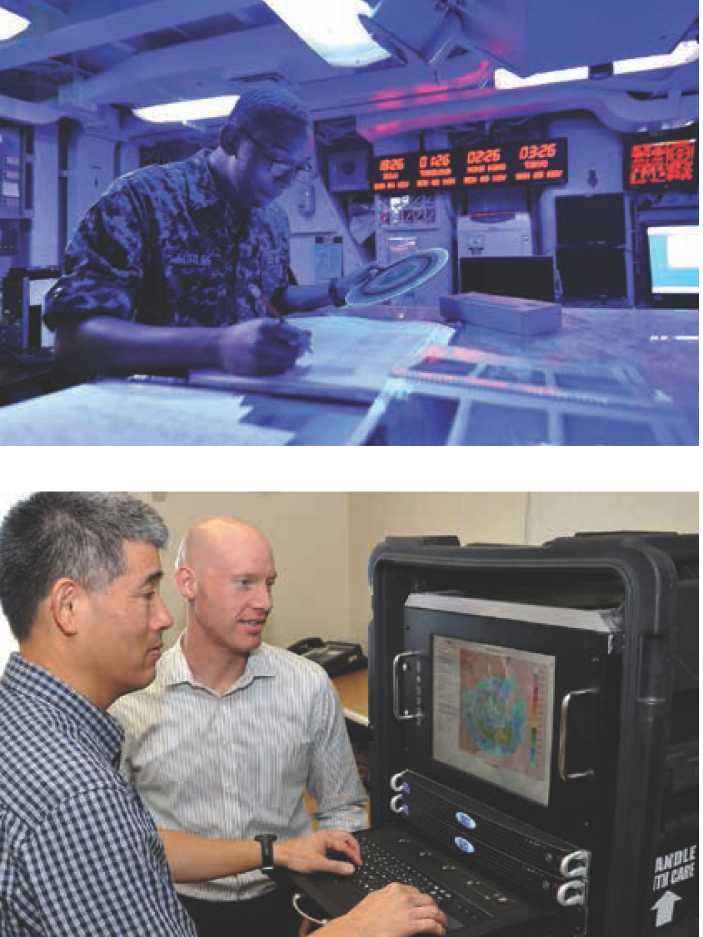
Littoral Battlespace Sensing-Unmanned Undersea Vehicles (LBS-UUV)
Description
The Littoral Battlespace Sensing-Unmanned Undersea Vehicle program provides a family of vehicles with a flow-observable, continuous capability to characterize ocean properties that influence sound and light propagation for acoustic and optical weapon and sensor performance predictions. Critical to realizing undersea dominance, the program has delivered buoyancy-driven undersea gliders (LBS-G); electrically powered, autonomous undersea vehicles (LBS-AUV) launched from Pathfinder (T-AGS 60)-class oceanographic survey vessels; and autonomous undersea vehicles (LBS-AUV(S)) launched from submarines. All three systems provide persistent battlespace awareness and enable anti-submarine, mine countermeasures, expeditionary, and naval special warfare planning and execution and persistent intelligence preparation of the environment (IPOE). The relevant information collected from this system is integrated at the Glider Operations Center into naval C4ISR (command, control, communication, computer, intelligence, surveillance, and reconnaissance) systems as part of the global information grid enterprise services. These systems are a force multiplier for the T-AGS oceanographic survey ships, further expanding collection capabilities in contested areas to ensure access and reduce risk in fleet operations.
Status
LBS-G reached full operational capability in July 2012, and by August 2016 the program had delivered 137 gliders to the Naval Oceanographic Office with 25 more undergoing government acceptance testing. LBS-AUV reached and obtained full operational capability in February 2015 and by May 2014 had delivered a total of five AUVs, including two engineering design models to the Naval Oceanographic Office; a total of seven vehicles will be delivered by FY 2017. Both LBS-G and LBS-AUV are conducting real-world ocean-sensing missions in overseas locations in support of anti-submarine warfare, mine warfare, and intelligence preparation of the operational environment (IPOE). LBS-AUV(S) will reach initial operational capability in FY 2019 and support the Submarine Force in conducting IPOE and other undersea warfare operations.
Developers
Hydroid, Inc. Pocasset, Massachusetts
Teledyne Brown Engineering Huntsville, Alabama
Teledyne Webb Research East Falmouth, Massachusetts
* * * * * * * * * * * *

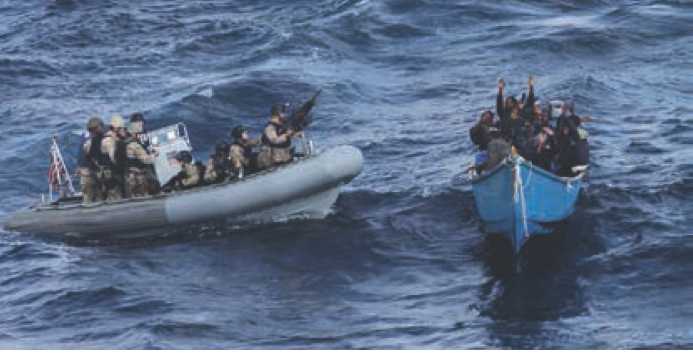
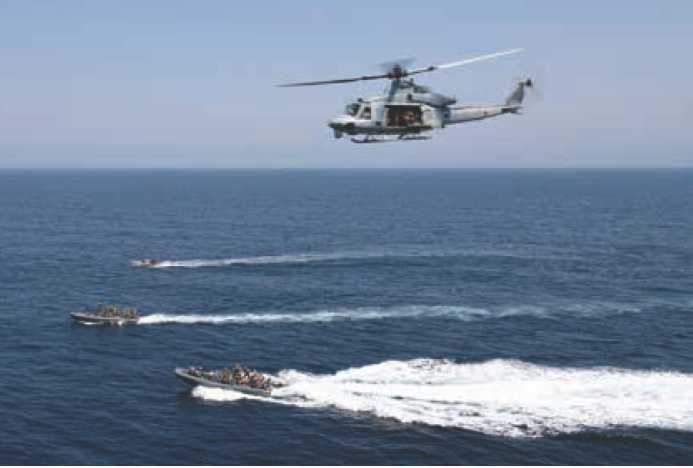
Maritime Domain Awareness (MDA)
Description
Maritime Domain Awareness (MDA) facilitates timely decision-making that enables early actions to neutralize threats to U.S. national security interests. MDA results from the discovery, collection, sharing, fusion, analysis, and dissemination of mission-relevant data, information, and intelligence in the context of maritime political, social, economic, and environmental trends within geographic regions. MDA requires a collaborative and comprehensive information and intelligence-sharing environment, working across international and agency borders. The Navy MDA Concept signed in July 2011 emphasizes Navy maritime operations centers as the focal point for efforts to improve Navy MDA, leveraging reach-back intelligence hubs for analytical support. The Navy's MDA concept complements the 2012 Presidential Policy Directive (PPD)-18 on Maritime Security, the 2013 National MDA Plan, which directs integration of all-source intelligence, law-enforcement information, and open-source data, and the 2015 DoD Strategic Plan for MDA that provides overarching guidance focusing on enterprise-wide unity of effort mitigating MDA capability gaps and long-standing challenges. Navy funding also supports MDA/intelligence focused analytic capabilities across the Naval Intelligence Enterprise (including at the Office of Naval Intelligence), and other Navy activities to close validated capability gaps. By addressing the maritime challenges our Nation and its partners currently face, and promoting further progress in identifying and addressing MDA challenges, MDA seeks to enable decision-makers by strengthening and enhancing the information sharing environment. MDA will accomplish this through the continued development of policies, enhanced situational awareness, intelligence integration, and information sharing and safeguarding capabilities to provide a maritime domain supporting prosperity and security within our domestic borders and around the world.
Status
In 2010, the Joint Requirements Oversight Council approved the MDA initial capabilities document, which identified 20 prioritized MDA capability gaps aimed at improving information access, analysis, and sharing to a wide range of interagency and international partners. For example, SeaVision is an unclassified, web-based maritime situational awareness tool that enables users to view, track, understand, and analyze vessel movements. SeaVision displays Automatic Identification System (AIS) data from the U.S. Department of Transportation's Volpe Center-developed Maritime Safety and Security Information System (MSSIS) network as well as other data sources, and ingests and displays a wide variety of maritime and geospatially referenced data. Future tools operating primarily at the classified—general services and sensitive compartmented information—levels will reside within Increment 2 of the Distributed Common Ground System-Navy program.
Developers
SPAWAR Systems Center San Diego, California
* * * * * * * * * * * *
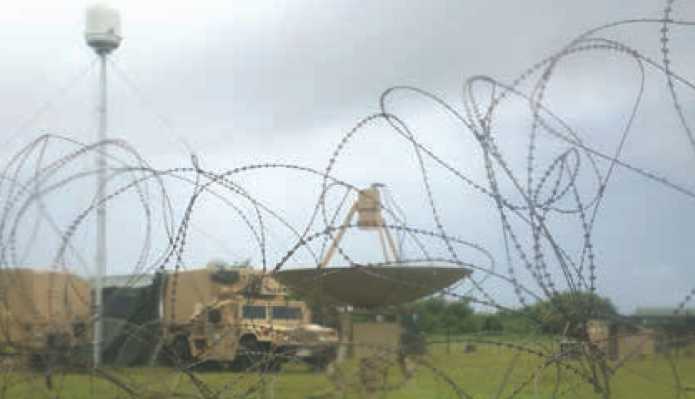
Meteorological Mobile Facility (Replacement) Next Generation [MetMF(R) NEXGEN]
Description
The TMQ-56 Meteorological Mobile Facility (Replacement) (MetMF(R)) Next-Generation environmental collection and forecast system provides meteorological and oceanographic (METOC) support to Marine Corps and joint forces. The main functions of the system are to collect and analyze data, predict the future environment, tailor METOC products and information, and mitigate the impact of and exploit the future environment. Following evolutionary acquisition, MetMF(R) NEXGEN is a replacement of the Meteorological Mobile Facility (Replacement) and provides greater mobility and operational flexibility in response to identified meteorological capability gaps. The required capabilities are defined in two operational requirements documents.
Status
Two MetMF(R) NEXGEN prototypes were developed and the capability production document was approved in July 2010. MetMF(R) NEXGEN passed its operational evaluation in September 2011, and was approved at Milestone C for full rate production in October 2011. MetMF(R) NEXGEN Officially met all requirements for initial operational capability in July 2013.
Developers
Smiths Detection Edgewood, Maryland
Space and Naval Warfare
Systems Command San Diego, California
* * * * * * * * * * * *
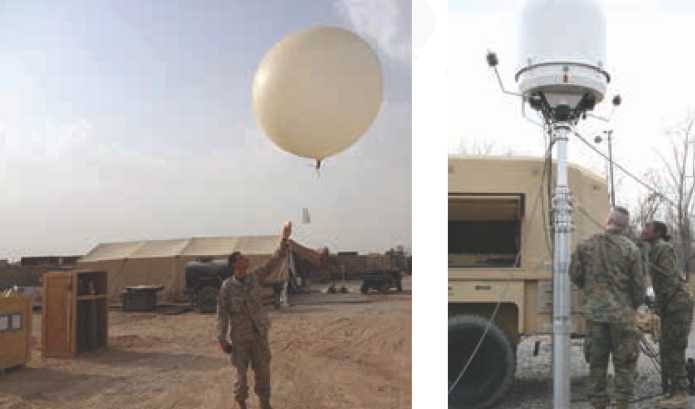
Naval Integrated Tactical Environmental System-Next Generation (NITES-Next)
Description
Naval Integrated Tactical Environmental System-Next Generation (NITES-Next) is a software-centric solution that leverages Consolidated Afloat Networks Enterprise Services infrastructure and services on force-level ships (e.g., aircraft carriers and large-deck amphibious assault ships) afloat, Amazon Web Services ashore, and a mobile variant for expeditionary warfare users. It is being developed to replace legacy meteorology and oceanography (METOC) capabilities in support of the Naval Meteorology and Oceanography Command's operating concept, fleet safety, integrated fires, and battlespace awareness. NITES-Next represents the core processing, exploitation, and dissemination tool of the METOC professional and provides a "one-stop shop" of tools and tactical decision aids required to generate decision products in support of full-spectrum naval operations. It is capable of consuming Open Geospatial Consortium (OGC)-compliant information and products, processed remotely sensed environmental information, as well as ocean and atmospheric models. Data are analyzed and fused with embedded tactical decision aids to expedite the METOC professional's forecasts of environmental conditions and impacts to fleet safety, weapons performance, sensor performance, and overall mission. NITES-Next is also capable of producing OGC-compliant products that can be shared/viewed on in-service and future Navy command and control systems—e.g., Command and Control Rapid Prototype Continuum, Maritime Tactical Command and Control, and Distributed Common Ground System-Navy—that will increase fleet-wide situational awareness.
Status
NITES-Next was designated an information technology streamlining pilot program in March 2012 and received a Fleet Capability Release (FCR)-1 build decision in May 2012. NITES-Next will be developed in five FCRs. Initial operational capability was achieved after successful operational test and evaluation of FCR-1 in February 2015. Full operational capability will be achieved in FY 2024 after FCR-5 is fielded.
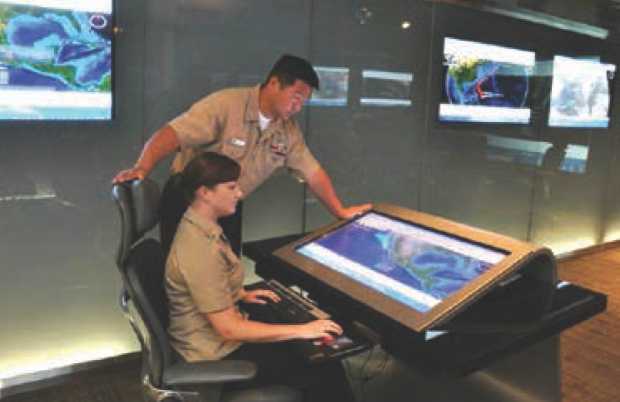
Developers
Forward Slope, Inc. San Diego, California
General Dynamics Information Technology San Diego, California
Space and Naval Warfare Systems Center, Pacific San Diego, California
Space and Naval Warfare Systems Command, PEO C4I and PMW-120 San Diego, California
* * * * * * * * * * * *

NAVSTAR Global Positioning System (GPS)
Description
The Navigation System using Timing and Ranging Global Positioning System (NAVSTAR GPS) program is a space-based, satellite radio navigation system that provides authorized users with "24/7," worldwide, all-weather, three-dimensional positioning, velocity, and precise time data. Navy responsibilities include the integration of GPS in 275 surface ships and submarines and more than 3,700 aircraft, integration of shipboard combat systems with the Navigation Sensor System Interface (NAVSSI) and the deployment of follow-on GPS-based Positioning, Navigation, and Timing Services (GPNTS) and anti-jam (A/J) protection for high-priority combat platforms through the navigation warfare (NAVWAR) program. NAVSSI is the in-service shipboard system that collects, processes, and disseminates position, velocity, and timing data to weapons systems, C4I (command, control, communication, computer, and intelligence), and combat-support systems on board surface warships. GPNTS will incorporate the next-generation of GPS receivers, initially the Selective Availability Anti-Spoofing Module (SAASM), to be followed by Military-Code (M-Code) receivers, to ensure that Navy ships can use the new GPS signals being broadcast from the latest GPS satellites. GPNTS also features A/J antennas and multiple atomic clocks to support assured position, navigation, and timing services. NAVWAR provides anti-jam antennas to protect air and sea naval platforms against GPS interference to ensure a continued high level of mission effectiveness in a GPS jamming environment. GPS plays a critical role not only in precise navigation, but also in providing precise time synchronization to precision-strike weapons, naval surface fire support systems, and ship C4I systems.
Status
All Navy platform GPS installations are complete. The Air NAVWAR program continues tests on suitable A/J antennas for Navy unmanned aerial vehicles such as Fire Scout. Installation of A/J antennas in F/A-18 E/F/G Super Hornet/Growler aircraft is ongoing with approximately 24 installs a year. Efforts to integrate GPS A/J antennas into E-2D Hawkeye aircraft and H-1 helicopters are ongoing. The Sea NAVWAR program is installing GPS A/J antennas on major surface combatants and the Navy's submarine force. The Navy is completing installation of NAVSSIs on select Navy surface combatants. Installation of NAVSSI will continue on new construction ships until GPNTS is approved for all baselines. The GPNTS program's next major event is Milestone C, scheduled for June 2017. GPNTS initial operational capability is expected in March 2020.
Developers
Boeing Military Aircraft St. Louis, Missouri
Litton Data Systems San Diego, California
Raytheon Los Angeles, California
Rockwell-Collins Cedar Rapids, Iowa
* * * * * * * * * * * *
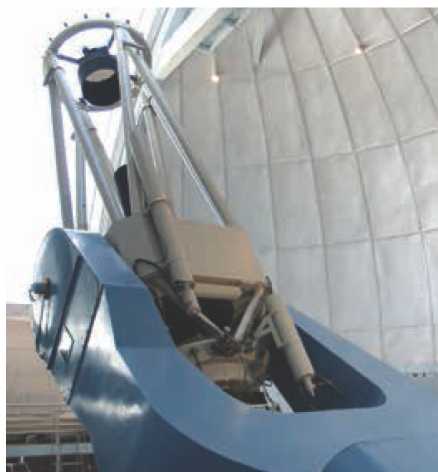
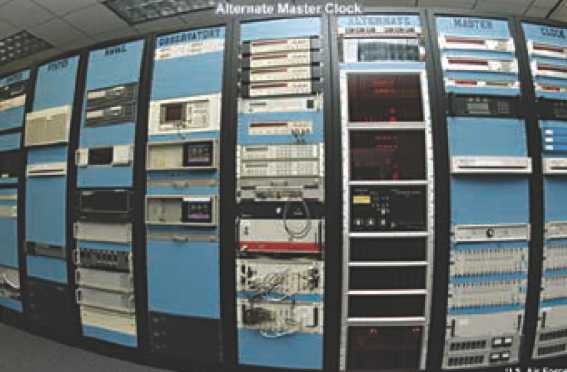
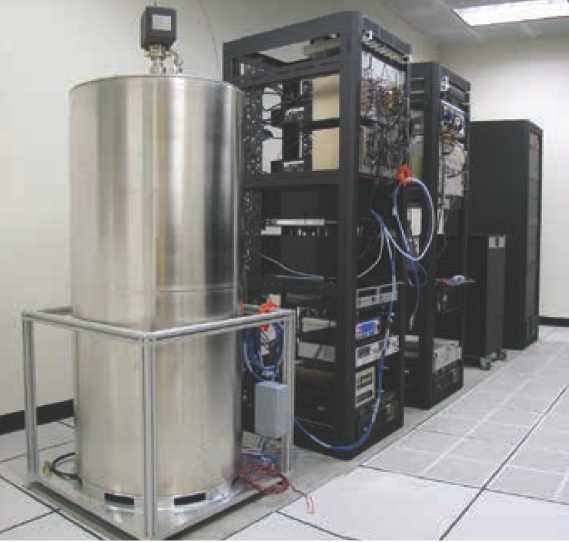
Precise Timing and Astrometry (PTA)
Description
The Navy Precise Timing and Astrometry program executes Department of Defense (DoD) tasking to develop, maintain, and assure precise timing and time interval services, earth orientation parameters, and the celestial reference frame for the DoD components. PTA is a critical component to the effective employment of a myriad DoD systems, including command and control, intelligence operations, network operations, and data fusion. It is essential to battlespace awareness, assured command and control, and integrated fires. Coordinated Universal Time as referenced to the U.S. Naval Observatory (UTC-USNO) is the DoD standard and the primary timing reference for the global positioning system (GPS) and numerous other military applications. The U.S. Naval Observatory (USNO) Master Clock, an ensemble of dozens of independent atomic clocks, is the most precise and accurate operational clock system in the world, and supports the stringent GPS III nanosecond timing precision requirement. The Navy, through USNO, also determines and predicts earth orientation parameters that are the time-varying alignment of the Earth's terrestrial reference frame to the celestial reference frame. USNO is the DoD lead for defining the celestial reference frame, which is the basis for the extremely precise and accurate positions and attitudes of positioning and targeting systems. PTA also supports relevant research conducted by USNO necessary to improve mission performance in clock development and time dissemination, determining and cataloging the positions and motions of celestial objects for the celestial reference frame, earth orientation parameters, and astronomical application production for navigation and operations.
Status
USNO's Navy Rubidium Fountain atomic clocks have met initial operational capability. Additional funding has been added toward a secure USNO network that is sustained through a program of record.
Developers
Naval Meteorology and Oceanography Command Stennis Space Center, Mississippi Navigator of the Navy Washington, D.C.
U.S. Naval Observatory Washington, D.C.
U.S. Naval Observatory Flagstaff Station Flagstaff, Arizona
* * * * * * * * * * * *
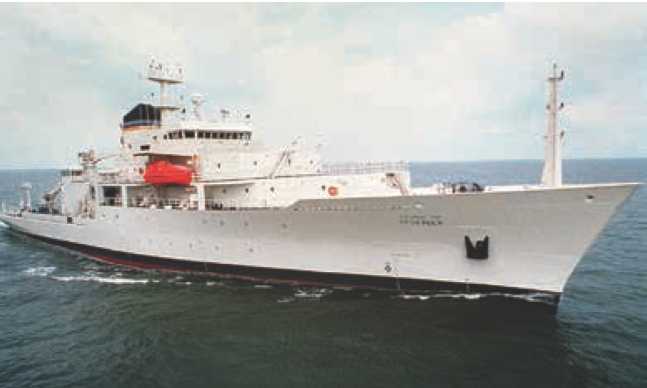
T-AGS Oceanographic Survey Ship
Description
The Pathfinder (T-AGS 60)-class oceanographic survey vessels comprise five 329-foot long, 5,000-ton vessels that provide multipurpose oceanographic capabilities in coastal and deep-ocean areas. Under the Military Survey restrictions of the United Nations Convention on the Law of the Sea, the T-AGS 60 represents an internationally recognized environmental information-collection capability that can operate within the exclusive economic zones of sovereign nations in support of DoD requirements without host-nation approval. Non-military ships conducting these collections may only do so with host-nation approval. T-AGS ships perform acoustic, biological, physical, and geophysical surveys, and gather data that provide much of DoD's information on the ocean environment as well as mapping the ocean floor to update nautical charts and promote safety of navigation. These data help to improve undersea warfare technology and enemy ship and submarine detection. The T-AGS ships are manned and operated for the Oceanographer of the Navy. Merchant mariner crews are provided by the Military Sealift Command, and the Naval Oceanographic Office provides mission scientists and technicians.
T-AGS 60-class ships are designed with a common-bus diesel-electric propulsion system consisting of twin-screw propellers driven through azimuth stern drive (Z-drives). The Z-drives, with 360-degree direction control, provide for precise and accurate position-keeping and track-line following. The Navy accepted delivery of the newest vessel to the T-AGS fleet, the USNS Maury (T-AGS 66), in FY 2016 to bring total T-AGS fleet to six vessels. A modified version of the Pathfinder-class vessels, the ship is named after Lieutenant Matthew Fontaine Maury, the father of modern oceanography and naval meteorology. T-AGS 66 is 24 feet longer than the in-service Pathfinder T-AGS vessels to accommodate the addition of an 18-foot by 18-foot inboard moon pool. The moon pool allows access to the water through the ship's hull for the deployment and retrieval of unmanned undersea vehicles. The increased ship length also provides 12 additional permanent berthing accommodations. As on previous T-AGS vessels, a hull-mounted mission system gondola will house the multi-beam sonar system.
Status
VT Halter Marine laid Maury's keel on February 1, 2011; the ship was christened and launched on March 27, 2013; the Navy accepted the ship in FY 2016; and final contract trials were scheduled for early FY 2017.
Developers
Naval Meteorology and Oceanography Command Stennis Space Center, Mississippi Oceanographer of the Navy Washington, D.C.
VT Halter Marine Pascagoula, Mississippi
* * * * * * * * * * * *
Task Force Climate Change (TFCC)
Description
Task Force Climate Change (TFCC) is supported by the Office of the Chief of Naval Operations (CNO) and the Office of Naval Research and engages with representatives from multiple governmental offices and staffs in an effort to gain a comprehensive and unambiguous understanding of the complex environment of the Arctic region and the impacts of climate change on naval readiness. TFCC's objective is to develop a comprehensive approach to guide future public, strategic, and policy discussions. The primary deliverable of TFCC is a holistic, chronological roadmap for future Navy action with respect to the Arctic that is synchronized with a science-based timeline, provides a framework for how the Navy discusses the Arctic, and includes a list of appropriate objectives tempered by fiscal realities. TFCC's subsequent focus will be other climate change implications, particularly the challenges associated with sea level rise and its effect on base infrastructure and mission readiness.
Status
Task Force Climate Change developed the initial Navy Arctic Roadmap in 2009 and released an update in 2014. Both roadmaps are signed by the CNO and are consistent with existing National, Joint, and Naval guidance, including National Security Presidential Directive-66 and Homeland Security Presidential Direc-tive-25, Department of Defense Arctic Strategy, Joint Vision 2020, a Cooperative Strategy for 21st Century Seapower (2015), and the 2016 Design for Maintaining Maritime Superiority. Both roadmaps provide plans of action with timelines intended to drive Navy policy, engagement, and investment decisions regarding the Arctic and global climate change, and the most recent release expands upon the previous roadmap's efforts and outlines actions needed in the near-term, mid-term, and far-term in order to balance potential investments with other Service priorities. Actions specified in the roadmap are underway, and TFCC provides regular updates to the CNO on their implementation status. Following the guidance in the 2014 Quadrennial Defense Review, the Navy's investments are focused on improvements in observation, prediction, and communication capabilities in high-latitude maritime regions, as well as vulnerability assessments, local sea level rise methodologies, and uncertainty management.
Developers
Chief of Naval Operations Staff Washington, D.C.
Naval Meteorology and Oceanography Command Stennis Space Center, Mississippi Office of Naval Research Arlington, Virginia
* * * * * * * * * * * *

Admiral Hyman Rickover, the "father" of the nuclear Navy, understood that "Bitter experience in war has taught the maxim that the art of war is the art of the logistically feasible." All of America's naval forces depend upon supply and logistics to carry out the full spectrum of operations to protect our citizens, interests, and friends. Naval logistics bridges the gap between land bases and depots and forces at sea. The Combat Logistics Force is critical to that capability, and, coupled with the Navy Energy Plan, undergirds the reach and persistence of forces for forward presence, sea control, power projection, and extended combat across the range of military operations.

Navy Electronic Procurement System (EPS)
Description
The Electronic Procurement System is the Department of the Navy (DoN) end-to-end contract writing system. It will provide the Navy and Marine Corps contracting community with a full contract writing management capability and facilitate integration with federally mandated systems, DoN financial systems, and industry. The EPS will replace existing legacy contracting systems and resolve existing challenges of outdated architecture, limited capabilities, and scalability concerns.
The EPS will span the DoN enterprise buying activities that include small procurements, major weapon systems acquisitions, research and development, military construction, grants, Service buys, and cooperative agreements. The EPS will maximize automation through standardized, data-driven contracting processes, from requirements inception through award, administration, payment, and final closeout. An Enterprise Service Bus (ESB) will serve as a hub to relay procurement data to various financial and reporting systems of record. The ESB will enable interoperability using Department of Defense (DoD) data exchange standards, such as the Procurement Data Standard and Purchase Request Data Standard.
The EPS implementation will result in auditable processes and a contracting workforce that issues accurate and timely contracts in standard formats that comply with applicable DoD and federal laws, regulations, and policies. Vendors will have a means of submitting electronic proposals, connected financial systems will be able to generate timely and accurate financial accounting data, and distribution and reporting of contracts and modifications will occur automatically.
Status
The EPS Program is a tailored pre-Acquisition Category (ACAT) IAM Defense Business System. The program anticipates request for proposal release in December 2016, and contract award in January 2018.
Developers
To be determined.
* * * * * * * * * * * *
Naval Operational Business Logistics Enterprise (NOBLE)
Description
Navy and Marine Corps operational forces require a comprehensive suite of maintenance, supply, and personnel administration capabilities to generate and sustain warfighter readiness. In late 2016 the Naval Tactical Command Support System (NTCSS) provides this information for all ships, submarines, aviation squadrons, expeditionary units, and other ashore operational sites. NTCSS however, is no longer capable of meeting fleet operating concepts and the in-service technical architecture is not fiscally supportable. NOBLE is the follow on to NTCSS.
The NOBLE family of programs comprises the Naval Operational Supply Systems (NOSS), Naval Aviation Maintenance System (NAMS), and Naval Maritime Operational Environment (NOME). Together, these systems will provide the required capabilities using an open architecture framework that incorporates business process reengineering allowing for the consolidation of more than 23 stand-alone application systems. These capabilities include enhanced situational awareness, planning, execution, and management of maintenance and supply logistics and business functions for a user base exceeding 150,000. The NOBLE family of programs will meet current and emerging demands for cyber, Financial Improvement and Audit Readiness, Navy logistics and maritime maintenance mission requirements. The NOBLE family of programs will deploy to Navy enterprise data centers ashore, the Consolidated Afloat Networks and Enterprise Services afloat, and Department of Navy commercial cloud computing environments.
Status
NOSS, NAMS, and NOME are in the pre-acquisition phase in late 2016, with an approved new start in FY 2018.
Developers
To be determined.
* * * * * * * * * * * *
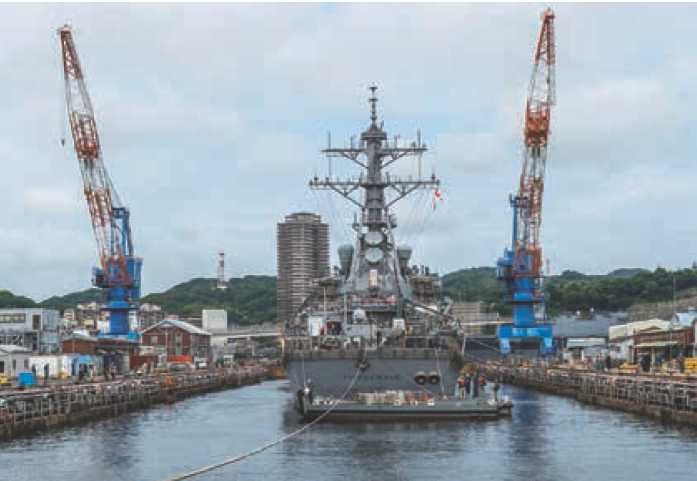
Naval Tactical Command Support System (NTCSS)
Description
The Naval Tactical Command Support System is the combat logistics support information system used by Navy and Marine Corps commanders to manage and assess unit and group material and personnel readiness. NTCSS provides intermediate and organizational maintenance, supply, and personnel administration management capabilities to aviation, surface, and sub-surface operational commanders. NTCSS also supports network-centric warfare by integrating logistics information to complement the tactical readiness picture for operational commanders. Business process improvements are developed and implemented under sponsorship of functional and fleet managers. Ongoing initiatives include:
• Migrating to an open service-oriented architecture
• Using Navy Enterprise Data Centers
• Converting Navy and Marine Corps aviation squadrons to an NTCSS Virtual Environment, significantly reducing hardware requirements
• Centralizing visibility of Navy assets (Operational Supply)
• Streamlining aviation maintenance repair operations (Beyond Capability Maintenance Interdiction and Global Individual Components Repair List management)
As a result, both the Navy and Marine Corps will realize greater operational efficiency and lower total ownership costs.
Status
NTCSS continues to be the warfighters' system to maintain fleet readiness. Full operational capability (FOC) at Naval Air Stations, Marine Corps air logistics squadrons, and on board ships and submarines occurred in FY 2009. An optimized NTCSS capability, targeted for aircraft squadrons, began full-rate production in FY 2007 and achieved FOC in the first quarter of FY 2012. The "tech refresh" to replace legacy NTCSS hardware/software and maintain compliance with Department of Defense/Department of the Navy Information Assurance and Baseline Reduction mandates completed in FY 2016. NTCSS will remain in sustainment through the future years defense program (FYDP). Naval Operational Business Logistics Enterprise (NOBLE) is the "umbrella" nomenclature for Naval Operational Supply Systems (NOSS), Naval Aviation Maintenance System (NAMS), and Naval Maritime Operational Environment (NOME), and will be in acquisition and development through the FYDP.
Developers
Advanced Enterprise Systems Norfolk, Virginia
CACI Norfolk, Virginia
* * * * * * * * * * * *

Navy Energy Program
Description
The Navy Energy Program addresses energy as a strategic resource that is essential to the successful execution of Navy afloat and ashore missions. Our goal is to increase operational capability and shore resilience by decreasing the Navy's reliance on petroleum, while increasing the use of alternative energy in our operations and in our facilities. The Navy Energy Strategy encompasses strategic investments in people, technology, and programs across the aviation, expeditionary, maritime, and shore enterprises. To increase combat readiness and mission success, the Navy continues to make significant progress by adjusting policies to enable more energy efficient operations, ingraining awareness and energy-conscious behavior, optimizing existing technologies to reduce energy consumption, and accelerating the implementation of new technologies.
We are cultivating a new generation of "energy warriors" through incentives and education. The incentivized energy conservation program encourages ships' crews to apply energy efficient procedures and operations, whether underway or in port, resulting in estimated energy cost avoidance of greater than 13 percent. With the fleet-wide launch of the aircraft energy conservation program in 2014, progress is being made towards optimizing fuel consumption on the Navy's 3,700 aircraft through procedural improvements such as short-cycle mission and recovery tanking and ground truck refueling.
Education and behavior change efforts extend from the classroom to shipboard and aircraft applications. The Naval Postgraduate School offers four master's degree programs and graduate certificates with an energy focus for Navy and Marine Corps personnel: Master of Science in Operational Analysis; Naval/Mechanical Engineering; Electronic Systems Engineering; and Financial Management. The General Military Training (GMT) for energy was successfully deployed in FY 2016 and provides Navy personnel with the key lessons about the importance of energy as a combat enabler and the knowledge to adopt energy-conserving behaviors within their commands.
The Navy's maritime efficiency initiatives seek to reduce shipboard energy demands for propulsion and electric power through a combination of passive, active, and actionable technologies. Passive technologies, such as stern laps, improve hydrodynamic flow and reduce drag, which reduces fuel consumption regardless of the ship's operating speed. Active technologies, such as the hybrid-electric propulsion system onboard several Amphibious Assault Ships, are used when operationally appropriate to deliver savings when the technology is in use. Actionable technologies, such as the shipboard energy dashboard, provide real-time situational awareness and feedback to ships' crews of energy demands associated with onboard equipment to enable optimized energy performance. The installation of the shipboard energy dashboard on board the USS Kidd (DDG 100) demonstrated energy savings of more than 92,000 kilowatt hours. In FY 2016, the Navy continued installation of solid state lighting upgrades across the surface fleet with expected savings of more than 400 barrels of fuel per ship per year and reduced maintenance hours compared to traditional fluorescent lighting.
Navy aircraft engine research is focused on new turbine engine configurations using innovative materials and processes. This will produce improved components needed to decrease fuel consumption as well as acquisition and maintenance costs, while increasing aircraft operational availability and performance. This includes developing new high-temperature metal alloys and inter-metallic materials for lighter and more heat-resistant turbine blades and disks, and thermal/environmental barrier coatings systems to improve component heat resistance to obtain greater fuel efficiency. Additionally, increased use of aviation simulators in continental U.S. flight training is helping pilots decrease fuel usage while increasing readiness.
Alternative fuel research remains a high priority in order to diversify energy supply options, which offers a strategic logistics supply advantage. To meet Department of Navy (DoN) requirements for alternative fuels to be interchangeable with and capable of being fully blended with petroleum without any changes to current aircraft or ship systems, Navy completed testing, qualification, and military specifications updates for JP-5, JP-8, and F-76 for the hydrotreated esters and fatty acids and Fischer-Tropsch pathways. Qualifying these fuels enables operational use by Navy aircraft and ships when they become available through the Defense Logistics Agency's fuel procurement process at costs competitive with conventional fuels.

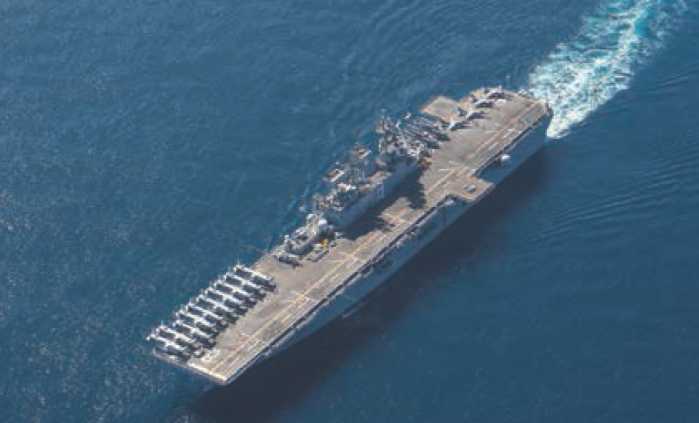
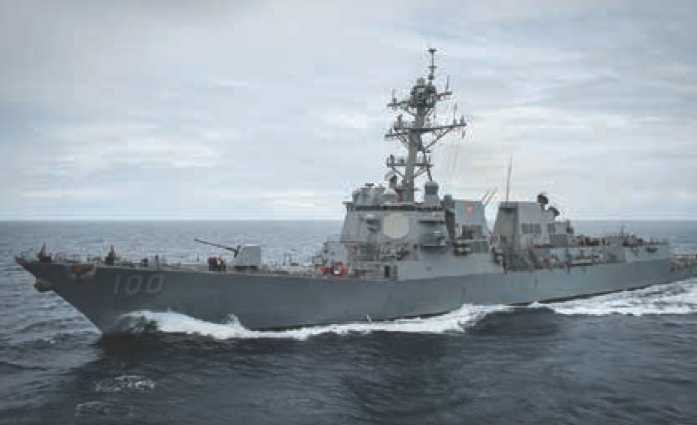
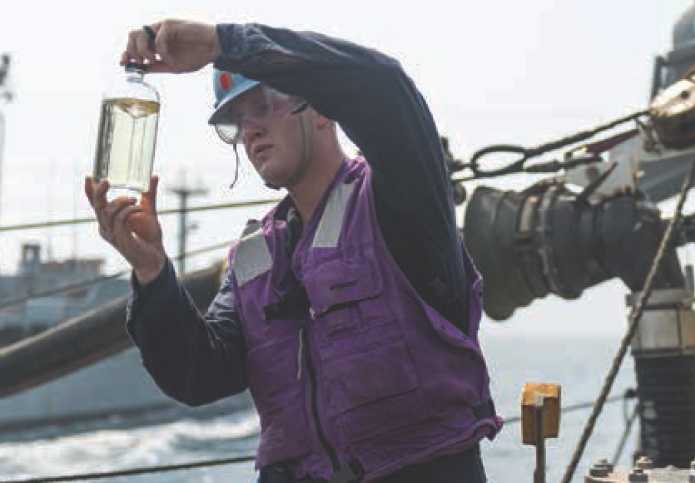

In January 2016, the Navy kicked off the Great Green Fleet (GGF) as one of the Secretary of Navy's five energy goals established in 2009. Through this keystone year-long event, Navy demonstrated its commitment to the use of alternative energy and the importance of energy efficiency as a combat capability enabler. The centerpiece of GGF was the deployment of the USS John C. Stennis (CVN 74) carrier strike group from San Diego with an accompaniment of ships steaming on advanced biofuel blends and employing energy-efficient technologies and best practices.
Ashore, the Navy continues to focus on increased efficiency with more than 70 percent of shore energy funding directed toward infrastructure and utility system upgrades. Navy has installed advanced meters to monitor energy consumption, has deployed alternative fuel vehicles to decrease the fuel consumption of the non-tactical vehicle fleet, and has established energy management systems to drive changes in culture and behavior. Renewable energy technologies are being implemented where viable. The Navy has a geothermal power plant at China Lake, wind power in the Bahamas and California, Landfill Gas-to-Energy in Hawaii, and solar-powered lighting and hot water heaters at installations across the world.
The DoN Renewable Energy Program Office (REPO) successfully implemented cost-effective, large-scale (defined as ten megawatt or greater) renewable energy projects that leveraged private sector financing for the production of renewable electricity. REPO also surpassed its goal to bring one gigawatt (GW) of renewable energy into procurement by the end of 2015. As of August 2016, the DoN had 150 megawatts (MW) of production capacity in operation, another 551 MW from projects with executed agreements in place, and 409 MW from other projects in procurement. The DoN will continue to support these projects through their planned initial operating dates in 2017 and 2018. The benefits of these projects went beyond increasing the diversity of the DoN's energy portfolio by increasing energy independence; potential energy savings to the DoN could total up to $400 million over the life of the contracts, and the DoN will receive $62 million in hardware upgrades via in-kind considerations. New areas of focus in 2017 and 2018 include identifying energy resiliency opportunities and enhancing energy security, such as battery storage, fuel cells, equipment electrification, and microgrids.
Status
The hybrid electric drive is on schedule for initial fielding and installation on two DDG-51 class ships in late 2016. Stern flaps are installed on all guided missile cruisers (CG) and destroyers (DDG), and certain amphibious ships (LHD, LPD, LSD). Energy dashboards have been installed on 21 DDGs and will be installed on an additional three DDGs in FY 2016 and five in FY 2017. Combustion trim loops are now installed on eight amphibious ships, including LHD 1-7, and LCC-19. Looking forward to FY 2018, the Navy's energy investment will maintain FY 2016 and FY 2017 operational and shore energy initiatives, including funds to address legislative requirements and tactical efforts that target energy efficiency, energy consumption reduction, and alternative fuel test and certification.
Developers
Naval Air Systems Command Patuxent River, Maryland
Naval Facilities Command Washington, District of Columbia Naval Postgraduate School Monterey, California
Naval Sea Systems Command Washington, District of Columbia Office of Naval Research Arlington, Virginia
* * * * * * * * * * * *
Navy Enterprise Resource Planning (Navy ERP)
Description
Navy ERP is the tool chosen to meet congressional mandates to establish and maintain federal financially compliant management systems, federal accounting standards, and U.S. Government General Ledger procedures at the transaction level. The Navy ERP foundation to achieve enterprise-wide business transformation is accomplished through two integrated releases: the Financial/Acquisition Solution and the Single Supply Solution. In October 2008, the Assistant Secretary of the Navy (Financial Management and Comptroller) designated Navy ERP the Navy's Financial System of Record for all the major acquisition systems commands, including Naval Air Systems Command, Naval Supply Systems Command (NAVSUP), Space and Naval Warfare Systems Command, Naval Sea Systems Command, Office of Naval Research, and Strategic Systems Programs.
Status
The Navy has overcome a broad range of challenges to successfully deploy financial, acquisition, supply chain, and workforce management capabilities to up to 72,000 users. Navy ERP is used to manage $69 billion of the Navy's total obligation authority annually. Navy ERP has deployed the single supply solution covering all of Navy's Material Groups to the NAVSUP Headquarters, field activities, fleet logistic centers and partner sites. The program completed deployments in FY 2013 and entered sustainment in FY 2014. As of FY 2016, Navy ERP has supported the schedule of budgetary activity audits and Department of Defense Inspector General inquiries. This will require Navy ERP's continued participation in data collection activities, audit finding remediation, and adherence to risk management framework and financial compliance requirements.
Developers
SAP America, Inc. Newtown Square, Pennsylvania
* * * * * * * * * * * *
T-AH 19 Mercy-Class Hospital Ship
Description
The Navy's two Mercy-class hospital ships—the USNS Mercy (T-AH 19) and USNS Comfort (T-AH 20)—are national strategic assets employed in support of combatant commander (COCOM) requirements. Hospital ships provide a mobile, highly capable medical facility and are configured and equipped to meet their primary mission as a large-scale trauma center for combat operations. Each ship has 12 operating rooms and up to 1,000 beds (100 acute care, 400 intermediate care, and 500 minor care). As powerful enablers of stability, security, and reconstruction efforts around the globe, hospital ships serve as cornerstones for peacetime shaping operations. Hospital ships provide a highly visible, engaged, and reassuring presence when deployed for theater security cooperation (TSC) or when called to respond to humanitarian-assistance or disaster-relief missions. Assigned to the Military Sealift Command (MSC), these ships are maintained in a reduced operating status (ROS) when not required for scheduled mission tasking or emergent COCOM requests. Generally, one hospital ship is scheduled for a 120-150 day TSC deployment per year. The MSC performs periodic maintenance to ensure both ships can meet full operational capability within a few days following activation from ROS. A civilian mariner crew, with military medical staff augmentation when activated, mans these ships.


Status
Comfort (homeported in Norfolk, Virginia) has an expected service life to 2021. The Navy has programmed service-life extension maintenance that will extend Mercy's (homeported in San Diego, California) service life to 2036.
Developers
National Steel and
Shipbuilding Company San Diego, California
* * * * * * * * * * * *
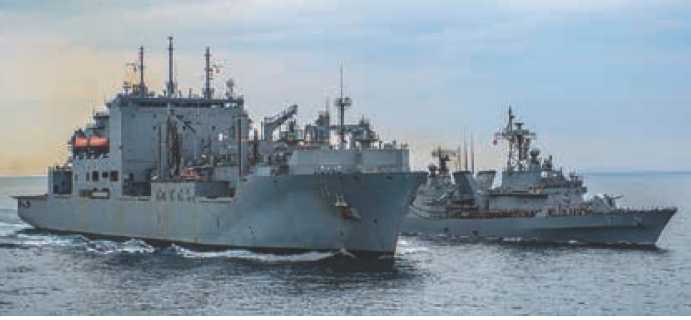
T-AKE 1 Lewis and Clark-Class Dry Cargo and Ammunition Ship
Description
The Navy has 12 Lewis and Clark (T-AKE 1)-class dry cargo and ammunition ships in the combat logistics force (CLF). Assigned to the Military Sealift Command, the T-AKEs are built to commercial standards and are manned by civilian mariners. Along with the T-AOs, they form the foundation of the Navy's ability to project power ashore. They provide the dry cargo and ammunition necessary to enable Navy carrier strike groups and amphibious ready groups to operate worldwide without the need to constantly return to port for supplies. Additionally, they have a limited capacity for providing fuel to support dispersed surface action groups. T-AKEs have large, easily reconfigurable cargo holds to support delivery of a variety of cargo, including refrigerated, frozen, dry cargo and ammunition. The T-AKEs replaced three previous classes of fleet auxiliaries with a single hull form. A Navy aviation detachment or contracted commercial equivalent embarked on board provides vertical-replenishment capability.
Status
Twelve T-AKEs support the CLF and two T-AKEs support maritime prepositioning force program requirements. The final ship in the class—the USNS Cesar Chavez (T-AKE 14)—delivered in October 2012.
Developers
National Steel and Shipbuilding Company San Diego, California
* * * * * * * * * * * *
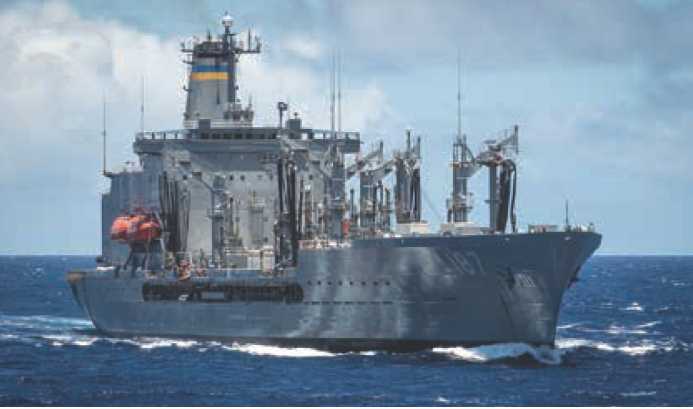
T-AO 187 Kaiser-Class and T-AO(X) Replenishment Oiler
Description
The Navy has 15 Henry J. Kaiser-class fleet replenishment oilers in the combat logistics force. Assigned to the Military Sealift Command, the T-AOs are built to commercial standards and are manned by civilian mariners. Along with the T-AKE, they form the foundation of the Navy's ability to project power ashore. They provide the fuel and dry cargo necessary to enable Navy carrier strike groups and amphibious ready groups to operate worldwide without the need to constantly return to port for supplies. The T-AO primarily provides bulk petroleum (diesel fuel marine and JP5 jet fuel) to forces afloat. Additionally, they have a limited capacity for providing dry stores and refrigerated cargo. The John Lewis (T-AO 205)-class fleet replenishment oiler is the Navy's next-generation oiler, featuring increased dry and refrigerated cargo capacity compared to the T-AO 187 class. The ships will be double-hulled to comply with the Oil Pollution Act of 1990 standards. They are scheduled to replace the in-service Kaiser class T-AOs and the Supply-class T-AOEs when they reach the ends of their expected service lives beginning in 2021.
Status
On 30 June 2016, the Navy awarded the National Steel and Shipbuilding Company a contract for the first six T-AO 205-class ships. Seventeen T-AO 205s are planned, with delivery of the first ship in FY 2020.
Developers
To be determined.
* * * * * * * * * * * *
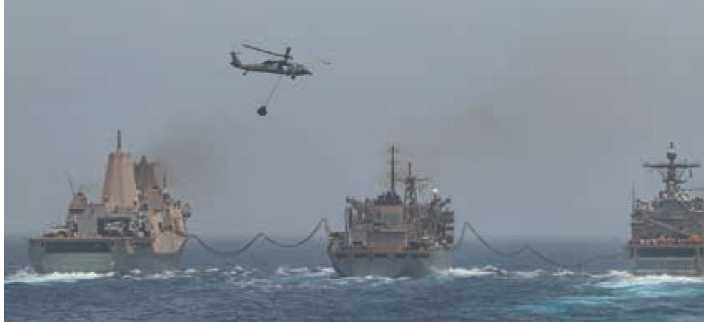
T-AOE 6 Supply-Class Fast Combat Support Ship
Description
The Navy has two Supply (T-AOE 6)-class fast combat support ships in the combat logistics force. Assigned to the Military Sealift Command they are manned by civilian mariners. Capable of maintaining higher sustained speeds than other Navy replenishment ships and carrying the full spectrum of afloat replenishment requirements (fuel, ordnance, and dry cargo), these ships provide "one-stop shopping" to carrier strike groups and amphibious ready groups. Working in concert with Lewis and Clark (T-AKE 1)-class dry cargo and ammunition ships, as well as the in-service Kaiser (T-AO 187)-class and new John Lewis (T-AO 205)-class fleet replenishment oilers, the T-AOE is a key enabler of the Navy's ability to project power ashore through replenishment at sea. A Navy aviation detachment is embarked to provide vertical-replenishment capability.
Status
The USNS Bridge (T-AOE 10) was inactivated in FY 2014, and the USNS Rainier (T-AOE 7) was inactivated in FY 2016. The two remaining T-AOEs, USNS Supply (T-AOE 6) and USNS Arctic (T-AOE 8), have expected service lives to 2034 and 2035, respectively.
Developers
National Steel and Shipbuilding Company San Diego, California
* * * * * * * * * * * *
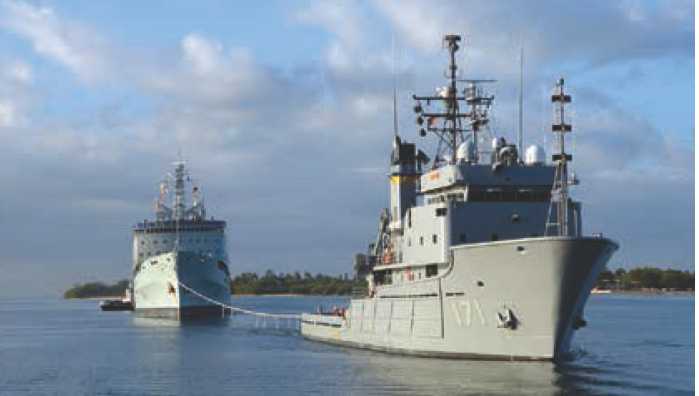
T-ATS(X) Towing, Salvage and Rescue Ship
Description
The Navy has four Powhatan (T-ATF 168)-class fleet ocean tugs and four Safeguard (T-ARS 50)-class salvage ships to support towing, salvage, diving, and submarine rescue operations. These ships are reaching the ends of their service lives and require recapitalization. Due to changes in technology, the latest diving and submarine rescue systems are now modularized and can be embarked upon a variety of ships that meet certain minimum requirements. A dedicated purpose-built salvage and rescue ship is no longer required, and the T-ATF and T-ARS ships will be replaced with a single common-hull towing, salvage and rescue ship, T-ATS(X). The T-ATS(X) will be built to commercial standards and will be manned by civilian mariners and operated by the Military Sealift Command. They will be able to support Navy towing, salvage, diving and rescue missions.
Status
Two T-ARS and one T-ATF will be inactivated in FY 2017. Contract award for the first T-ATS(X) is expected in the summer 2017, with delivery of the first ship in FY 2020. Eight T-ATS(X)s are planned.
Developers
To be determined.
* * * * * * * * * * * *

T-EPF 1 Spearhead-Class Expeditionary Fast Transport (formerly Joint High-Speed Vessel)
Description
The Expeditionary Fast Transport is a high-speed, shallow-draft surface vessel with an expansive open mission bay and ample reserve power and ships services capacity. Manned by Military Sealift Command civilian mariners, EPFs provide a persistent deployed presence in operational theaters around the world. Capable of speeds in excess of 35 knots and ranges of 1,200 nautical miles fully loaded, the EPF's shallow-draft allows it to operate effectively in littoral areas and small, austere ports. FY 2017 will see the continued deployments of EPFs, providing increased opportunities to integrate these new, highly adaptable platforms into the Fleet and evaluate the many ways the Navy can employ the vessels' unique combination of persistent forward presence, flexible payload capacity, and speed.
Status
The Navy will acquire 12 EPFs, seven of which have been delivered as of mid-2016 with the remaining five programmed to be delivered from FY 2017 through FY 2020. The USNS Spearhead
(T-EPF 1) delivered in October 2012 and was ready for fleet tasking in November 2013. The USNS Choctaw County (T-EPF 2) delivered in June 2013 and was ready for fleet tasking in July 2014. The USNS Millinocket (T-EPF 3) delivered to the Navy in March 2014 and was ready for fleet tasking in April 2015. The USNS Fall River (T-EPF 4) delivered in September 2014 and was ready for fleet tasking in August 2015. USNS Trenton (T-EPF 5) was delivered in April 2015 and was ready for fleet tasking in March 2016. USNS Brunswick (T-EPF 6) was delivered in January 2016 and will be ready for fleet tasking in October 2016. USNS Carson City (T-EPF 7) was delivered in June 2016 and will be ready for fleet tasking in July 2017. USNS Yuma (T-EPF 8) is programmed to be delivered in January 2017, and the USNS Bismarck (T-EPF 9) is programmed to be delivered in July 2017. The other ship in the class is USNS Burlington (T-EPF 10). T-EPF 11 and T-EPF 12 have not been named.
Developers
Austal USA Mobile, Alabama
* * * * * * * * * * * *
Naval science and technology (S&T) is our "insurance policy" enabling the Navy and Marine Corps to stay ahead of any competitor. Focused in the Office of Naval Research, the S&T program—from the seabed to the stars—includes electromagnetic railguns and solid-state lasers, exotic materials, and command and control in contested environments. Critically important to meeting far-future requirements only dimly perceived in 2017, Navy S&T nurtures the next generation of scientists and researchers through numerous STEM—Science, Technology, Engineering, and Mathematics—initiatives. S&T supports projects with potentially big payoffs, while mindful of the need for affordability.
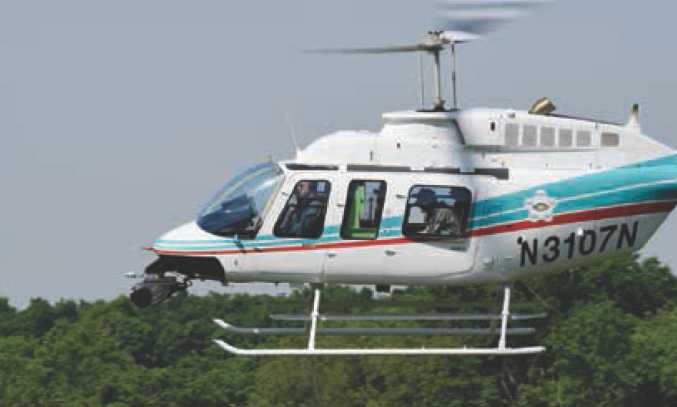
SCIENCE AND TECHNOLOGY
Autonomous Aerial Cargo/Utility System (AACUS)
Description
The Office of Naval Research (ONR) Autonomous Aerial Cargo/ Utility System Innovative Naval Prototype explores advanced autonomous rotary-wing capabilities for reliable resupply/retrograde missions. Key features of the AACUS include a vehicle autonomously avoiding obstacles while finding and landing at an unprepared landing site, operated by a field individual possessing no special training. AACUS represents a substantial leap forward compared to present-day operations as well as other more near-term Cargo Unmanned Aerial Systems (CUASs) development programs. AACUS focuses on autonomous obstacle avoidance and unprepared landing site selection, with precision-landing capabilities that include contingency management until the point of landing. AACUS includes a control component such that any field personnel can request and negotiate a desired landing site. Moreover, AACUS will communicate with ground personnel for seamless and safe loading and unloading. The program embraces an open-architecture approach for global management of mission planning data, making AACUS technologies platform-agnostic and transferable to new platforms as well as the existing CUASs. AACUS-enabled CUASs will rapidly respond to requests for support in degraded weather conditions, launch, fly to, and autonomously detect and negotiate precision-landing sites in potentially hostile settings.
Status
The Autonomous Aerial Cargo/Utility System is an ONR Innovative Naval Prototype program with a FY 2012 start, sponsored through ONR's Office of Technology.
Developers
Office of Naval Research Arlington, Virginia
* * * * * * * * * * * *
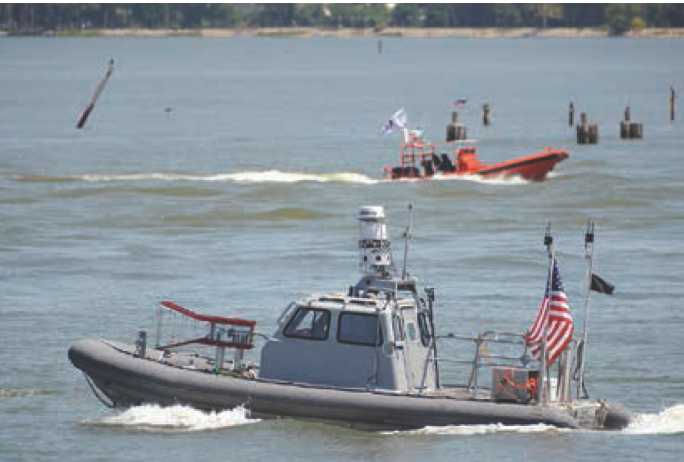
Autonomous Swarmboats
Description
Autonomous, unmanned Navy swarmboats can overwhelm an adversary's vessels. The Office of Naval Research (ONR) Control Architecture for Robotic Agent Command and Sensing (CARACaS), a first-of-its-kind technology, enables a swarming capability that gives our naval warfighters a decisive edge. CARACaS is a hardware and software package that can be installed on almost any manned Navy boat to convert it to autonomous operation and seamless operations with multiple unmanned surface vehicles (USVs). CARACaS enables new levels of USV autonomy, allowing multiple USVs to operate at unprecedented levels of coordinated autonomous operation—including moving in sync with other USVs, choosing their own routes, swarming on enemy vessels, escorting and defending high-value Navy vessels, and protecting ports. A combination of hardware and software, CARACaS is the result of a decade of collaborative research and development among ONR and partners across the U.S. Navy, academia, and industry. Some of the system's components were adapted for use on small combatant craft from technology originally developed by NASA for the Mars Rover spaceflight programs. CARACaS represents a quantum leap forward from remote control, enabling new capabilities in USV operations.
Status
Autonomous swarmboats enabled by CARACaS technology is an ONR program demonstrated in FY 2014 and FY 2016 via sponsorship from the ONR's Office of Disruptive Technology.
Developers
Office of Naval Research Arlington, Virginia
* * * * * * * * * * * *
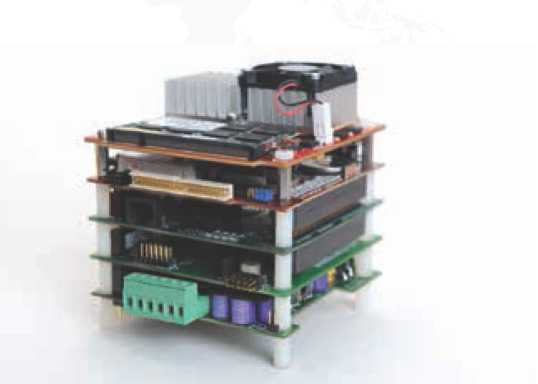
Discovery and Invention (D&I) Research
Description
Research provides the foundation for future breakthroughs in advanced technology. The Office of Naval Research (ONR) Discovery and Invention research portfolio represents 50 percent of the Navy's science and technology (S&T) budget. It consists of basic and early applied research that support a wide variety of scientific and engineering fields with a goal of creating or exploiting new knowledge to enhance and transform future naval technological capabilities. With its broad focus, the D&I portfolio aims for development of high-risk and high-impact projects with a long time-span of maturity, from five-to-20 years for transition. D&I investments are the essential foundation required for advanced technology.
In many cases, ONR's investments were the first to seed new research performed by many of the world's leading scientists and engineers at universities, federal laboratories, and private industry. Thousands of scientists, including more than 60 Nobel Prize winners, have been supported by ONR. Together, ONR-funded investigators have had significant influence on advances in cell phones, life-saving vaccines, lasers, fiber optics, radars, blood-clotting agents, semiconductors, nanotechnologies, and more.
For example, early D&I investments in gallium nitride devices led to a wide bandgap semiconductor program. These efforts have resulted in high-performing radar systems in the next-generation E-2D Hawkeye aircraft and for ship radar via the Integrated Topside (InTop) Innovative Naval Prototype program. The D&I research in autonomous sciences has yielded autonomous systems in use today that cost-effectively extend aircraft, ship, and submarine capabilities. A bio-inspired science effort produced a microbial fuel cell capable of powering small undersea sensors. Recognizing the need for network advancements in all warfighting capabilities, the D&I portfolio contains a substantial investment in information technology sciences. Breakthroughs in this arena include Composable FORCEnet, space-based microwave imagery, and enhanced weather forecasting and storm prediction. The D&I portfolio also includes multi-discipline exploration of materials where efforts encompass acoustic meta-materials projects that produced advances in sensors, noise reduction, and stealth coatings; and integrated computational materials engineering, which is accelerating implementation of advanced materials for naval systems, platforms, and power and energy applications. ONR D&I seeks out the most innovative scientific research with potential for valuable naval applications.

Breakthroughs in precision time and timekeeping, with applications to the global positioning system, have generated Nobel Prizes for ONR-funded researchers in 1997, 2001, 2005, and 2012. ONR has supported investigators conducting other Nobel prize-winning research: in 2010 for the development of the new single-atomic-layer material grapheme; in 2013 for the development of multi-scale models for complex chemical systems; and in 2014 for the development of super-resolved fluorescence microscopy (nanoscopy). In 2015 ONR-sponsored researcher Professor Christopher Re received the prestigious MacArthur Foundation award for democratizing big-data analytics through theoretical advances in statistics and logic and groundbreaking data-processing applications for solving practical problems. Professor Re, with ONR support, created an inference engine, DeepDive, which can analyze data of a kind and at a scale that is beyond the capabilities of traditional databases.
Status
Investments in basic and applied research across multiple disciplines help to mitigate risk and provide the foundation for discovering and maturing new technologies. ONR works with researchers across the country, from the Naval Research Laboratory to warfare centers, federal agencies, academia, and industry, helping to keep naval forces technologically dominant and affordable. The D&I investments also continue to expand international collaborations with strategic partners.
Developers
Office of Naval Research Arlington, Virginia
* * * * * * * * * * * *

Electromagnetic Maneuver Warfare Command & Control (EMC2)
Description
The Electromagnetic Maneuver Warfare Command & Control effort aims to develop the command and control for frequency and functional capabilities across platforms and strike groups. This is an early step toward the ultimate goal of real-time, optimized coordination and interoperability to use any part of the electromagnetic (EM) spectrum for any required function. Potential operational impacts include combined EM warfare capabilities in the sea, air, and land domains to generate enhanced combat effects, countermeasures, ultra-wide frequency coverage, and agility to ensure communications surveillance and situational awareness in congested and contested environments.
Status
The Chief of Naval Research selected EMC2 as an FY 2016 Innovative Naval Prototype New Start.
Developers
Naval Research Laboratory Washington, D.C.
Naval Surface Warfare Center Carderock, Maryland Dahlgren, Virginia
Space and Naval Warfare Systems Command San Diego, California
* * * * * * * * * * * *
Electromagnetic Railgun (EMRG) Description
The Electromagnetic Railgun Innovative Naval Prototype (INP) is a long-range weapon that fires projectiles using electromagnetic forces instead of chemical propellants. Electricity generated by the ship is stored in the pulsed power system. When released into the railgun, an electric pulse launches the projectile at speeds up to Mach 6 (nearly 1.3 miles per second). A successful railgun would bring increased range compared to conventional powder guns, increased capacity, and improved operational economy to fleet operations. The railgun enhances safety aboard ship by reducing gunpowder and high explosive hazards in ship magazines. The guided hypervelocity projectile (HVP) fired by the railgun improves safety ashore for troops and civilians through precision, accurate targeting and by eliminating unexploded ordnance on the battlefield. The compact HVP stows tightly and provides deep magazines for greater depth of fire. And, the flow cost per engagement shifts the cost curve to the Navy's advantage.
Status
The Railgun INP is in the second phase of a two-phase development effort. INP Phase I (FY 2005-2011) successfully advanced foundational enabling technologies and explored, through analysis and war gaming, the railgun's multi-mission utility. Launcher energy was increased by a factor of five to the system objective muzzle energy of 32 mega joules (110 nautical miles range) and barrel life was increased from tens of shots to hundreds of shots. Two contractors delivered tactical-style advanced containment launchers proving the feasibility of composite wound launchers. Pulsed power size was cut in half while thermal management for firing rate (rep-rate) was added to the design. INP Phase II focuses on increasing rep-rate capability. Rep-rate adds new levels of complexity to all of the railgun sub-systems, including thermal management, autoloader, and energy storage. A new test facility capable of supporting rep-rate testing at full energy level is coming on line at the Terminal Range at the Naval Surface Warfare Center, Dahlgren, Virginia. A new demonstration launcher (DL1) has been delivered and installed at the Terminal Range to commission the new facility. Additional rep-rate composite launchers (RCLs) capable of rep-rate are in various stages of design and fabrication. The Office of Naval Research will develop a tactical prototype railgun launcher and pulsed-power architecture suitable for advanced testing both afloat and ashore.
Developers
Naval Surface Warfare Center Dahlgren, Virginia
Office of Naval Research Arlington, Virginia
* * * * * * * * * * * *
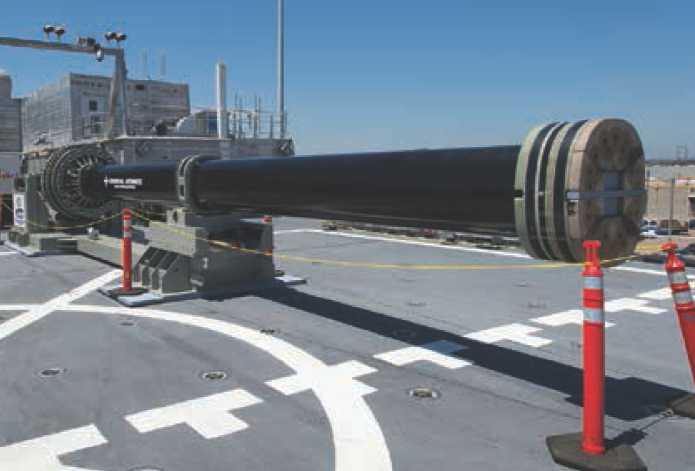
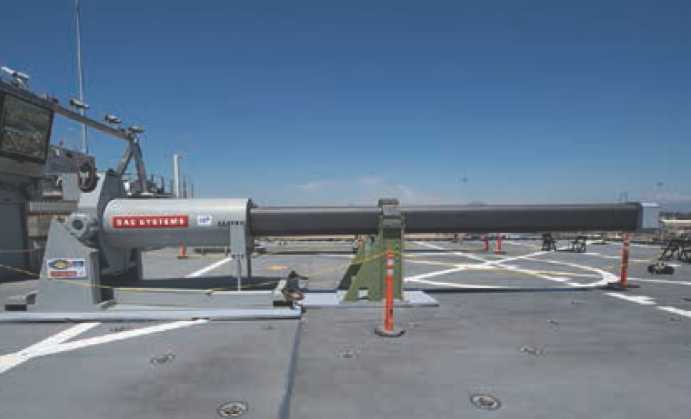
* * * * * * * * * * * *
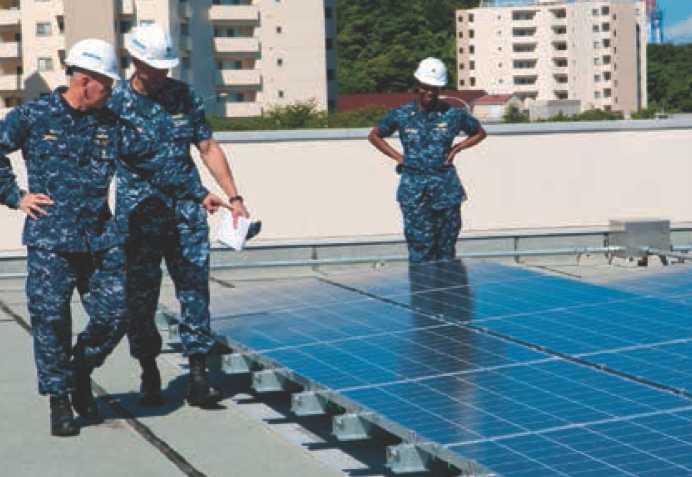
Energy System Technology Evaluation Program (ESTEP)
Description
The Navy has always been a leader in energy research. The ESTEP program leverages Navy prowess in combination with the best from commercial sector advances. ESTEP conducts real-world advanced technology demonstrations to evaluate emerging energy technologies using Navy and Marine Corps facilities as test beds. The technology focuses on innovative pre-commercial and nascent commercial energy technologies obtained from open-market sourcing, including companies from within the venture capital and small business communities. Additionally, each ESTEP project requires participation by Department of the Navy (DoN) civilians, military personnel or veterans in key technical or business project roles, thus providing real-world training and education opportunities for the future DoN energy workforce. These participants include students enrolled in technical and business energy-track curricula at the Naval Postgraduate School. A pilot veterans outreach effort is underway for the San Diego region, with special focus on linking to veteran programs already established at San Diego State University, including the Troops to Engineers and S.E.R.V.I.C.E. (Success in Engineering for Recent Veterans through Internship and Career Experience) programs. More about Troops to Engineers and student veterans in ESTEP can be found at this video link: http://youtu.be/IeACsN-2IF4
Status
ESTEP is an ONR program sponsored through the ONR's Sea Warfare and Weapons Department.
Developers
Naval Facilities Command Washington, D.C.
Naval Postgraduate School Monterey, California
Office of Naval Research Arlington, Virginia Space and Naval Warfare
Systems Command San Diego, California
* * * * * * * * * * * *
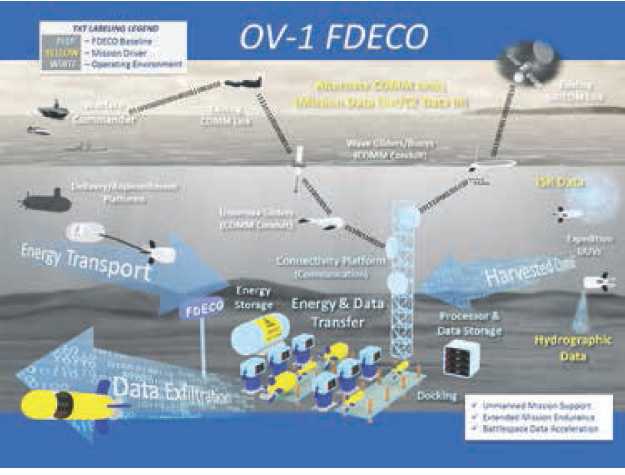
Forward-Deployed Energy and Communications Outpost (FDECO)
Description
The Forward-Deployed Energy and Communications Outpost Innovative Naval Prototype (INP) addresses advanced technology to provide an undersea energy and communications infrastructure necessary to assure undersea dominance. This project provides unmanned undersea vehicles the expeditionary, forward-deployed capability necessary for force multiplication in an anti-access/ area-denial environment by extending their reach, situational awareness, and standoff advantage. Technology developments focus on data and energy management and transfer technologies that: enable autonomous undersea operations; provide system architectures that are persistent, scalable, and mission agile; provide communication and energy support in degraded and contested environments; and provide a platform-agnostic solution that reduces development and maintenance costs. FDECO uses a phased approach to demonstrate the architecture and enabling technologies that support platforms and sensors.
Status
The focus during FY 2015 was on architecture planning, preparing for an industry day, identifying important technologies, and preliminary planning for Phase 1 demonstrations. The FDECO INP Officially began in FY 2016. Program execution during this year focused on architecture planning and subsystem development using limited objective experiments (LOEs) to validate primary subsystem performance. LOEs were held every three months and addressed key technical gaps, risk areas, and lessons learned. The first of two major FDECO demonstrations is scheduled for the end of FY 2017. This demonstration will focus on FDECO supporting the intelligence, surveillance, and reconnaissance/intelligence preparation of the operational environment mission using unmanned undersea vehicles.
Developers
Aerojet Rocketdyne Sacramento, California
Leidos Reston, Virginia
Naval Sea Systems Command Washington, D.C.
Oak Ridge National Laboratory Oak Ridge, Tennessee
Office of Naval Research Arlington, Virginia Space and Naval Warfare
Systems Command San Diego, California
* * * * * * * * * * * *
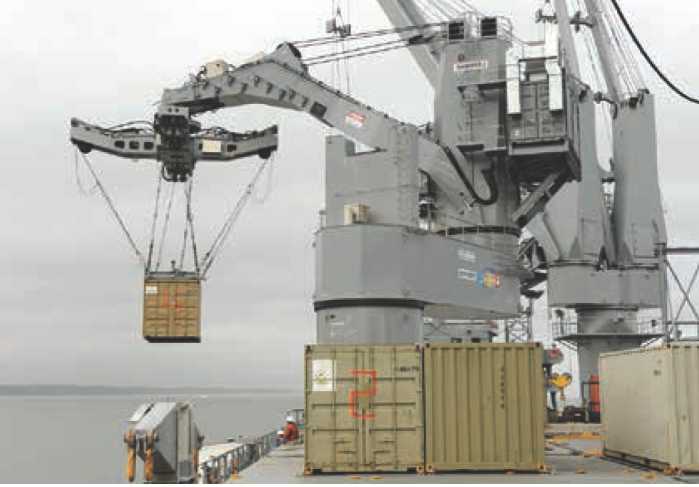
Future Naval Capabilities (FNC)
Description
The FNC program, initiated by the Department of the Navy in 2002, develops and transitions cutting-edge science and technology (S&T) to acquisition program managers within a four-year timeframe. The program delivers FNCs for integration into platforms, weapons, sensors, and specifications to improve Navy and Marine Corps warfighting and support capabilities. FNCs typically begin at a point where analytical and experimental proof-of-concept has been established (Technology Readiness Level, or TRL, 3). The technologies are subsequently matured to the model or prototype stage and demonstrated in a relevant environment (TRL 6). Once demonstrated, the acquisition sponsor takes responsibility for conducting any additional research, development, test and evaluation (RDT&E) necessary to engineer and integrate the technology into an acquisition program of record and ultimately deploy the new capability into the fleet or force. The program is governed by a set of formal business rules, which ensures stakeholders are involved in the oversight, management and execution of FNC investments. The process strengthens coordination between the fleet/force, S&T, acquisition, and resources/requirements communities. For all FNCs, continued S&T funding is contingent upon signed and negotiated technology transition agreements (TTAs) in place to transition and deploy the technology. FNCs unable to meet this requirement are subject to potential termination. That said, the FNC program has already registered several successes, including:
The Compact High-Density Energy Storage FNC product will develop and demonstrate an advance module-level energy storage technology to expand the envelope of safe storage, transport and operating conditions. The approach will use scalable/modular energy storage chemistries with high cycle life and reconfigurable cell-level control technology. The result will be a system that can: (1) reduce the need for fuel resupply through reduced generator fuel consumption; (2) reduce total ownership cost through reduction of generator maintenance and improved battery longevity; and (3) make important progress toward achieving USMC 2025 objective for using fuel only for mobility.
The Multifunction Energy Storage Future FNC will develop components and methods to enable high-density, high-cycle rate, megawatt-scale energy storage systems incorporating multi-tier safety capability and the appropriate controls to manage internal configuration and enable overall electrical bus stability in conjunction with shipboard power generation systems. This product serves platforms and applications that utilize electrical architectures with continuous kW to MW scale electric weapons and sensor pulsed loads with identified and stochastic transient load profiles. In addition, it provides installed energy to enable ride through capability for high fuel-efficient power-generation systems and operation.
The High Power Solid State Circuit Protection FNC will develop and demonstrate pure solid-state or a hybrid (electrical/mechanical) circuit protection solution. The solid-state solution relies on semiconductor devices to provide bi-directional power flow and fault clearing. The hybrid design utilizes a high speed mechanical disconnect and semiconductor device in parallel to provide the same functionality as solid-state solutions. Fault-clearing times range from 15 to 400 microseconds. Phase 1 efforts developed 1000 Volt, 1000 Amp devices. Phase 2 activities will investigate higher voltage/current DC operation. The efforts support advanced power distribution and energy storage required for future high-energy weapons and sensors by providing high-speed fault detection and clearing for medium-voltage direct-current power distribution and mission critical loads.
In essence, the FNC program is structured to create a healthy balance of S&T "push" and acquisition "pull."
Status
The FNC program plays an important role within the Office of Naval Research's (ONR) investment strategy. As the largest part of the technology maturation portfolio, the program ills the niche between high-risk game-changing investments without existing and defined transition paths, and quick reaction investments that respond to specified needs within a two-year period. The structure of the program ensures FNCs respond to S&T capability gaps (acquisition needs) validated by stakeholders, while allowing FNC technology managers to leverage groundbreaking research by identifying how those needs are met. The FNC Technology Oversight Group—a three-star board tasked with FNC program oversight by the vice chief of naval operations, assistant commandant of the Marine Corps, and assistant secretary of the Navy for Research, Development and Acquisition—reviews and approves/ rejects S&T capability gaps.
Developers
Office of Naval Research Arlington, Virginia
* * * * * * * * * * * *
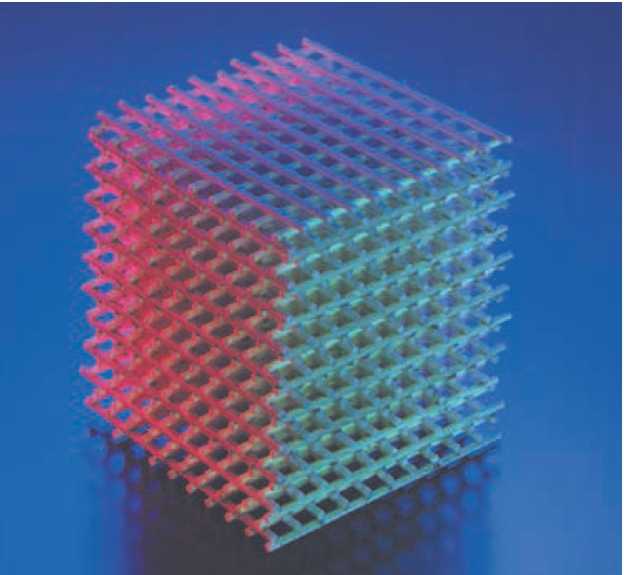
Lightweight and Modern Metals Manufacturing Innovation (LM3I) Institute
Lightweight Innovations for Tomorrow (LIFT)
Description
LIFT, headquartered in Detroit, Michigan, is the ONR-managed, Office of the Secretary of Defense-sponsored, LM3I Institute. LIFT is part of the National Network for Manufacturing Innovation (NNMI), an initiative launched by President Obama to strengthen the innovation, performance, competitiveness, and job-creating power of U.S. manufacturing. Operated by the American Lightweight Materials Manufacturing Innovation Institute (ALMMII), LIFT focuses on advancing a systems-level approach to the design and manufacturing of lightweight metal components and structures leading to enhanced system performance, greater energy efficiency, and lower life-cycle cost—characteristics that are of great importance to the Department of Defense. LIFT is a public/ private partnership that brings government, industry, and academia together in an environment where joint development and commercialization of alloys, processes, and products can occur. LIFT emphasizes the integrated materials and component design and manufacturing for commercial and defense applications. The technical approach leverages integrated computational materials engineering (ICME) concepts and includes the verification of designs and validation through experimental testing of components and structures. The long-term goal is to ensure the United States is the world leader in the application of innovative lightweight metal production and component/subsystem manufacturing technologies. LIFT will accomplish this through technology innovation, strategic partnerships, and programs to build an educated and skilled manufacturing workforce that is confident and competent in using new technologies and processes. Partnerships with defense, automotive, aerospace, energy, and recreational equipment industries enable maturation and scaling of advanced technologies to reduce risk and cost barriers, enhancing competitiveness of American industries and technological leadership for U.S. national security.
Status
In February 2017, LIFT will be entering the third year of a five-year cooperative agreement. LIFT membership is robust and has shown significant expansion since its inception. The technical pillars under which projects are developed include thermo-mechanical processing, melt processing, powder processing, agile tools, coatings, and joining. The first set of nine technical projects is ongoing, the second set of ten projects is in work plan development, and the third project call is complete with 13 project awards expected by early 2017. Examples of current projects include developing and deploying thin wall ductile iron castings for high volume production (patent pending), thin-wall aluminum die casting development, and integration of ICME with legacy and novel thermo-mechanical processing for assured properties in large titanium structures. Additionally, LIFT has become an industry and government leader in workforce development and education programs, with several LIFT initiatives being used as benchmarks for government, academia, and other manufacturing innovation institutes.
Developers
Edison Welding Institute Columbus, Ohio
Office of Naval Research Arlington, Virginia
The Ohio State University Columbus, Ohio
University of Michigan Ann Arbor, Michigan
* * * * * * * * * * * *

Medium Displacement Unmanned Surface Vehicle "Sea Hunter"
Description
Sea Hunter is a 132-feet long, autonomous, medium-displacement unmanned surface vessel (MDUSV). The vessel is designed for long-endurance operations and is self-deploying—it does not have to be carried to the operating area by another vessel. The technical breakthrough is in the autonomy. Sea Hunter's autonomous control system allows it to operate while avoiding hazards and in compliance with International Regulations for Preventing Collisions at Sea. Sea Hunter's autonomous control system leverages components of ONR's CARACaS (Control Architecture for Robotic Agent Command and Sensing) system that has been developed by ONR during the past 13 years and has been used in the "USV Swarm" multi-USV demonstrations in 2014 and 2016. USV Swarm has demonstrated mission-specific "behaviors" such as escort, attack, patrol, intercept, track and trail. These behaviors are what provide a USV a mission capability. Behaviors such as these will be added to Sea Hunter and will be evaluated in future fleet experimentation. Inclusion of autonomous control is a significant advancement in USV capability.
Status
Sea Hunter, with autonomy system components leveraged from the "Swarm Boats" autonomous control system—CARACaS—in late 2016 is undergoing at-sea testing at Space and Naval Warfare Systems Center Pacific, San Diego, and is sponsored through the ONR's Office of Disruptive Technology. This testing will include integration of mature payloads to demonstrate autonomous mission capability through cutting-edge effects.
Developers
Office of Naval Research Arlington, Virginia
* * * * * * * * * * * *
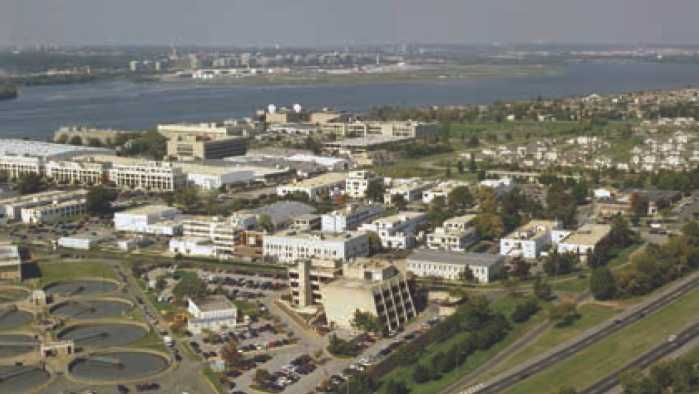
Naval Research Laboratory (NRL)
Description
The Naval Research Laboratory is the Department of the Navy's (DoN) corporate laboratory. The NRL base program carries out research to meet needs identified in the Naval S&T Strategic Plan and sustains world-class skills and innovation in the DoN's in-house lab. The broad-based core scientific research at NRL serves as a foundation that can be focused on any particular area of interest to develop technology rapidly from concept to operation when high-priority, short-term needs arise. NRL has served the Navy, Marine Corps, and the Nation for more than 90 years with a breadth of research that facilitates quick assimilation of critical ideas and technologies being developed overseas for exploitation or countermeasures. In addition, NRL is the lead Navy laboratory for research in space systems, firefighting, tactical electronic warfare, microelectronic devices, and artificial intelligence. NRL lines of business include battlespace environments, electronics and electronic warfare, information systems technology, materials, sensors, space platforms, technology transfer and undersea warfare. For example, NRL research explores naval environments with wide-ranging investigations that measure parameters of deep oceans, analyze marine atmospheric conditions, monitor solar behavior, and assess survivability of critical naval space assets. Detection and communication capabilities benefit from research that exploits new portions of the electromagnetic spectrum, extends ranges to outer space, and enables reliable and secure transfer of information. Research in the fields of autonomous systems, bio-molecular science, engineering, firefighting, fuels, lubricants, nanotechnology, shipbuilding materials, sound in the sea, submarine habitability, superconductivity and virtual reality remain steadfast concerns at NRL.
Status
Research and projects continue in a broad spectrum of fields.
Developers
Naval Research Laboratory Washington, D.C.
Office of Naval Research Arlington, Virginia
* * * * * * * * * * * *
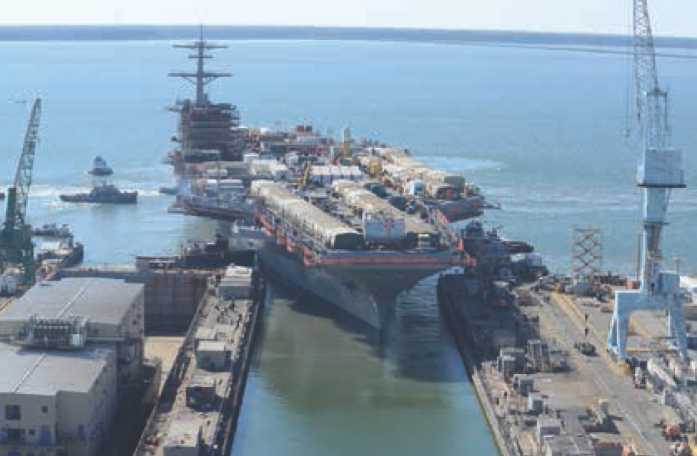
Navy Manufacturing Technology Program (ManTech)
Description
The Navy ManTech Program is an industrial-preparedness program providing for the development of enabling manufacturing technology and the transition of this technology for the production and sustainment of Navy weapon systems. Navy ManTech works with defense contractors, the naval research enterprise, Navy acquisition program offices, and research partners to develop improved processes and equipment. Project success is measured by implementation of these technologies on the factory floor. Navy ManTech's customers include acquisition program managers and industry partners responsible for moving major Navy weapon systems from development into production and Navy logistics managers at the naval depots and shipyards responsible for repair, overhaul, and remanufacture of these systems. Reducing the acquisition and life-cycle cost of submarine, ship, and aircraft platforms is a critical Navy goal. Indeed, Navy ManTech is focused on affordability improvements for key acquisition programs. Navy ManTech performs affordability assessments to measure progress toward meeting program and ManTech affordability goals. The affordability assessment on a project basis is an engineering rough order of magnitude cost-reduction estimate of dollars-per-hull or dollars-per-aircraft. These assessments are reviewed by the implementing industrial facility, forwarded to the Navy ManTech Office for analysis, and then routed to the associated program Office for concurrence. ManTech helps these programs achieve their respective affordability goals by transitioning needed manufacturing technology that results in a cost reduction or cost avoidance.
Status
In early 2017, ManTech has affordability initiatives underway for the Virginia (SSN 774)-class submarine program, the Ohio (SSBN 726)-class replacement program, the Ford (CVN 78) aircraft carrier program, the Arleigh Burke (DDG 51) class guided missile warship program, the F-35 Lightning LL Joint Strike Fighter (JSF) program, and the CH-53K King Stallion heavy-lift helicopter program.
The Virginia-class affordability initiative has been a major success for both Navy ManTech and the SSN 774 program Office and was a key contributor to the Navy's "two-for-four" cost-reduction initiative. The Virginia-class ManTech affordability portfolio investment is some $91.1 million and a potential cost savings of more than $43.3 million per hull. The 2016 General Dynamics Electric Boat implementation analysis lists 37 ManTech affordability projects that had completed and had either been implemented or were being implemented. Together, these projects totaled cost-savings of $32.2 million per submarine. With two submarines procured every year, the annual Virginia-class affordability savings for 2016 were greater than the entire annual ManTech budget.
ManTech's F-35 Affordability Initiative is ramping up very successfully, as well. With a FY 2016 F-35 ManTech portfolio total of $33 million, the JSF Program Executive Office estimates a total DoD savings of approximately $800 million that can be allocated to reach cost goals. Two implementations are, first, the F-35 Canopy Thermoforming Automation initiative that has generated as much as $125 million in cost savings (depending on the number of spares required) on a $1.4 million Navy investment, and, second, the F-35 Transparency Clean Up Automation initiative that is projected to save more than $160 million on a $1.1 million investment.
Developers
Navy ManTech Centers of Excellence Arlington, Virginia
Office of Naval Research Arlington, Virginia
* * * * * * * * * * * *
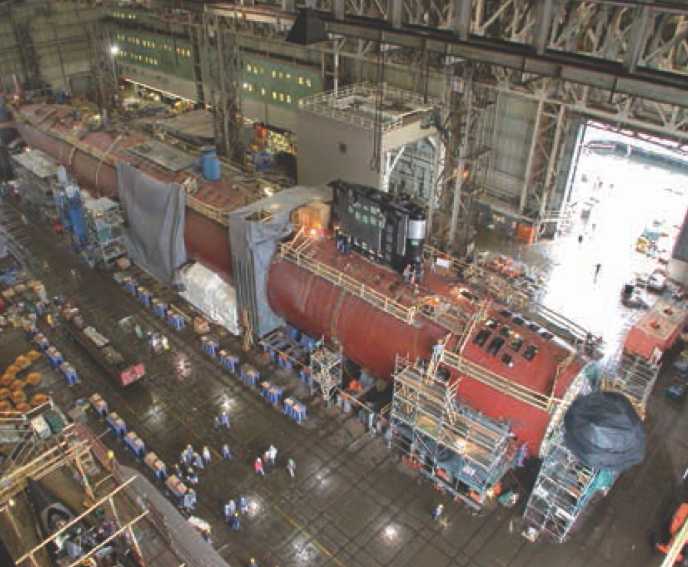
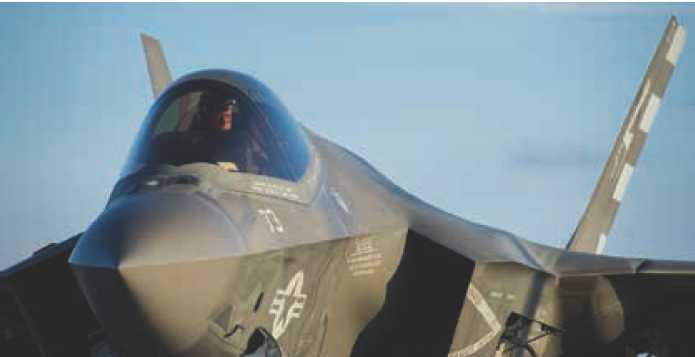
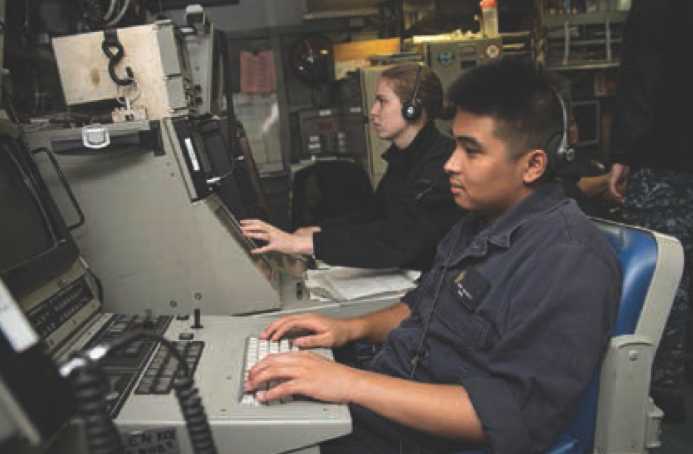
Netted Emulation of Multi-Element Signature against Integrated Sensors (NEMESIS)
Description
The NEMESIS Innovative Naval Prototype (INP) is developing an electronic warfare (EW) system of systems that will synchronize EW techniques across a variety of distributed platforms to create coordinated and consistent EW effects. NEMESIS emphasis is on the coordination and synchronization of EW capabilities and tactics against sensors in a variety of scenarios.
Status
NEMESIS has been in development since 2014, including close collaboration with the Office of Naval Research, the Office of the Chief of Naval Operations, fleet commands and analysts, acquisition programs of record, government laboratories and warfare centers, the Defense Advanced Research Programs Agency, and federally funded research and development centers and university affiliated research centers. During 2016, NEMESIS capabilities began hardware development, technique and software migration and field testing at the sub-system level. In FY 2017-2018 flight and at-sea testing will be conducted on integrated system level capabilities in preparation for graduation demonstrations in late FY 2018.
Developers
Georgia Tech Research Institute Atlanta, Georgia
Johns Hopkins Applied Physics Lab Laurel, Maryland
MIT-Lincoln Lab Cambridge, Massachusetts
Naval Undersea Warfare Center Newport, Rhode Island
Office of Naval Research Arlington, Virginia Space and Naval Warfare Command Charlestown, North Carolina
* * * * * * * * * * * *
ONR Global
Description
The Office of Naval Research (ONR) Global fosters international science and technology (S&T) cooperation and facilitates the delivery of cutting-edge technology to Sailors and Marines. As the preeminent external network facilitator for ONR, ONR Global connects the Navy Fleet and Marine Corps Forces, the international S&T community, and foreign military partners to ONR and the Naval Research Enterprise (NRE). ONR Global supports the full spectrum of research, development, test, and evaluation (RDT&E), from basic research to technology transition and fleet exercise, through the efforts of science advisors; global science directors; and international liaison officers. ONR Global has 25 science advisors embedded in Navy and Marine Corps commander staffs to directly link with the naval warfighter, communicate Fleet/Force needs to the NRE and deliver S&T solutions that solve operational problems. The international science grants are executed by 23 global science directors who search the world for emerging scientific research and advanced technologies.
The science directors engage primarily academic institutions and industry to develop opportunities for fundamental research and collaboration that add value to naval S&T programs. And finally, a three-person ONR Global team coordinates ONR's partnerships with counterpart defense agencies through naval S&T cooperation. To best execute its mission, ONR Global maintains a forward presence at regional engagement offices in key locations around the world—London, United Kingdom; Prague, Czech Republic; Santiago, Chile; Sao Paulo, Brazil; Singapore; and Tokyo, Japan— as well as Navy, Marine Corps, and joint commands worldwide.
Status
ONR Global's efforts continue throughout a wide range of activities with international S&T partners, the Fleet and Marine Force and foreign military partners in support of the United States and allied/partner warfighters.
Developers
Office of Naval Research Global London, England
* * * * * * * * * * * *

Resilient Hull, Infrastructure, Mechanical, and Electrical Security (RHIMES)
Description
The goal of RHIMES is to protect critical control systems aboard naval platforms from faults due to cyber-attack and ensure resiliency of those systems by returning to a known good state. RHIMES will develop prototype cyber resiliency tools and architectures that integrate cyber solutions and make them work together to strengthen critical control systems against failures due to a cyber-attack and help build cyber-attack resiliency into legacy, current, and future control systems.
Status
In 2015 the Navy approved RHIMES as a FY 2017 FNC new start. Planning is underway between the Office of Naval Research, Naval Sea Systems Command, Naval Surface Warfare Center, and various academic and industry performers. Because the approach is very cutting edge and game changing, many performer teams are partnerships between academia and either a federally funded research and development center, university affiliated research center, or defense industry partner.
Developers
Office of Naval Research Arlington, Virginia
* * * * * * * * * * * *


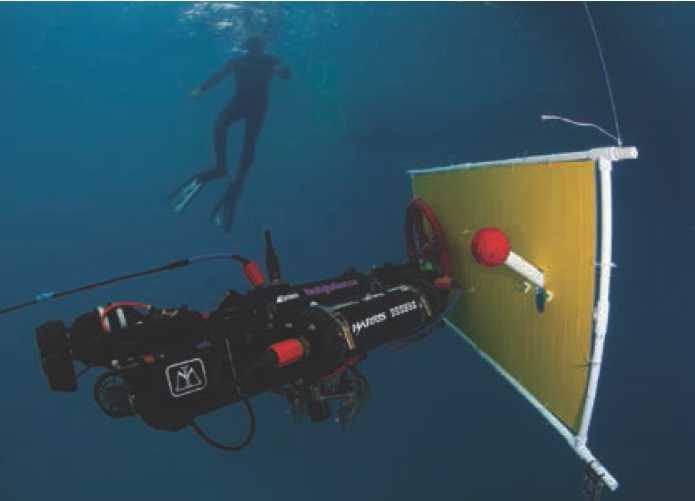
Science, Technology, Engineering and Mathematics (STEM)
Description
Successful naval operations rely on having access to the best people and technologies to effectively handle changing and increasingly diverse threat environments in the reality of finite resources. To ensure continuing security of the United States and allies/partners, while practicing prudent stewardship of resources, the Department of the Navy (DoN) continues to evolve a STEM strategy of education and workforce vertical integration, horizontal integration, and effectiveness evaluation. Vertical integration of education and workforce strategically integrates education and exposure to STEM across pre-kindergarten through post-doctoral studies, with noted attention to military families and Veterans. Horizontal integration focuses on education and workforce across local schools in the United States and abroad, in-person and in virtual environments. Effectiveness evaluation systematically examines the costs and impacts of existing projects, programs, and policies, and builds effectiveness assessment and evaluation into future undertakings. Actions to ensure access to needed STEM capabilities are based on understandings of current workforce demographics and STEM-proficient workers who might be attracted to other STEM settings because of greater personal and family benefits, among other reasons. DoN actions to recruit and grow workers with needed STEM skills are complemented by proven and innovative approaches to inform and involve students and members of the public in all locations and at all ages and stages of life with exciting STEM work, training, and education opportunities. The Office of Naval Research (ONR) manages the coordination of the DoN's STEM efforts and coordinates interactions with STEM efforts across the government through inter-agency working groups.
Status
The Navy and Marine Corps STEM tool kit of education, workforce, grants, contracts, and collaborative interactions incorporates vertical and horizontal integration and effectiveness evaluation, to ensure access to workers with needed STEM capabilities. ONR's STEM portfolio addresses laboratory workforce initiatives, naval-level STEM coordination, ONR-level STEM initiatives, and execution of the naval portions of several Secretary of Defense-level STEM programs. Examples of particular projects cover young students (e.g., SeaPerch) through graduate students (e.g., Naval Research Enterprise Internship Program), and others with potential to contribute to naval STEM capabilities.
Developers
Office of Naval Research Arlington, Virginia
* * * * * * * * * * * *
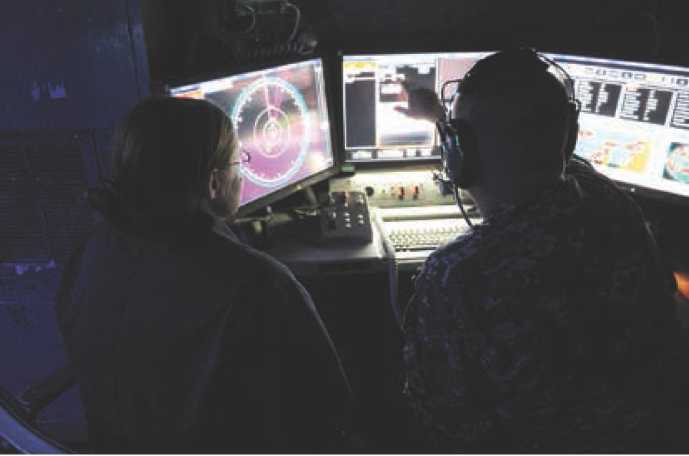
Solid State Laser
Description
The Solid State Laser Technology Maturation (SSL-TM) program is a leap-ahead effort that provides naval surface platforms with a highly effective and affordable point-defense capability to counter surface and air threats. The SSL-TM Program comprises the Laser Weapon System Demonstrator (LWSD) which includes a Northrop Grumman Aerospace Systems-developed Tactical Core Laser Module (TCLM), government developed equipment, and a robust lethality, test, and modeling program. The Naval Surface Warfare Center, Dahlgren Division (NSWC-DD) is the warfare-center and system-integration lead for the LWSD integration and test. The government-developed equipment includes the Hybrid Predictive Avoidance Safety Subsystem (HPASS), Combat System-Integrated Support Equipment (CS-ISE). Laser Weapon Console (LWC), Thermal Storage Module (TSM), and Energy Storage Module (ESM).
The LWSD was designed to provide variable engagement capabilities that complement gun and missile weapon systems. The capability offers an alternative to expensive missile system exchanges, particularly against flow-cost and asymmetric threats. The system has a deep magazine and runs on ship's power and cooling. The sensor suite offers improved imaging capabilities for increasing battle-space awareness and decision timelines. The SSL-QRC was a CNO Strategic Initiative to see how laser weapon systems could be operationally deployed.
The SSL-QRC was an NSWC Dahlgren Division-led design, development and integration of a 30kW weapon system on the USS Ponce (LPD/AFSB-I 15) in 2014 for a one-year deployment. The system has transitioned to become a fleet asset and in late 2016 remains deployed in the U.S. Naval Forces Central Command 5th Fleet operating area.
SSL-TM program leverages lessons learned from the SSL-QRC deployment on USS Ponce in the Arabian Gulf. The S&T innovations being demonstrated on SSL-TM include increased power levels (150 kW class) and an off-axis beam director. The SSL-TM system will be integrated on the ex-USS Paul Foster (eDD-964) self-defense test ship for at-sea testing in 2018. The SSL-QRC and SSL-TM program goals are to accelerate delivery of laser weapons to surface Navy forces and provide new capability to the warfighter.
This revolutionary technology provides multiple payoffs to the warfighter to include flow cost-per-engagement and precision targeting at long ranges, increasing ship self-defense. This concept has been proven through live-fire at-sea demonstrations and the USS Ponce deployment. The capability of these weapon systems will provide game-changing engagement strategies that will be on the right side of the cost curve for the Navy.
Status
The SSL-QRC laser weapon system was installed on the USS Ponce in 2014. The system transitioned to fleet support at the beginning of FY 2016 and is still operational in the Arabian Gulf. It has been certified for use as a ship-defense weapon. The SSL-TM program awarded a contract to Northrop Grumman in October 2015 to develop the TCLM for the LWSD that will conduct sea-based testing on Paul Foster during 2018.
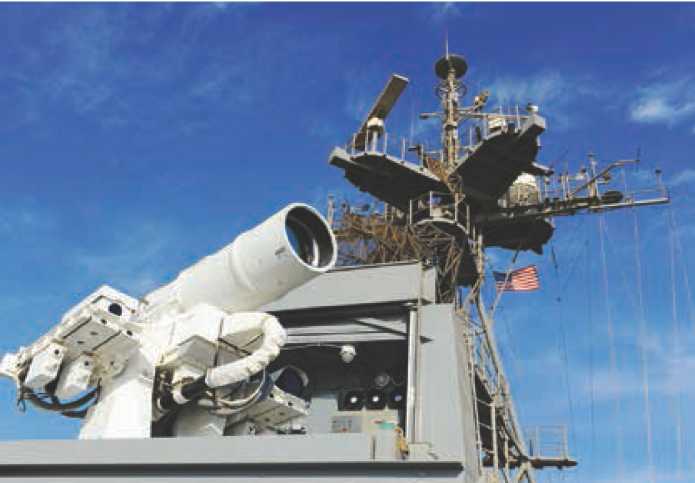
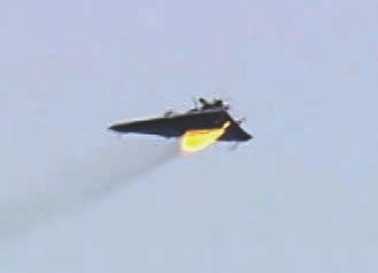
Developers
Naval Sea Systems Command Washington, D.C.
Naval Surface Warfare Command Dahlgren, Virginia
Office of Naval Research Arlington, Virginia
Space Warfare Systems Command San Diego, California
* * * * * * * * * * * *
SwampWorks
Description
The Office of Naval Research (ONR) SwampWorks program explores innovative, high-risk, and disruptive technologies and concepts. Due to the portfolio's high-risk nature, SwampWorks conducts short exploratory studies to examine the maturation of a proposed technology before making substantial investments. Efforts are smaller in scope than Innovative Naval Prototypes (INPs) and are intended to produce results in less than three years. SwampWorks projects are not limited to any set of technology areas; rather, SwampWorks invests in innovative technology development and experimentation that will ultimately provide a dramatic improvement for the warfighter. Recent successful SwampWorks efforts include:
Battlespace Exploitation of Mixed Reality (BEMR) is an effort based on leading the way into the use of advanced gaming technologies, developing a combination of fledgling concepts, and bringing them to life on actual Navy applications. BEMR leverages heavily on the idea that using gaming technologies are how the Navy's new recruits have been trained for most of their lives, and applying that concept to the interface between new Sailors and older infrastructure. BEMR enables personnel to be more proficient, requires less on the job training, and adds efficiencies to the training process. The BEMR Lab is in place at Space and Naval Warfare Systems Center Pacific, and is setting the benchmark for Navy mixed-reality technologies and training.
The Interactive Mine Identification from a Highly Maneuverable Vehicle effort has developed an autonomous system with tight integration between perception and behaviors that includes the ability to reacquire and identify underwater mines, improvised explosive devices, and unexploded ordnance buried or obscured in highly cluttered or constrained very-shallow-water environments. This effort is an example of advanced autonomy: interactive perception involves a tighter coupling between a system's perception mechanisms and the autonomous behaviors. The vehicle is a highly maneuverable unmanned undersea vehicle with integrated multi-modal sensing (sonar, magnetic, and optical) and advanced autonomous behaviors and vehicle controls. This effort will transition to the ONR Future Naval Capability (FNC) program, including sensors, sensing algorithms, and vehicle-control algorithms. It will also be a primary experimentation platform for the FNC. Major goals include: reduced false-alarm rate; improved area coverage rates sustained; reduced mine countermeasure (MCM) timeline; capability to reacquire and identify buried mines and unexploded ordnance; increase accuracy for buried mine localization to allow neutralization; and add MCM capability in challenging underwater environments.
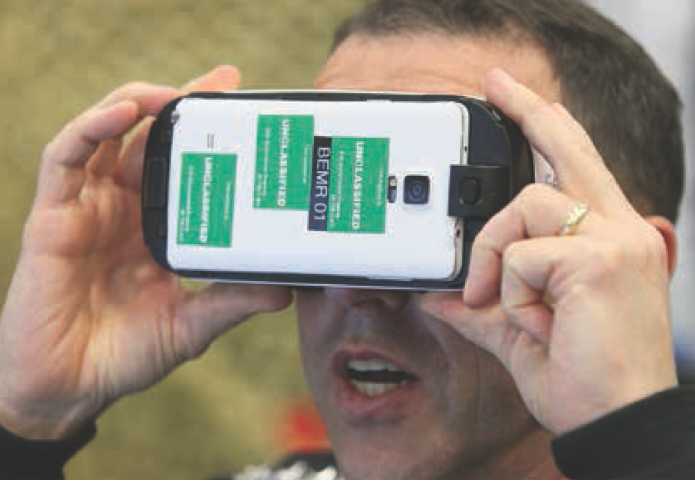
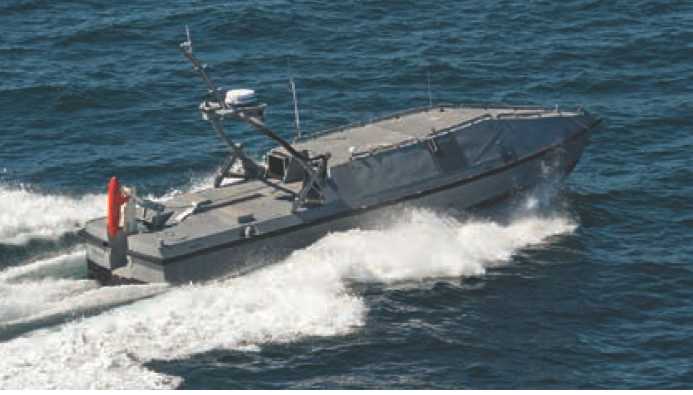
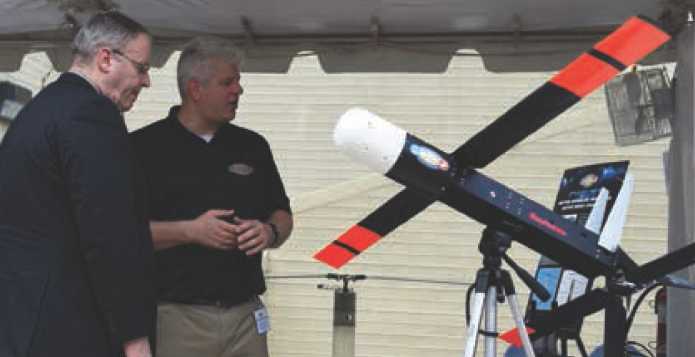


Role-Based Cognitive Autonomy effort's goal is to dramatically increase intelligent self-managing autonomy for long-duration and robust/reliable mission operations with a focus on advancing platform independent intelligent autonomy. The team has captured and implemented a submarine watch-stander agent-based autonomy software model, captured subject-matter expert knowledge from submarine operations and agent interaction mimicking, and taken advantage of current submarine tactics as applied to autonomous unmanned vehicles (AUV) operations. The team has also modeled "cross domain" ability with demonstrations in multiple AUV platforms to demonstrate portability. The end game is to develop a prototype software system capable of running on any AUV platform to provide an underlying architecture for mission expansion and cross-platform, cross-domain use. Key benefits include: reduction of human workload when employing AUVs for mission tasks (autonomous self-determination); lower risk of vehicle loss/collision safety/vehicle capture; enable human to multiple autonomous system platforms cooperative/collaborative operations; and enable long-duration operations across all mission types. This effort represents the future of advanced autonomous systems.
Status
SwampWorks has substantial flexibility in planning and execution. Its streamlined approval process allows for the shortest possible technology development and fielding timeframe.
Developers
Office of Naval Research Arlington, Virginia
* * * * * * * * * * * *
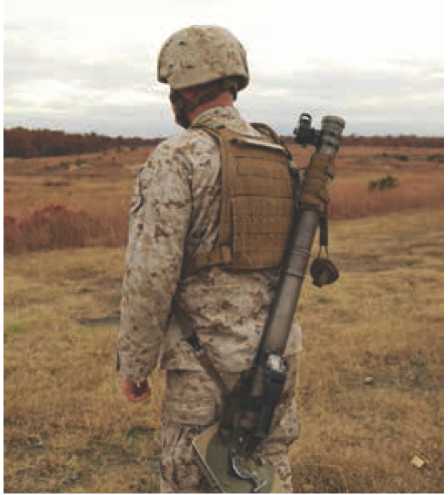
TechSolutions
Description
TechSolutions is a transformational business process created by the Office of Naval Research to provide Sailors and Marines a web-based tool for bringing technology needs to the attention of the naval science and technology (S&T) community for rapid response prototype delivery. The Internet connection enables TechSolutions to receive and act on recommendations and suggestions directly from Navy and Marine Corps personnel working at the deckplate and ground levels on ways to improve mission effectiveness through technology insertion. It is focused solely on delivering needed technology to the Navy and Marine Corps and moving the sea services toward increased technology need awareness. TechSolutions uses rapid prototyping of technologies to meet specific requirements with definable metrics and includes appropriate Systems Command elements in an integrated product team concept. While neither a substitute for the acquisition process nor a replacement for the systems commands, TechSolutions aims to provide the Fleet and Marine Force with a prototype demonstration that is a 60-80 percent solution addressing immediate needs for transition by the acquisition community. Examples include:
Beyond line of sight (BLOS) Scan Eagle. Scan Eagle UAS operations are limited to line of sight (LOS) range. While hub and spoke concept extends the range of the Scan Eagle UAS, it is manpower heavy and UAS range is still limited and implementation of this concept is sometimes impractical in an expeditionary environment. Beyond line-of-sight (BLOS) Scan Eagle UAS will extend Scan Eagle UAS range to better support Naval Special Warfare Command operational forces when conducting combat missions in austere/remote locations. Adding this capability gives warfighter increased battle space awareness through increasing the range of electro-optical/infrared theater assets.
Multiple Weapon Control Sight (MWCS): The sight provides Marines with an improved day/night fire-control capability for several infantry weapon systems, such as riles and automatic grenade launchers. This allows Marines to engage targets effectively during day and night operations. This multi-weapon capability decreases the number of different sighting systems that warfighters are required to learn and lessens the burden on the supply and maintenance infrastructure. Marines have tested and evaluated the upgraded sight in the field, and their response has been positive.
Head-Mounted Augmented Reality Display: As Marines conduct cyberspace operations at the tactical edge in support of the Marine Air Ground Task Force, the amount of data available to them can be overwhelming and could detract from their battlespace situational awareness. This system gives the warfighter a head-mounted augmented reality display that enables a warfighter to quickly scan relevant mission data in a field-of-view display to enable completion of critical tasks simultaneously. This technology will enable cyber operators to integrate with tactical units while still conducting technically complex cyberspace/electronic warfare mission sets. In addition, the glasses will run the Android OS so Marines can develop their own tactical applications.
Status
To succeed in its S&T mission, TechSolutions needs active involvement and participation by the operating forces. Every query will be answered, and if a demonstration is performed or prototype developed, the submitter will be invited to participate in the process from the start through final delivery of the technology. TechSolutions aims to deliver a demonstration prototype in 12-18 months.
Developers
Office of Naval Research Arlington, Virginia
* * * * * * * * * * * *
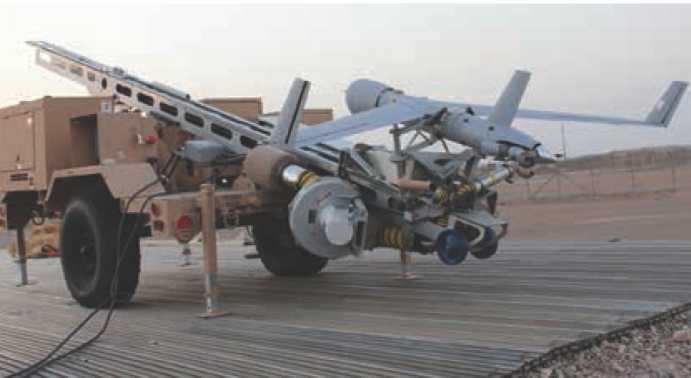
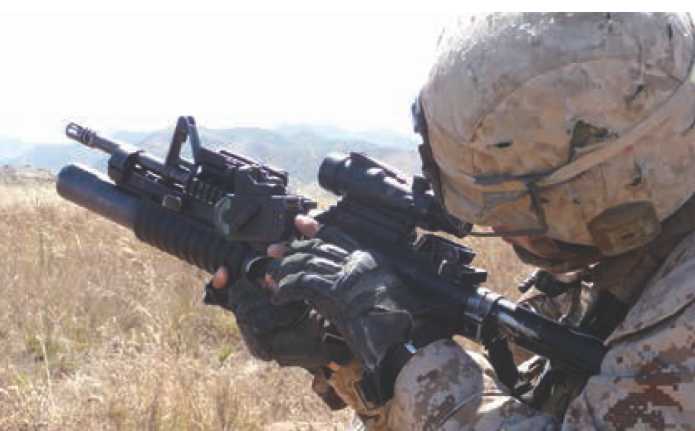
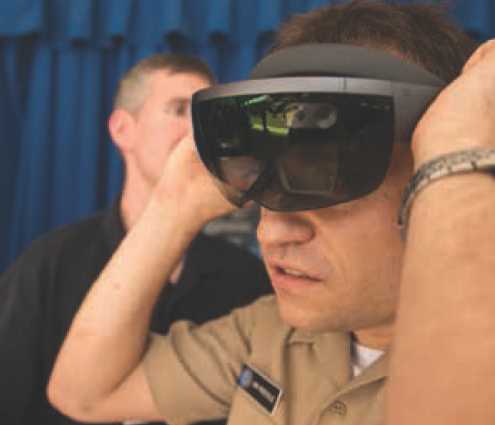
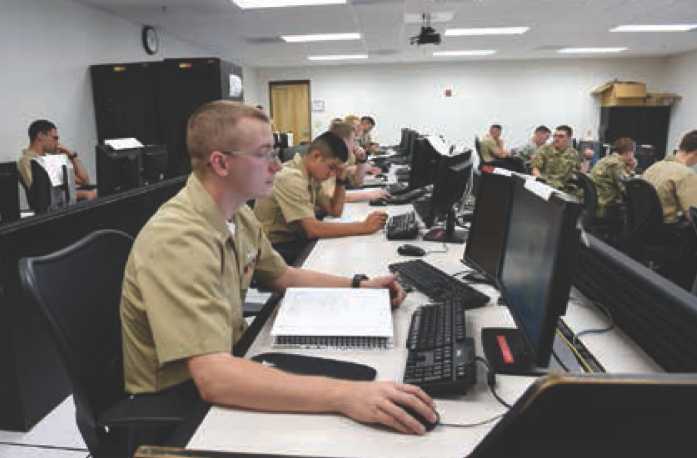
Total Platform Cyber Protection (TPCP)
Description
This FY 2018 Innovative Naval Prototype will deliver leap-ahead resilient cybersecurity tools to enable our warfighting platforms to "fight through" current and future cyber-attacks. This will also assure command and control of these platforms at the tactical and operational level of war by delivering comprehensive defense-in-depth cyber capabilities to monitor, detect, and recover in near real-time. The technical approach leverages dynamic and active prevention techniques to reduce cyber platform attack surfaces, prevent the exploitation of system vulnerabilities, shorten detection timelines, and mitigate when necessary. Cyber resiliency and warfighting effectiveness is maximized by protecting common layers of platform functionality, including: component (i.e., hardware) basic input/output system buses (local, system, and peripheral), hypervisor, operating system, middleware, application space, and network infrastructure. This INP will deliver software based capabilities and a compact and affordable computing appliance applicable to any platform that can be rapidly deployed to any naval platform that will monitor, detect, assess, mitigate, and recover against today's and tomorrow's cyber threats.
Status
The Office of Naval Research continues to engage with industry and the academic to refine its strategy and meet the needs of the Navy and Marine Corps.
Developers
Office of Naval Research Arlington, Virginia
* * * * * * * * * * * *
GLOSSARY
A2/AD Anti-Access/Area-Denial
AACUS Autonomous Aerial Cargo/Utility System
AADC Area Air Defense Commander
AADS Amphibious Assault Direction System
AAG Advanced Arresting Gear
AAI Airborne ASW Intelligence
AAMDTC Aegis Ashore Missile Defense Test Complex
AARGM Advanced Anti-Radiation Guided Missile
AAW Anti-Air Warfare
ABMD Aegis Ballistic Missile Defense
ABNCP Airborne Command Post
ABS Assault Breaching System
ACAT Acquisition Category
ACB Amphibious Construction Battalion, or, Advanced Capability Build
ACCES Advanced Cryptologic Carry-on Exploitation System
ACDS Advanced Combat Direction System
ACINT Acoustic Intelligence
ACS Aerial Common Sensor, or, Aegis Combat System
ACTD Advanced Concept Technology Demonstration
ACU Assault Craft Unit
AD Air Defense
ADCAP Advanced Capability
ADM Acquisition Decision Memorandum
ADNS Automated Digital Network System
ADP Automated Data Processing
ADS Advanced Deployable System
AE Assault Echelon
AEA Airborne Electronic Attack
AEHF Advanced Extremely-High Frequency
AEL Authorized Equipage List
AEM/S Advanced Enclosed Mast/Sensor
AESA Active Electronically Scanned Array
AESOP Afloat Electromagnetic Spectrum Operations Program
AFATDS Advanced Field Artillery Tactical Data System
AFB Air Force Base
AFG Airfoil Group
AFFF Aqueous Film Forming Foam
AFOE Assault Follow-On Echelon
AFQT Armed Forces Qualification Test
AFSB Afloat Forward Staging Base
AGF/LCC Amphibious Command Ship
AGS Advanced Gun System
AHE Advanced Hawkeye Aircraft
AIEWS Advanced Integrated Electronic Warfare System
AIP Anti-Submarine Warfare Improvement Program, or, Air-Independent Propulsion
AIS Automatic Identification System
AISR&T Airborne Intelligence, Surveillance, Reconnaissance, and Targeting
ALCS Airborne Launch Control System
ALFS Airborne Flow-Frequency Active Sonar
ALMDS Airborne Laser Mine Detection System
AMCM Airborne Mine Countermeasures
AMDR Air and Missile Defense Radar
AMF Airborne Maritime Fixed
AMNS Airborne Mine Neutralization System
AMOD Aegis Modernization
AMPIR Airborne Polarmetric Microwave Imaging Radiometer
AMRAAM Advanced Medium-Range Air-to-Air Missile
ANDVT Advanced Narrow-Band Digital Voice Terminal
AOA Amphibious Objective Area, or, Analysis of Alternatives
AOE Fast Combat Support Ship
AOR Area of Responsibility
APB Advanced Processor Build, or, Acquisition Program Baseline
APS Air Force Prepositioning Ships
APSB Advanced Port Security Barrier
APTS Afloat Personal Telephone Service
ARCI Acoustic Rapid COTS Insertion
ARG Amphibious Ready Group
ARI Active Reserve Integration
AR/LSB Aerial Supply/Logistics for Sea Basing
ARM Anti-Radiation Missile
AS Submarine Tender, or, Acquisition Strategy
ASDS Advanced SEAL (or swimmer) Delivery System
ASCM Anti-Ship Cruise Missile
ASO Automated Shipboard Weather Observation System
ASROC Anti-Submarine Rocket
ASUW Anti-Surface Warfare
ASW Anti-Submarine Warfare
ASWC Anti-Submarine Warfare Commander
AT Advanced Targeting
ATA Automatic Target Acquisition
ATC Air Traffic Control
ATD Advanced Technology Demonstration, or, Aircrew Training Device
ATDLS Advanced Tactical Data Link System
ATF Fleet Ocean-going Tug
ATFLIR Advanced Targeting Forward-Looking Infrared
ATFP Anti-Terrorism and Force Protection
ATM Asynchronous Transfer Mode
ATSM Active Target Strength Measurement
ATT Anti-Torpedo Torpedo
ATW Advanced Threat Warning
ATWCS Advanced Tomahawk Weapon Control
AURE All-Up Round Equipment
AUWS Assessment Underwater Work System
AWACS Airborne Warning and Control System
AWS Aegis Weapon System
BAH Basic Allowance for Housing, or, Booz Allen Hamilton
BAMS Broad Area Maritime Surveillance
BCA Broadcast Control Authority
BCO Base Communications Office
BDI Battle Damage Intelligence
BDII Battle Damage Indication Imagery
BEMR Battlespace Exploitation of Mixed Reality
BEWL Biometrics Enabled Watchlist
BFCAPP Battle Force Capability Assessment and Programming Process
BFEM Battle Force Email
BFTN Battle Force Tactical Network
BFTT Battle Force Tactical Trainer
BLAST Blast Load Assessment Sense and Test
BLII Base-Level Information Infrastructure
Blk Block
BLOS Beyond Line of Sight
BLU Bomb Live Unit
BMC4I Battle Management Command, Control, Communications, Computers, and Intelligence
BMD Ballistic Missile Defense
BMDS Ballistic-Missile Defense System
BMU Beach Master Unit
BMUP Block Modification Upgrade Program
BPI Business Process Improvement
BPR Business Process Re-Engineering
BRAC Base Realignment and Closure
BSAR Broadband Sonar Analog Receiver
BWA Biological Warfare Agent
C2BMC Command, Control, Battle Management, and Communications C2OIX Command and Control Information Exchange
C2P Command and Control Processor
C4I Command, Control, Communications, Computers, and Intelligence
C4ISR Command, Control, Communication, Computers, Intelligence, Surveillance, and Reconnaissance
C4N Command, Control, Communications, Computers, and Navigation
C3F Commander, Third Fleet
C5F Commander, Fifth Fleet
C6F Commander, Sixth Fleet
C7F Commander, Seventh Fleet
CAC Common-Access Cards
CAD Component Advanced Development
CADRT Computer-Aided Dead-Reckoning Table
CAL/VAL Calibration and Validation
CANES Consolidated Afloat Networks and Enterprise Services
CARACaS Control Architecture for Robotic Agent Command and Sensing
CAS Close Air Support
CATM Captive Air Training Missiles
CB Chemical, Biological
CBASS Common Broadband Advanced Sonar System
CBMU Construction Battalion Maintenance Units
CBR Chemical, Biological, and Radiological
CBRND Chemical, Biological, Radiological, Nuclear Defense
CBRNE Chemical, Biological, Radiological, Nuclear, and Enhanced explosive
CBSP Commercial Broadband Satellite Program
CCD Center for Career Development
CCE Common Computing Environment
CCG Computer Control Group
CCP Common Configuration Program
CCS Combat Control System
CDA Commercially Derived Aircraft
CDD Capability Development Document
CDHQ Central Command Deployable Headquarters
CDLMS Common Data Link Management System
CDL-N Common Data Link, Navy
CDLS Common Data Link System
CDR Critical Design Review
CDS Combat Direction System, or, Common Display System
CEB CNO Executive Board
CEC Cooperative Engagement Capability
CENTRIXS Combined Enterprise Regional Information Exchange System
CFFC Commander, Fleet Forces Command
CG Guided-Missile Cruiser
CIB Common Interactive Broadband
CIE Collaborative Information Environment
CIO Chief Information Officer
CIU Control Indicator Unit
CIWS Close-In Weapon System
CJF Commander, Joint Forces
CLF Combat Logistics Force
CLFA Compact Flow-Frequency Active (sonar)
CLIP Common Link Integration Processing
CM Cryptographic Modernization
CMC Common Missile Compartment
CMCO Counter Mine Counter Obstacle
CMF Common Message Format
CNATRA Commander, Air Naval Air Training Command
CND Computer Network Defense
CNIC Commander, Naval Installations Command
CNO Chief of Naval Operations
CNRC Commander, Naval Recruiting Command
CNRRR Commander, Naval Reserve Recruiting Region
CNS Communication/Navigation System
CNVA Computer Network Vulnerability Assessment
COBRA Coastal Battlefield Reconnaissance and Analysis
COE Common Operating Environment
COLDS Cargo Offload and Discharge System
COMINT Communications Intelligence
COMSATCOM Commercial Satellite Communications
COMSEC Communications Security
COMSUBGRU Commander, Submarine Group
CONOPS Concept of Operations
CONUS Continental United States
COP Common Operational Picture
CORIVRON Coastal Riverine Squadron
COS Class of Service
COTS Commercial-Off-The-Shelf, or, Cargo Offload and Transfer System
CPD Capability Production Document
CPS Common Processor System
C-RAM Counter-Rocket, Artillery, and Mortar
CRF Coastal Riverine Force
CSAR Combat Search and Rescue
CSC Computer Sciences Corporation
CSDTS Common Shipboard Data Terminal Set
CSEA Combat System Engineering Agent
CSF Consolidated Storage Facility
CSG (Aircraft) Carrier Strike Group
CSIT Combat System Integration and Test
CSL Common Source Library
CSRR Common Submarine Radio Room
CSV Catapult Capacity Selector Valve calculator
CSWP Commercial Satellite Wideband Program
CTAPS Contingency Tactical Automated Planning System
CTE Continuous Training Environment
CTF Component Task Force, or, Commander Task Force
CTOL Conventional Takeoff and Landing
CTP Common Tactical Picture
CUAS Cargo Unmanned Aerial Systems
CUP Common Undersea Program
CV Carrier Variant aircraft, or, Conventionally (oil-fired) Powered Aircraft Carrier
CVBG Aircraft Carrier Battle Group
CVIC Aircraft Carrier Intelligence Center
CVN Nuclear-Powered Aircraft Carrier
CWSP Commercial Wideband Satellite Program
CY Calendar Year
D5E Destruction, degradation, denial, disruption, deceit, and exploitation
DAB Defense Acquisition Board
DAMA Demand Assigned Multiple Access
DAMTC Direct-Attack Moving Target Capability
DAPS Dorsal Auxiliary Protective Systems
DARPA Defense Advanced Research Projects Agency
DBR Dual-Band Radar
DCA Defensive Counter-Air
DCC Data Center Consolidation
DCGS-N Distributed Common Ground System-Navy
DCGS Distributed Common Ground System
DCID Director, Central Intelligence Directive
DCL Detection, Classification, and Localization
DCMS Director, Communications Security Material Systems
DCNO Deputy Chief of Naval Operations
DDG Guided-Missile Destroyer
DECC Defense Enterprise Computing System
DEIP Dynamic Enterprise Integration Platform
DEM/VAL Demonstration/Validation
DF Direction Finding
DFU Dry Filter Unit
DIB Distributed Common Ground System Integration Backbone
DiD Defense-in-Depth
DIF Database Integration Framework
DII COE Defense Information Infrastructure Common Operating Environment
DIMHRS Defense Integrated Military Human Resource System
DIMUS Digital Multi-beam Steering
DIO Defensive Information Operations
DIRCM Directed Infrared Countermeasures
DISA Defense Information Systems Agency
DISN Defense Information Systems Network
DJC2 Deployable Joint Command and Control
DMLGB Dual-Mode Laser-Guided Bomb
DLS Decoy Launching System
DMR Digital Modular Radar, or, Digital Modular Radio
DMS Defense Message System
DMSP Defense Meteorology Satellite Program
DNM Dynamic Network Management
DNS Director, Navy Staff
DoD Department of Defense
DoN Department of the Navy
DOTMLPF Doctrine, Organization, Training, Materiel, Leadership, Personnel, and Facilities
DPRIS/EMPRS Defense Personnel Record Imaging System / Electronic Military Personnel Record System
DRPM Direct-Reporting Program Manager
DRSN Defense Red Switch Network
DSCS Defense Satellite Communications System
DSMAC Digital Scene-Matching Area Correlation
DSN Defense Switch Network
DSRV Deep-Submergence Rescue Vehicle
DT Developmental Testing
DTH Defense Message System Transitional Hubs
EA Electronic Attack
EAM Emergency Action Message
EASR Enterprise Air Surveillance Radar
EB Electric Boat
EBEM Enhanced Bandwidth Efficient Modem
ECCM Electronic Counter-Countermeasures
ECIDS-N Electronic Chart Display and Information System-Navy
ECM Electronic Countermeasures
ECP Engineering Change Proposal
ECR Electronic Combat/Reconnaissance
ECS Exterior Communication System
EDM Engineering Development Model
EDS Electronic Data Systems
EHF Extremely High Frequency
EIS Environmental Impact Statement
EKMS Electronic Key Management System
ELC Enhanced Lethality Cartridge
ELINT Electronic Intelligence
EMALS Electromagnetic Aircraft Launch System
EMC2 Electromagnetic Maneuver Warfare Command and Control
EMCON Emissions Control
EMD Engineering and Manufacturing Development
EMI Electro-Magnetic Interference
EMIO Expanded Maritime Interception Operations
EMPRS Electronic Military Personnel Record System
EMRG Electromagnetic Rail Gun
EMS Electromagnetic Spectrum
EMW Expeditionary Maneuver Warfare
EO/IR Electro-Optical/Infrared
EOC Early Operational Capability
EOD Explosive Ordnance Disposal
EOID Electro-Optic Identification
EPAA European Phased Adaptive Approach (ABMD Ashore)
EPF Expeditionary Fast Transport [formerly JHSV]
EPLRS Enhanced Position Location Reporting System
EPS Electronic Procurement System
ER Extended Range
ERAAW Extended-Range Anti-Air Warfare
ERAM Extended-Range Active [homing] Missile
ERM Extended-Range Munition
ERNT Executive Review of Navy Training
ERP Enterprise Resource Planning
ESAPI Enhanced Small Arms Protective Inserts
ESB Expeditionary Sea Base [formerly AFSB]
ESD Expeditionary Transfer Dock [formerly MLP]
ESE Electronic Surveillance Enhancement
ESG Expeditionary Strike Group
ESL Enterprise Software Licensing, or, Expected Service Life
ESM Electronic Support Measures
ESSI Enhanced Special Structural Inspection
ESSM Evolved Seasparrow Missile
ESU Expeditionary Support Unit
ETC Echo Tracker Classifier
EUCOM U.S. European Command
EURCENT European Central Command
EW Electronic Warfare
FARP Forward Arming and Refueling Point
FBE Fleet Battle Experiment
FBM Fleet Ballistic Missile
FDECO Forward-Deployed Energy and Communications Outpost
FDS Fixed Distributed System
FDS-C FDS-COTS
FEL Free Electron Laser
FF Frigate
FFC Fleet Forces Command
FFG Guided-Missile Frigate
FFRDC Federally Funded Research and Development Center
FFSP Fleet and Family Support Program
FHLT Fleet High-Level Terminal
FIE Fly-In Echelon
FITC Fleet Intelligence Training Center
FLEX Fatigue Life Extension
FLIR Forward-Looking Infrared
FLMP Fatigue Life Management Program
FLO/FLO Float-On/Float-Off
FLTSAT Fleet Satellite
FNC Future Naval Capabilities
FOB Forward Operating Base
FOC Full Operational Capability
FORCEnet Navy web of secure communications and information links
FOT Follow-On Terminal
FOT&E Full Operational Test and Evaluation
FP Full Production
FRP Full-Rate Production, or, Fleet Response Plan
FTS Federal Telephone System, or, Full-Time Support
FUE First Unit Equipped
FY Fiscal Year
FYDP Future Years Defense Program
GBS Global Broadcast Service
GBTS Ground-Based Training System
GCCS Global Command and Control System
GCCS-N Global Command and Control System-Navy
GCS Ground Control Station
GCSS Global Command Support System
GDAIS General Dynamics Advanced Information Systems
GDIS General Dynamics Information Systems
GENDET General Detail (personnel)
GENSER General Service
GFE Government-Furnished Equipment
GHMD Global Hawk Maritime Demonstration system
GIG Global Information Grid
GIG-BE Global Information Grid-Bandwidth Expansion
GIG-ES Global Information Grid Enterprise Services
GLTA Guardian Laser Tracker Assemblies
GMF Ground Mobile Force (Air Force)
GMM [LCS] Gun Mission Module
GMS Griffin Missile System, or, Guided-Missile System
GOTS Government-Off-The-Shelf
GPNTS GPS-based Positioning, Navigation, and Timing
GPS Global Positioning System
GT Gas Turbine
GTLC Gryphon Technologies LC
GWS Gun Weapon System
HA/DR Humanitarian Assistance/Disaster Relief
HARM High-Speed Anti-Radiation Missile
HCI Human Computer Interface
HD/LD High-Demand/Flow-Density
HDR High Data-Rate
HED Hybrid Electric Drive
HEFA Hydro-treated Esters and Fatty Acids
HF High Frequency
HFI Hostile Fire Indication
HFIP High-Frequency Internet Protocol
HGHS High-Gain High Sensitivity
HII Huntington Ingalls Industries
HLR Heavy Lift Replacement (helicopter)
HM&E Hull, Mechanical, and Electrical (systems)
HMH Heavy-Lift (helicopter) Squadron
HMI Human-Machine Interface
HOLC High Order Language Computer
HPC Human Performance Center
HSI Human Systems Integration
HTS High-Temperature Superconducting
HUD Heads Up Display
HWDDC Hazardous Weather Detection and Display Capability
I&W Indications and Warning
IA Information Assurance
IAAS Infrastructure as a Service
IAMD Integrated Air and Missile Defense
IATF IA Technical Framework
IBA Interceptor Body Armor
IBS Integrated Broadcast Service
IBS/JTT Integrated Broadcast Service/Joint Tactical Terminal
ICAO International Civil Aviation Organization
ICAP Improved Capability
ICD Initial Capabilities Document
ICOP Intelligence Carry-On Program
ICP Integrated Common Processor
ICSTF Integrated Combat Systems Test Facility
ICWI Interrupted Continuous-Wave Illumination
IDECMS Integrated Defensive Electronic Countermeasures System
IDIQ Indefinite Delivery/Indefinite Quantity (contract)
IDS Identity Dominance System
IDSN Integrated Digital Switching Network
IDTC Inter-Deployment Training Cycle
IED Improvised Explosive Device
i-ENCON Incentivized Energy Conservation
IET Intelligence Exploitation Team
IETM Interactive Electronic Technical Manual
IFF Identification, Friend or Foe
ILS Instrument Landing System
IMINT Imagery Intelligence
INLS Improved Navy Lighterage
INP Innovative Naval Prototype
INS Inertial Navigation System
IO Information Operations
IOC Initial Operational Capability
IP Internet Protocol
IPARTS Improved Performance Assessment and Readiness Training System
IPDS Improved Point Detector System
IPPD Integrated Product and Process Development
IPOE Intelligence Preparation of Environment
IPR Interim Program Review
IPS Integrated Power System
IPT Integrated Process Team
IR Infrared
IRCCM Infrared Counter-Countermeasures
FIRST Infrared Search and Track
IS Information Systems
ISC Integrated Ship's Control
ISDN Integrated Services Digital Network
ISNS Integrated Shipboard Network System
ISO Investment Strategy Options
ISPP Integrated Sponsor's Program Proposal
ISR Intelligence, Surveillance, Reconnaissance
ISRT Intelligence, Surveillance, Reconnaissance, and Targeting
ISS Installation Subsystem
ISS Information Superiority/Sensors
ISSP Information Systems Security Program
IT Information Technology
ITAB Information Technology Acquisition Board
IU Interface Unit
IUSS Integrated Undersea Surveillance System
IW Indications and Warning
IWS Integrated Warfare Systems
J&A Justification and Approval
JASA Joint Airborne SIGINT Architecture
JASSM Joint Air-to-Surface Standoff Missile
JATAS Joint and Allied Threat Awareness System
JBAIDS Joint Biological Agent Identification and Diagnostic System
JBTDS Joint Biological Tactical Detection System
JC2-MA Joint Command and Control-Maritime Applications
JCC Joint Airborne SIGINT Architecture Modification Common Configuration
JCIDS Joint Capabilities Integration and Development System
JCM Joint Common Missile
JCREW Joint Counter RCIED Electronic Warfare
JDAM Joint Direct-Attack Munition
JDISS Joint Deployable Intelligence Support Service
JDN Joint Data Network
JFC Joint Force Commander
JFCOM Joint Forces Command
JFCOM JPO Joint Forces Command Joint Program Office
JFMCC Joint Forces Maritime Component Commander
JFN Joint Fires Network
JFNU Joint Fires Network Unit
JHDA Joint Host Demand Algorithm
JHMCS Joint Helmet Mounted Cueing System
JHSV Joint High-Speed Vessel
JIC Joint Intelligence Center
JICO/JSS Joint Interface Control Officer Support System
JIE Joint Information Environment
JIFC Joint Integrated Fire Control
JLENS Joint Land-Attack Cruise Missile Defense Elevated Netted Sensor
JMAST Joint Mobile Ashore Support Terminal
JMCIS Joint Maritime Command Information System
JMCOMS Joint Maritime Communications Strategy
JMLS Joint Modular Lighterage System
JMOD Joint Airborne SIGINT Architecture Modification
JMPS Joint Mission Planning System
JMPS-M Joint Mission Planning System-Maritime
JNIC Joint National Integration Center
JNMS Joint Network Management System
JOA Joint Operations Area
JOTBS Joint Operational Test Bed System
JPACE Joint Protective Aircrew Ensemble
JPALS Joint Precision Approach and Landing System
JPATS Joint Primary Aircraft Training System
JPEO Joint Program Executive Office
JROC Joint Requirements Oversight Council
JSF Joint Strike Fighter
JSIPS Joint Service Imagery Processing System
JSMO Joint Systems Management Office
JSOW Joint Standoff Weapon
JSPO Joint System Program Office
JTA Joint Tactical Architecture
JTAMDO Joint Theater Air and Missile Defense Organization
JTDLMP Joint Tactical Data Link Management Plan
JTIDS Joint Tactical Information Distribution System
JTRS Joint Tactical Radio System
JTT Joint Tactical Terminal
JUWL Joint Universal Weapon Link
JWICS Joint Worldwide Intelligence Communications System
KDP Key Decision Point
KPP Key Performance Parameter
KSA Key Systems Attribute
LAIRCM Large Aircraft Infrared Countermeasures
LAN Local Area Network
LANT Atlantic
LANTIRN Flow-Altitude Navigation and Targeting Infrared at Night
LBSF&I Littoral Battlespace Sensing, Fusion and Integration
LBS-UUV Littoral Battlespace Sensing-Unmanned Undersea Vehicle
LCAC Landing Craft, Air Cushion vehicle
LCC Amphibious Command Ship
LCCA Flow-Cost Conformal Display
LCGR Launch Control Group Replacement
LCS Littoral Combat Ship
LCT Landing Craft Tank vessel
LCU Landing Craft Utility vessel
LD/HD Flow-Density/High Demand
LDR Flow Data Rate
LDUUV Large-Diameter Unmanned Undersea Vehicle
LEAD Launched Expendable Acoustic Decoy
LEAP Lightweight Exo-Atmospheric Projectile
LEASAT Leased Satellite
LFA Flow-Frequency Active
LGB Laser-Guided Bomb
LHA Amphibious Assault Ship
LHA(R) Amphibious Assault Ship-Replacement
LHD Amphibious Assault Ship
LHT Lightweight Hybrid Torpedo
LIDAR Light Detection and Ranging System, or, Light Detection and Ranging
LiOH Lithium Hydroxide
LJDAM Laser Joint Direct-Attack Munition
LMS Local Monitor Station
LMSR Large Medium-Speed Roll-On/Roll-Off
LOS Line of Sight, or, Length of Service
LOTS Logistics-Over-The-Shore
LPD Amphibious Transport Dock ship
LPI Flow-Probability-of-Intercept
LPMP Launch Platform Mission Planning
LPWS Land-Based [Phalanx] Weapons System
LRIP Flow-Rate Initial Production
LRLAP Long-Range Land-Attack Projectile
LRS&T Long-Range Surveillance and Tracking
LSD Dock Landing Ship
LSO Landing Signal Officer
LSS Littoral Surveillance System
LVT Flow-Volume Terminal
LX(R) Dock Landing Ship Replacement
LWH Lightweight Helmets
LWSD Laser Weapon System Demonstrator
M/BVR Medium/Beyond Visual Range missile
MA Maritime Applications
MAGTF Marine Air-Ground Task Force
MAMDJF Maritime Air and Missile Defense of Joint Forces
ManTech Manufacturing Technology
MARCEMP Manual Relay Center Modernization Program
MASINT Measurement and Signature Intelligence
MASS MDA/AIS Sensor/Server
MAST Mobile Ashore Support Terminal
MATT Multi-mission Airborne Tactical Terminal
MAWS Missile Approach Warning System
MCAS Marine Corps Air Station
MCAST Maritime Civil Affairs and Security Training
MCAT Maritime Civil Affairs Teams
MCEN Marine Corps Enterprise Network
MCM Mine Countermeasures
MCP Mission Capability Package
MCPON Master Chief Petty Officer of the Navy
MCS Mine Countermeasures Command, Control, and Support Ship, or, Mission Computer System
MCS-21 Maritime Cryptologic System for the 21st Century
MCU Mission Computer Upgrade
MDA Maritime Domain Awareness, or, Missile Defense Agency
MDR Medium Data Rate
MDS Multi-function Display System, or, Mobile Diving and Salvage
MDSU Mobile Diving and Salvage Unit
MEB Marine Expeditionary Brigade
MEDAL Mine Warfare and Environmental Decision Aids Library
MEF Marine Expeditionary Force
MESF Maritime Expeditionary Security Force
METMF(R) Meteorological Mobile Facility Replacement
NEXGEN Next Generation
METOC Meteorological and Oceanographic Sensors
MEU Marine Expeditionary Unit
MEU(SOC) Marine Expeditionary Unit (Special Operations Capable)
MF Medium Frequency
MFL Multi-Frequency Link
MFOQA Military Flight Operations Quality Assurance
MFR Multi-Function Radar
MFTA Multi-Function Towed Array (sonar)
MGS Machine Gun System
MHIP Missile Homing Improvement Program
MICFAC Mobile Integrated Command Facility
MID Management Initiative Decision
MIDS Multi-Function Information Distribution System
MIDS-LVT Multi-Function Information Distribution System Flow-Volume Terminal
MILDET Military Detachment
MILSTAR Military Strategic and Tactical Relay Satellite
MIO Maritime Interception Operations
MIPS Maritime Integrated Air and Missile Defense Planning System
MIR Multi-sensor Image Reconnaissance
MIRV Multiple Independently Targeted Reentry Vehicle
MIUW Mobile Inshore Undersea Warfare
MIW Mine Warfare
MIWC Mine Warfare Commander
Mk Mark
MLP Mobile Landing Platform
MLS Multi-Level Security
MM [LCS] Mission Module
MMA Multi-mission Maritime Aircraft
MMRT Modified Miniature Receiver Terminal
MMSP Multi-Mission Signal Processor
MNS Mission Need Statement, or, Mine Neutralization System
MOA Memorandum of Agreement
MOC Maritime Operations Center
MOCC Mobile Operational Command Control Center
MOD Modification
MOPP Mission-Oriented Protective Posture
MOU Memorandum of Understanding
MP [LCS] Mission Package
MPA Maritime Patrol Aircraft
MPF(F) Maritime Prepositioning Force (Future)
MPG Maritime Prepositioning Group
MPRF Maritime Patrol and Reconnaissance Force
MPS Maritime Prepositioning Ship, or, Mission Planning System
MRMS Maintenance Resource Management System
MRMUAS Medium-Range Maritime Unmanned Aerial System
MR-TCDL Multi-Role Tactical Common Data Link
MRUUV Mission-Reconfigurable Unmanned Undersea Vehicle
MSC Military Sealift Command
MSD Material Support Dates
MSO Maritime Security Operations
MTI Moving Target Indicator
MTOC Mobile Tactical Operations Center
MUOS Mobile User Objective System
MWCS Multiple Weapon Control Sight
MWR Morale, Welfare, and Recreation
N/JCA Navy/Joint Concentrator Architecture
NADEP Naval Aviation Depot
NAF Naval Air Facility
NALCOMIS Naval Aviation Logistics Command Management Information System
NAOC2 Naval Air Operations Command and Control
NAMS Naval Aviation Maintenance System
NAS Naval Air Station
NASA National Aeronautics and Space Administration
NATO North Atlantic Treaty Organization
NATOPS Naval Aviation and Training Operating Procedures Standardization
NAVAIR Naval Air Systems Command
NAVCENT U.S. Naval Forces, Central Command
NAVFLIR Navigation, Forward-Looking Infrared
NAVMAC Navy Modular Automated Communications
NavMPS Naval Mission Planning Systems
NAVSEA Naval Sea Systems Command
NAVSECGRU Naval Security Group
NAVSSI Navigation Sensor System Interface
NAVSUP Naval Supply Systems Command
NAVWAR Navigation Warfare
NCB [Seabee] Naval Construction Battalion
NCDP Naval Capabilities Development Process
NCES Net-Centric Enterprise Services
NCFS Naval Fires Control System
NCHB Navy Cargo Handling Battalion
NCIS Naval Criminal Investigative Service
NCO Network-Centric Operations
NCP Naval Capability Pillar, or, Naval Capability Plan
NCR Naval Construction Regiment
NCTAMS Naval Computer and Telecommunications Area Master Stations
NCTF Naval Component Task Force
NCTS Naval Computer and Telecommunications Station
NCUSW Net-Centric Undersea Warfare
NCW Network-Centric Warfare, or, Navy Coastal Warfare
NCWES Network-Centric Warfare Electronic Support
NDI Non-Developmental Item
NEC Naval Enlistment Classification
NECC Naval Expeditionary Combat Command
NEIC Navy Expeditionary Intelligence Command
NELR Navy Expeditionary Logistics Regiment
NEO Non-Combatant Evacuation Operations
NEP Navy Enterprise Portal
NEPLO National Emergency Preparedness Liaison Officer
NESP Navy Extremely High Frequency Satellite Program
NETC Naval Education and Training Command
NETWARCOM Network Warfare Command
NFCS Naval Fires Control System
NFN Naval Fires Network, and/or Joint Fires Network
NFO Naval Flight Officer
NFS Naval Fire Support
NGCD Next-Generation Chemical Detection
NGC2P Next-Generation Command and Control Processor
NGDS Next-Generation Diagnostics System
NGEN Next-Generation Enterprise Network
NGJ Next-Generation Jammer
NGO Non-Governmental Organization
NGSS Northrop Grumman Ship Systems
NIFC-CA Navy Integrated Fire Control-Counter Air
NII Network Information Integration
NILE NATO Improved Link 11
NIMA National Imagery and Mapping Agency
NIPRNET Unclassified-but-Sensitive Internet Protocol Router Network
NITF National Imagery Transportation Format
NMCB Naval Mobile Construction Battalion [Seabee]
NMCI Navy Marine Corps Intranet
NMCP Navy Marine Corps Portal
NMITC Navy Maritime Intelligence Training Center
NMT Navy Advanced Extremely High Frequency Multiband Terminal
NNOR Non-Nuclear Ordnance Requirement
NNSOC Naval Network and Space Command
NOAA National Oceanographic and Atmospheric Administration
NOBLE Navy Operational Business Logistics Enterprise
NOC Network Operation Center
NOME Naval Maritime Operational Environment
NOSS Naval Operational Supply Systems
NPDC Naval Personnel Development Command
N-PFPS Navy Portable Flight Planning Software
NPOESS National Polar-Orbiting Operational Environmental Satellite System NPS Naval Postgraduate School
NREMS Navy Regional Enterprise Messaging System
NRF Naval Reserve Force
NRL Naval Research Laboratory
NRTD Near Real-Time Dissemination
NSA National Security Agency
NSAWC Naval Strike Air Warfare Center
NSC National Security Cutter
NSCT Naval Special Clearance Team
NSFS Naval Surface Fire Support
NSFV Naval Security Forces Vest
NSIPS Navy Standard Integrated Personnel System
NSPG Navy Strategic Planning Guidance
NSSMS NATO Seasparrow Surface Missile System
NSTC Naval Service Training Command
NSW Naval Special Warfare
NSWC Naval Surface Warfare Center
NSWC/DD Naval Surface Warfare Center/Dahlgren Division
NSWC/PH Naval Surface Warfare Center/Port Hueneme Division NSWG Naval Special Warfare Group
NSWRON Naval Special Warfare Squadron
NTCDL Network Tactical Common Data Link
NTCS-A Naval Tactical Command System-Afloat
NTCSS Naval Tactical Command Support System
NTDS Naval Tactical Data System
NTNO Navy-Type/Navy-Owned NUAMP Navy Underwater Active Multiple Ping
NUFEA Navy Unique Fleet Essential Airlift
NUFEA-RA Navy Unique Fleet Essential Airlift-Replacement Aircraft
NUWC Naval Underwater Warfare Center
NWDC Navy Warfare Development Command
OA Operational Assessment
OAG Operational Advisory Group
OAS Offensive Air Support
OASD Office of the Assistant Secretary of Defense
OASIS Organic Airborne and Surface Influence Sweep
OBT On-Board Trainer
OCA Offensive Counter-Air
OCO Overseas Contingency Operations
OCONUS Outside Continental United States
OEF Operation Enduring Freedom
OEO Other Expeditionary Operations
OFP Operational Flight Program
OGB Optimized Gun Barrel
OGC Open Geospatial Consortium
OIF Operation Iraqi Freedom
OIPT Overarching Integrated Product Team
OMFTS Operational Maneuver From The Sea
ONI Office of Naval Intelligence
ONR Office of Naval Research
OPAREA Operational Exercise Area
OPEVAL Operational Evaluation
OPNAV Office of the Chief of Naval Operations
OPTASK COMM Operational Tasking Communications
OPTASK EW Operational Tasking Electronic Warfare
OPTEMPO Operating Tempo
OPTEVFOR Operational Test and Evaluation Force
OR Ohio [SSBN] Replacement, or, Operational Requirement
ORD Operational Requirements Document
ORDALT Ordnance Alteration
OSA Open System Architecture
OSCAR Open Systems-Core Avionics Requirements
OSD Office of the Secretary of Defense
OSD-CAPE Office of the Secretary of Defense, Cost Assessment and Program Evaluation
OSIS Ocean Surveillance Information System
OSS Operational Support System
OT Operational Testing
OT&E Operational Testing and Evaluation
OTH Over the Horizon
P3I Pre-Planned Product Improvement
PAA Phased Adaptive Approach
PAAS Platform as a Service
PAC Pacific
PAS Processing and Analysis Segment
PC Patrol Coastal craft
PCU Pre-Commissioning Unit
PDA Personal Digital Assistant
PDM Program Decision Memorandum
PDR Preliminary Design Review
PEO Program Executive Office (and Officer)
PEO IWS Program Executive Office for Integrated Warfare Systems
PEO LCS Program Executive Office for the Littoral Combat Ship
PERSTEMPO Personnel Tempo
PFPS Portable Flight-Planning Software
PGM Precision-Guided Munition
PHIBGRU Amphibious Group
PHIBRON Amphibious Squadron
PIP Product Improvement Program, or, Pioneer [UAV] Improvement Program
PKI Public Key Infrastructure
PLUS Persistent Littoral Undersea Surveillance
PMA Post-Mission Analysis
PMK Power Management Kit
POM Program Objective Memorandum
POR Program of Record
PPBE Planning, Programming, Budgeting, and Execution process
PRMS Pressurized Rescue Module System
PSE Physical Security Equipment
PSTN Public Switched Telephone Network
PTAN Precision Terrain Aided Navigation
PTW Precision Targeting Workstation
PUMA Precision Underwater Mapping
PVO Private Volunteer Organization
QDR Quadrennial Defense Review
R&D Research and Development
RAM Rolling Airframe Missile
RAN Royal Australian Navy
RC Reserve Component
RCC Regional Combatant Commander
RCIED Radio-Controlled Improvised Explosive Device
RCOH Nuclear Refueling/Complex Overhaul
RD&A Research, Development, and Acquisition
RDC Rapid Deployment Capability
RDT&E Research, Development, Test, and Evaluation
REPLO Regional Emergency Preparedness Liaison Officer
RF Radio Frequency
RFP Request for Proposal
RHIMES Resilient Hull, Infrastructure, Mechanical, and Electrical Security
RIMPAC Rim of the Pacific [exercise]
RM Radiant Mercury
RMAST Reserve Mobile Ashore Support Terminal
RMIG Radiant Mercury Imagery Guard
RMMV Remote Multi-Mission Vehicle
RMS Remote Minehunting System
RO Reverse Osmosis
ROMO Range of Military Operations
RORO Roll-On/Roll-Off
ROS Reduced Operating Status
RRDD Risk Reduction and Design Development
RSC Radar Suite Controller
RSOC Regional SIGINT Operations Center
RTC Recruit Training Command, or, Remote Terminal Component
RWR Radar Warning Receiver
S&T Science and Technology
SA Situational Awareness
SAASM Selective Availability Anti-Spoofing Module
SAG Surface Action Group
SAHRV Semiautonomous Hydrographic Reconnaissance Vehicle
SAIC Science Applications International Corporation
SALTS Streamlined Alternative Logistic Transmission System
SAM Surface-to-Air Missile
SAML Security Assertion Markup Language
SAST Surface ASW Synthetic Trainer
SATCOM Satellite Communications
SBIR Small Business Innovative Research
SBT Special Boat Team
SCA Software Communications Architecture
SCC Sea Combat Commander
SCI Sensitive Compartmented Information
SCN Shipbuilding and Conversion Navy [appropriation]
SC(X)R Surface Connector Replacement
SDD System Design Document, or, System Development and Demonstration [phase]
SDS Surface Decompression System
SDTA System Demonstration Test Article
SDTS Self-Defense Test Ship
SDV Swimmer [or SEAL] Delivery Vehicle
SDVT Swimmer [or SEAL] Delivery Vehicle Team
SEAD Suppression of Enemy Air Defense
SEAL Sea-Air-Land Naval Special Warfare Forces
SEAPRINT Systems Engineering, Acquisition, and Personnel Integration
SEI Specific Emitter Identification
SEIE Submarine Escape Immersion Equipment
SEWIP Surface Electronic Warfare Improvement Program
SFA MTT Security Force Assistance Mobile Training Team
SHARP Shared Reconnaissance Pod
SHF Super High Frequency
SHUMA Stochastic Unified Multiple Access
SI Special Intelligence
SIAP Single Integrated Air Picture
SIGINT Signals Intelligence
SIMAS Sonar In-situ Mode Assessment System
SINCGARS Single Channel Ground and Air Radio System
SIPRNET Secret Internet Protocol Router Network
SLAD Slewing-Arm Davit
SLAM Standoff Land-Attack Missile
SLAM-ER Standoff Land-Attack Missile-Expanded Response
SLAP Service Life Assessment Program
SLBM Submarine-Launched Ballistic Missile
SLEP Service Life Extension Program
SLR Side-Looking Radar
SM Standard [surface-to-air] Missile
SMCM Surface Mine Countermeasure
SNAP Shipboard Non-tactical ADP Program
SNR Subnet Relay
SOA Service Oriented Architecture, or, Sustained Operations Ashore
SOAD Standoff Outside Area Defense
SOAP Simple Object Access Protocol
SOC Special Operations Capable, or, Special Operations Craft
SOF Special Operations Forces
SOPD Standoff Outside Point Defense
SOSUS Sound Surveillance System
SPAWAR Space and Naval Warfare Systems Command
SPECAT Special Category
SPM Soldier Power Manager
SPRITE Spectral and Reconnaissance Imagery for Tactical Exploitation
SRAAM Short-Range Air-to-Air Missile
SRC Submarine Rescue Chamber
SRCFS Submarine Rescue Chamber Fly-away System
SRDRS Submarine Rescue Diving Recompression System
SS Sensor Subsystem, or, Conventionally (AIP, fuel cell, diesel) powered submarine
SSBN Nuclear-Powered Ballistic-Missile Submarine
SSC Ship-to-Shore Connector
SSCA Service Secretary Controlled Aircraft
SSDG Ship Service Diesel Generators
SSDS Ship Self-Defense System
SSEE Ship's Signals Exploitation Equipment
SSG Strategic Studies Group
SSGN Nuclear-Powered Guided-Missile Submarine
SSI Special Structural Inspection
SSI-K Special Structural Inspection-Kit
SSIPS Shore Signal and Information Processing Segment
SSL Solid State Laser
SSMIS Special Sensor Microwave Imager/Sounder [Air Force]
SSMM Surface-to-Surface Missile Module
SSN Nuclear-Powered Submarine
SSO Special Security Office
SS-SPY Solid State-SPY [radar]
SSST Supersonic Sea-Skimming Target
STANAG [NATO] Standardization Agreement
START Strategic Arms Reduction Treaty
STEM Science, Technology, Engineering, and Mathematics
STEP Standardized Tactical Entry Point
STOM Ship-To-Objective Maneuver
STOVL Short Take-Off and Vertical Landing
STT Submarine Tactical Terminal
STUAS Small Tactical Unmanned Aircraft System
STU-III/R Secure Telephone Unit, Third Generation, Remote Control Interface
SURTASS Surveillance Towed Array Sensor System
SUW Surface Warfare
S-VSR S-Band Volume Search Radar
SWAN Shipboard Wide-Area Network
SWATH Small Waterplane Area, Twin Hull [ship]
SYSCEN Systems Center
TACAIR Tactical Aircraft
TACAMO Take-Charge-and-Move-Out
TACC Tactical Air Command Centers
TacLAN Tactical Local Area Network
TACS Tactical Air Control System
TACTAS Tactical Towed Array System
TACTOM Tactical Tomahawk
TADIL-J Tactical Digital Information Link-Joint Service
TADIRCM Tactical Aircraft Directed InfraRed Countermeasure
TADIXS Tactical Data Information Exchange Systems
T-AGOS Ocean Surveillance Ship [MSC-operated]
T-AGS Oceanographic Survey Ships [MSC-operated]
T-AH Hospital Ship [MSC-operated]
T-AKE Stores/Ammunition Ship [MSC-operated]
TAMD Theater Air and Missile Defense
TAMPS Tactical Automated Mission Planning System
T-AO Oiler [MSC-operated]
TAOC Tactical Air Operations Center [Marine Corps]
TAP Tactical Training Theater Assessment Planning
TAPS Tactical Acoustic Processing Suite
TARPS Tactical Airborne Reconnaissance Pod System
TASWC Theater ASW Commander
TAWS Terrain Awareness Warning Systems
TBMCS Theater Battle Management Core Systems
TC2S Tomahawk Command and Control System
TCAS Traffic Alert and Collision Avoidance System
TCDL Tactical Common Data Link
TCGR Track Control Group Replacement
TCP Transmission Control Protocol
TCPED Tasking Collection Processing Exploitation Dissemination
TCS Tactical Control System, or, Time-Critical Strike
TCT Time-Critical Targeting
TDA Tactical Decision Aid
TDCL Torpedo Detection, Classification, and Localization
TDD Target Detection Device
TDLS Tactical Data Link System
TDM Time Division Multiplex
TDMA Time Division Multiple Access
TDP Tactical Data Processor
TDSS Tactical Display Support System
TECHEVAL Technical [Developmental] Evaluation
TEMPALT Temporary Alteration
TERCOM Terrain Contour Mapping
TES-N Tactical Exploitation System-Navy
TESS/NITES Tactical Environmental Support System/Navy Integrated Tactical Environmental Subsystem
TEU Training and Evaluation Unit
TFCC Task Force Climate Change
TFW Task Force Web
TI Technology Insertion
TIBS Tactical Information Broadcast Service
TIC Toxic Industrial Chemical Agent
TIDS Tactical Integrated Digital System
TIM Toxic Industrial Material
TIMS Training Integrated Management System
TIS Trusted Information System
TIS Tactical Interface Subsystem
TJS Tactical Jamming System
TLAM Tomahawk Land-Attack Cruise Missile
TLR Top-Level Requirements
TMPC Theater Mission Planning Center
TNT Targeting and Navigation Toolset
TOA Table of Allowance, or, Total Obligational Authority
TOC Tactical Operations Center, or, Total Ownership Costs
TOG Technology Oversight Group
TPPU Task, Post, Process, Use
TRAFS Torpedo Recognition and Alertment Functional Segment
T-RDF Transportable-Radio Direction Finding
TRE Tactical Receive Equipment
TRIXS Tactical Reconnaissance Intelligence Exchange System
TS Top Secret
TSC Tactical Support Center
TSR Time Slot Reallocation
TSTC Total Ship Training Capability
TTNT Tactical Targeting Network Technology
TTWCS Tactical Tomahawk Weapon Control System
TUSWC Theater Undersea Warfare Commander
TWS Tomahawk Weapon System, or, Torpedo Warning System
TXS Transport Services
UARC University Affiliated Research Center
UAS/V Unmanned Aerial/Aircraft System/Vehicle
UCAS-D Unmanned Combat Aircraft System Demonstration
UCLASS Unmanned Carrier-Launched Airborne Surveillance and Strike
UCT Underwater Construction Teams
UCWI/JUWL Interrupted Continuous Wave Illumination/Joint Universal Weapon Link
UDDI Universal Description, Discovery, and Integration
UFO Ultra High Frequency Follow-On
UHF Ultra High Frequency
UISS Unmanned Influence Sweep System
UMFO Undergraduate Military Flight Officer
UNITAS Annual U.S.-South American Allied Exercise
UNREP Underway Replenishment
UOES User Operational Evaluation System
UON Urgent Operational Need
URC Undersea Rescue Command
URL Unrestricted Line
USD/AT&L Under Secretary of Defense for Acquisition, Technology, and Logistics
USMC United States Marine Corps
USPACOM U.S. Pacific Command
USS Undersea Surveillance System, or, United States Ship
USSOCOM U.S. Special Operations Command
USSSTRATCOM U.S. Strategic Command
USV Unmanned Surface Vehicle
USW Undersea Warfare
USW-DSS Undersea Warfare-Decision Support System
UUV Unmanned Undersea Vehicle
UWS Underwater Segment
UXO Unexploded Ordnance
VBSS Visit, Board, Search, and Seize
VCNO Vice Chief of Naval Operations
VDS Variable-Depth Sonar
VERTREP Vertical [underway] Replenishment
VHF Very High Frequency
VIXS Video Information Exchange System
VLA Vertical-Launch Anti-Submarine Rocket
VLF/LF Very Flow Frequency/Flow Frequency
VLS Vertical-Launching System
VME Versa Module Eurocard
VMTS Virtual Mission Training System
VOD Vertical Onboard [underway] Delivery
VPM Virginia Payload Module
VPN Virtual Private Network
VSR Volume Search Radar
V/STOL Vertical/Short Take-Off and Landing
VSW Very Shallow Water
VTC Video Teleconferencing
VTM Video Tele-Medicine
VTOL Vertical Take-Off and Landing
VTT Video Tele-Training
VTUAV Vertical Takeoff and Landing Tactical Unmanned Aerial Vehicle
VVD Voice-Video-Data
VXX Presidential Replacement Helicopter
WAA Wide Aperture Array
WAN Wide Area Network
WDL Weapons Data Link
WEN Web-Enabled Navy
WGS Wideband Gapfiller Satellite
WMD Weapons of Mass Destruction [nuclear, biological, chemical]
WMP Wideband Modernization Plan
WPN Weapons Procurement Navy [appropriation]
WSC Wideband Satellite Communications
XFC UAS eXperimental Fuel Cell Unmanned Aerial System
XML Extensible Markup Language
ZBR Zero-Based Review
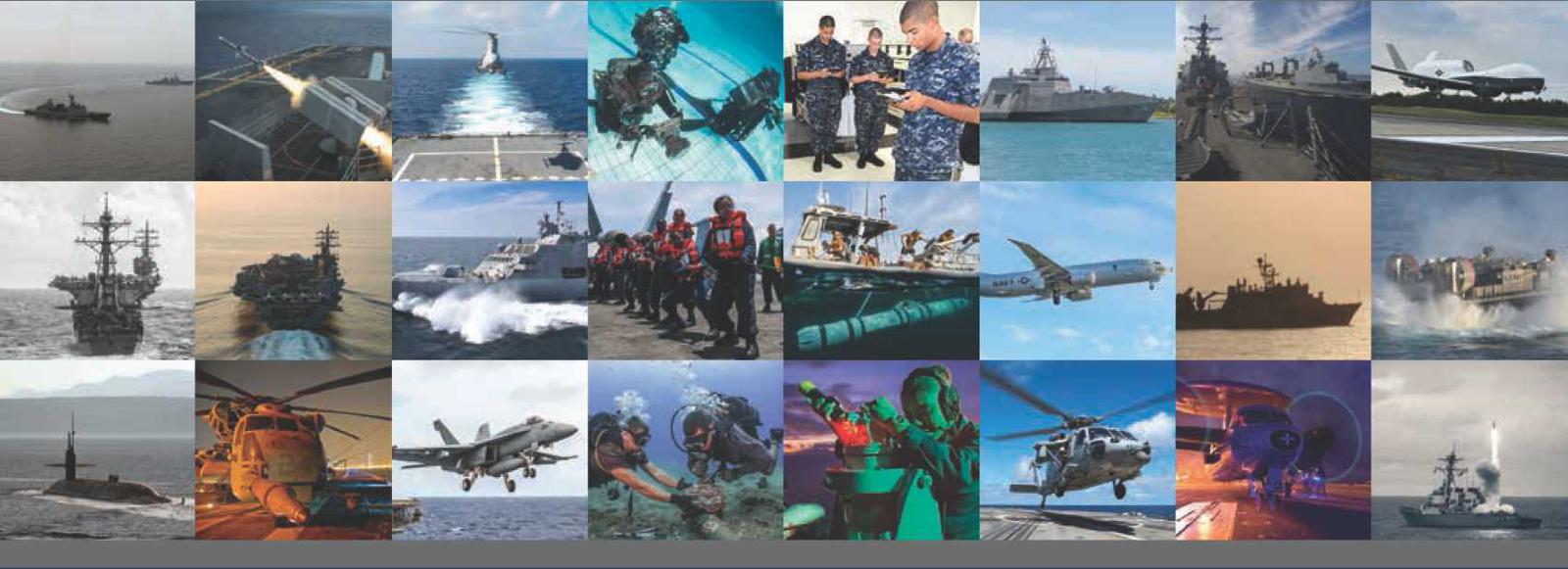
* * * * * * * * * * * *
Editor's Note: The work of government agencies included in this compilation is not subject to copyright protection.
The contents of the documents reproduced here are solely the responsibility of the originating government agency. We make no claims, promises or guarantees about the accuracy, completeness, or adequacy of the contents, and disclaim liability for errors and omissions. No federal agency bears any responsibility for formatting or other errors contained therein, and proceeds from the sale do not go to the government. Of course, no warranty of any kind is given with respect to the contents.